Home » Anchor Charts » What Is An Opinion Writing Anchor Chart And Where To Find One Online


What Is An Opinion Writing Anchor Chart And Where To Find One Online
Learning how to write academically can pose a challenge. Students need to get familiar with several types of writing, and it can be difficult to keep up with different formats and approaches for each writing style. Younger students especially struggle as they’re new to writing in general and need help with the basic concepts, such as paragraphs and transition words.
An anchor chart is there to help them visualize the information you present, and they can also use it as a reference point in the future. We’ll show you what an opinion writing anchor chart should consist of and where you can download high-quality, ready-to-use anchor charts for your class.
What Is an Opinion Anchor Chart
Unlike informational writing, which presents facts as they are, opinion writing is there to show the author’s point of view on a specific topic and to persuade the reader to agree.
An opinion anchor chart is a teaching tool that helps students get a visual representation of the writing format, as well as some of the writing concepts . The chart also serves as a reminder they can turn to when writing their essay.
A writing anchor chart can focus on different elements of writing, but you should always start with the ones that focus on the structure, such as:
- Introduction anchor chart
- Paragraph anchor chart
- Conclusion anchor chart
- Body paragraph anchor chart
Elements of a Good Opinion Writing Anchor Chart
How exactly would you create an opinion writing anchor chart? Well, again, much like opinion itself, that varies. How you do it depends on your students’ age and cognitive level. Even so, however, the basic anchor principles are the same. How far you go with them can be adapted to suit the grade level.
Differentiate between ‘fact’ and ‘opinion’
Fact and opinion are both important in writing a good opinion piece because they serve different purposes. Facts provide the foundation or support for an opinion. In contrast, opinions are the main idea or position the student tries to express.
It’s important to differentiate between the two so that students understand how to use them effectively in their writing. And, believe it or not, they often struggle to understand the difference.
For example, they may think a statement like “John thinks ice cream is the best food on earth” as an opinion, informing the reader of John’s attitude towards ice cream. However, the fact remains that John thinks ice cream is the best food on earth.
An opinion would be assuming that everyone should feel the same way. For example, “Ice cream is by far the best food on earth”.
An opinion piece without any facts to back it up is likely to be less convincing and less effective. Finding a middle ground between the two is important to write an effective opinion piece.
Show the differences between an opinion piece and a commentary
Students often confuse an opinion piece with a commentary. An opinion piece is a personal response to an issue – like a current event, a school or home rule, or even a new menu in the cafeteria. A commentary, on the other hand, is an unbiased analysis of an issue or topic. But, unlike an opinion piece, a commentary doesn’t offer the writer’s personal take on a subject.
You can illustrate this with a chart or table that shows the differences between opinion and commentary. For example, in the “Opinion” column, you might write, “Opinion is personal,” ; whereas in the “Commentary” column, you could write, “With commentary, it’s nothing personal” .
Show them how to organize their ideas with an essay outline
Create a simple visual representation of the framework – or essay outline. An opinion piece can’t be written off the bat. Students will need to construct an opinion piece. A standard essay outline lists the main points covered in the piece. So, first, pick a topic.
Alternatively, each student can pick their own topic, and you can all work on your anchor charts together. Next, create a mind map of the beginning, middle, and end of the “story” or opinion that needs to be put across: i.e., opening statement, argument, and conclusion.
Demonstrate persuasive writing
An opinion piece is written to persuade the reader to share the writer’s point of view on a topic. To write an opinion piece, you must develop the three key components from the previous point above a strong opening statement, an argument (or supporting paragraphs), and a concluding paragraph.
The first paragraph should grab readers’ attention and offer a detailed topic summary . The second paragraph should feature one or more supporting examples to help prove your point. The final section should conclude the topic and summarize the main points of your opinion piece.
Writing Hooks Anchor Chart From Sassy Savvy Simple Teaching
Opinion writing hooks anchor charts are the first charts you should introduce to your students when it comes to actual writing. Use charts to show them what a hook is and how they can use it to pull the reader in.
Since writing a hook can be difficult for students, try to provide them with colorful examples and leave empty spaces for them to fill out. This will help them get a visual aid of hooks and start their creative process.
You can have an anchor chart that focuses on one or all of the most common hook types:
- Interesting fact
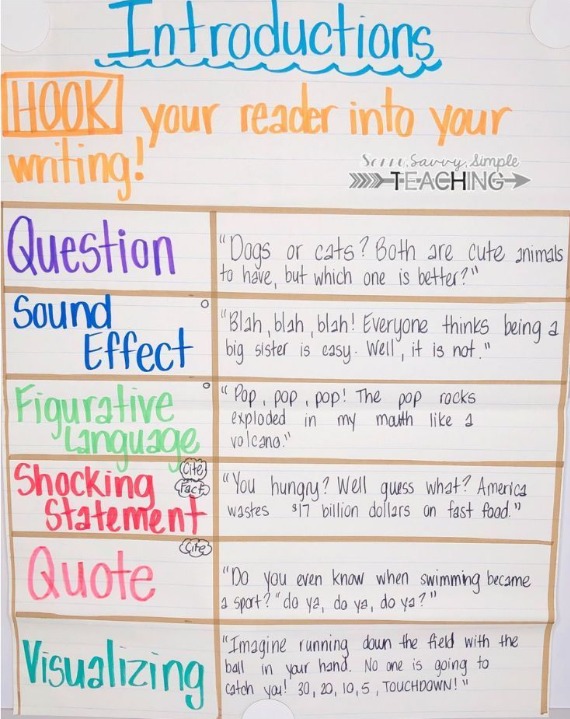
Opinion Transition Words Anchor Chart From Weebly
Show the students how they can link sentences and paragraphs together with transition words. This is a powerful tool that many students (especially younger ones) neglect, and they can get used to using it by having a chart by their side. This chart can help them come up with the appropriate transition word. As time goes by, using transition words will become more natural, and they won’t have to refer to the anchor chart every time.
You can use different designs here, depending on how you want them to use transition words. For example, you can use a stoplight design and give examples for three types of transition words:
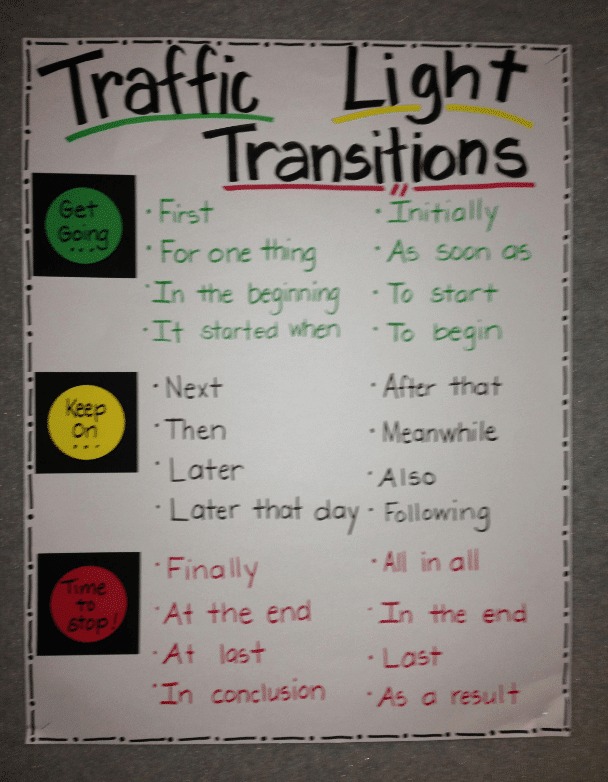
Opinion Reasons Anchor Charts—OREO From Our Global Classroom
Opinion Reasons anchor charts are great as they teach students about the structure of a good opinion writing piece. It shows how they’re supposed to present their thoughts and how to reinforce them with logic. Having a memorable acronym is only a bonus.
Use this chart to introduce the OREO formula and show students how to present their ideas. The formula is as follows:
- Opinion —Introduce your opinion about a given topic
- Reason —Provide information or logical explanations that support your opinion
- Examples —Give details and real-life scenarios that support your opinion
- Opinion —State your opinion again to affirm your point of view
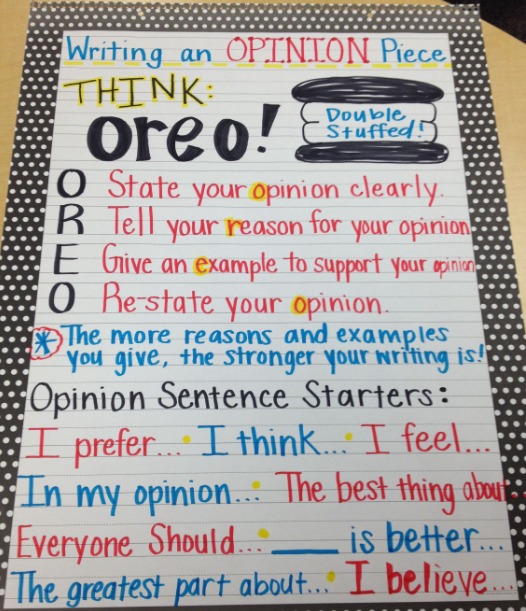
Download High-Quality Opinion Writing Anchor Charts From Teach Simple
While writing anchor charts can be straightforward, and you can even get your students to make them, they still need to be carefully thought out. How do you make sure you use all the necessary information and the easy-to-remember definitions? Planning an anchor chart can be difficult, and it can take you hours, especially if you’re new to it.
If you don’t have the time (or the will) to come up with your own for every class you plan, you can sign up for Teach Simple and find thousands of lesson plans , anchor charts, and other materials related to ELA and writing in particular.
Every product listed on Teach Simple is made by a teacher exclusively, and other teachers review each material to ensure it meets various standards and quality requirements. This way, you can rest assured you’ll enrich your classes with high-quality anchor charts made by people who know what it takes to teach students different types of writing.
Different ways to use anchor charts to teach opinion writing
Let’s look at how anchor charts can be used differently to highlight opinion writing.
Scaffolding From Lucky Little Learners
Students who are not proficient in each element of scaffolding writing can become overwhelmed quickly, so instruction in these elements is crucial. However, breaking them down into bite-sized portions will make them much more manageable.
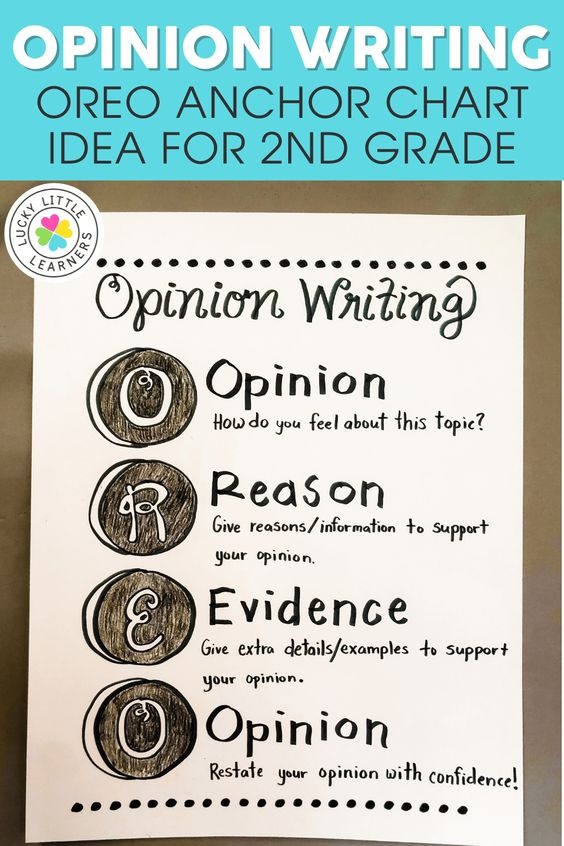
Fact Vs. Opinion sorting From Lucky Little Learners
Sorting facts and opinions is something that should be done in groups. What better way to get your students to express their opinions? And you can build the anchor chart together, making it far more relevant to the students. You could use many techniques to practice this skill with your team. For example, ask your students to jot down one thing they know about broccoli on a post-it note and stick it to the board. The students will typically write that it’s green, tasty, gross, healthy, and a vegetable. Once the notes are placed on the board, discuss whether a claim is a fact or an opinion and categorize it.
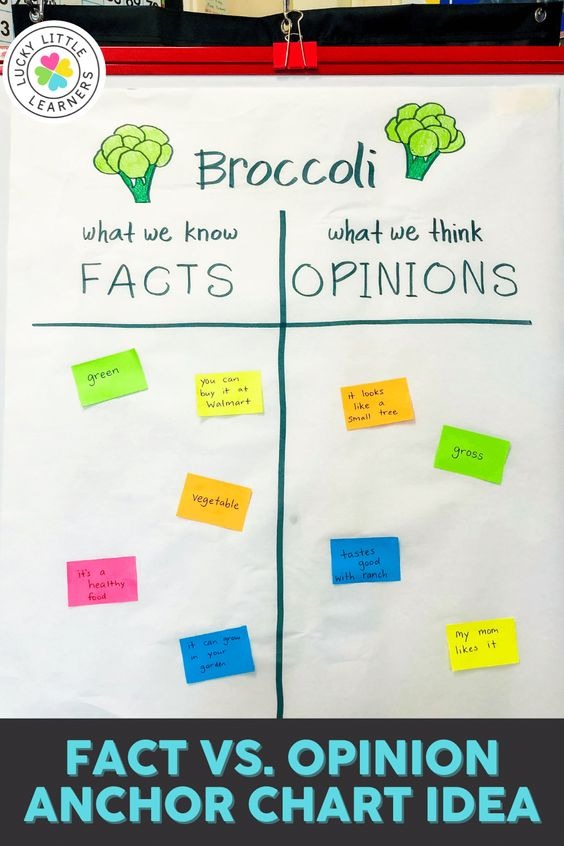
Display examples
It is essential to show students what various levels of mastery look like. Showing your students examples of completed writing can help them visualize expectations and encourage them to keep working and growing.
Model good opinion writing from Mrs. Winter’s Bliss
To illustrate how you would use a graphic organizer to plan your writing, model it for your students. At the beginning of your writing, introduce your perspective with a topic sentence. Next, list your supporting arguments. Finish with a final sentence that reiterates your viewpoint. As a group, identify the topic sentence, the supporting reasons, and the conclusion in your shared writing.
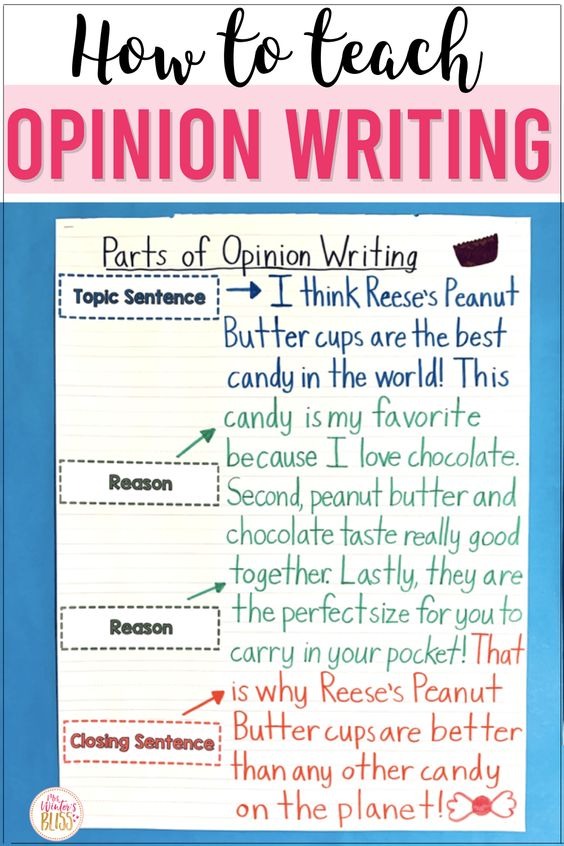
Opinion Essay Structure From Wild About Fifth
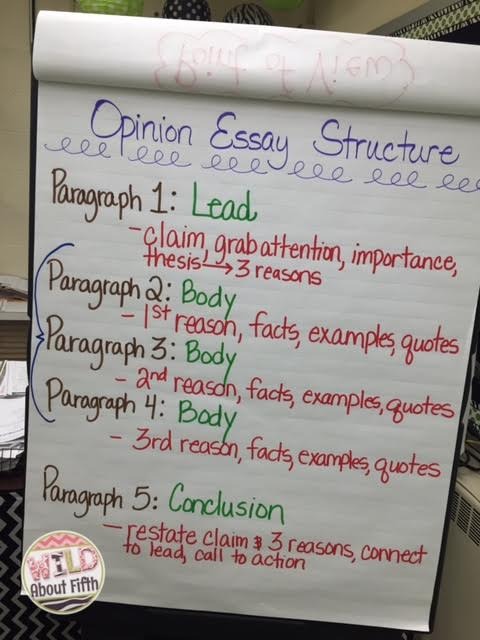
Opinion writing resources from Teach Simple
Looking for an opinion writing chart that covers all the bases? Here is everything you need. All these charts and resources support the elements you need to get started to ensure your students understand how to express their opinion in writing.
Opinion writing anchor chart By First in Line
These charts give students the O.R.E.O. acronym to remember and can be placed on a display board or in their notebooks.
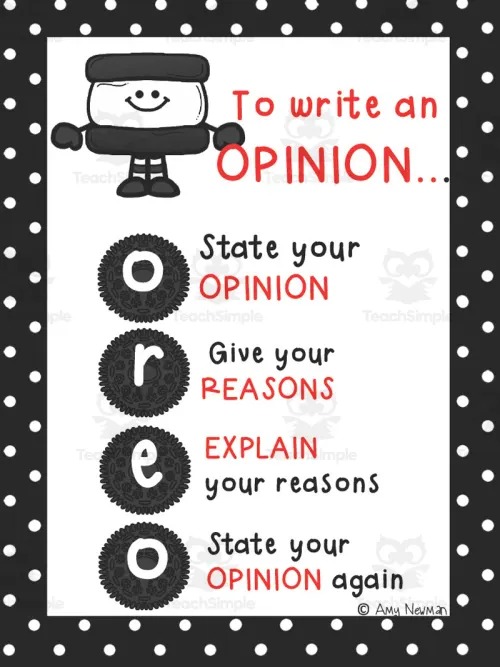
Digital graphic organizers By Teach Me This
This resource is jam-packed with digital opinion writing templates that will give your students multiple opportunities to practice this comprehension strategy.
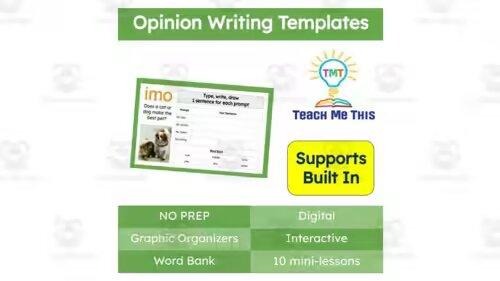
“What do you think?” opinion writing activity By Have Fun Teaching
This graphic organizer is perfect for younger students and guides them every step of the way.
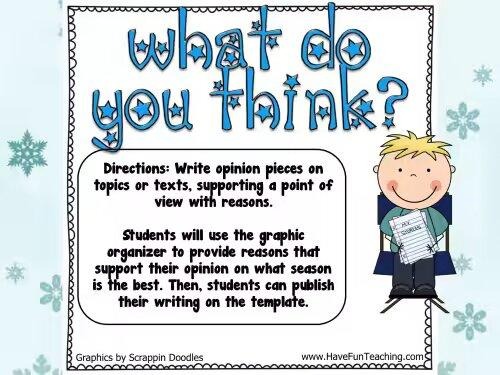
“Would you rather…?” By Aunt Minty’s Education Place
This resource is compiled with 20 high-interest opinion/persuasive writing activities designed for students in Grades K-3.
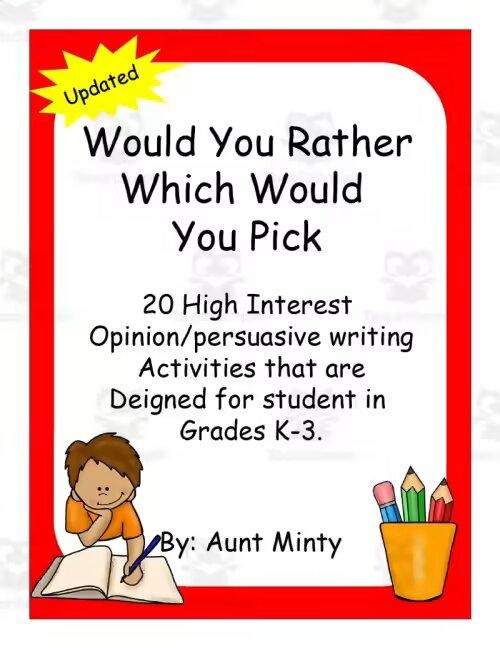
Opinion writing unit – analyze two accounts of the same topic
This resource lets students practice analyzing multiple versions of the same issue and integrating their learning into a complete opinion response.
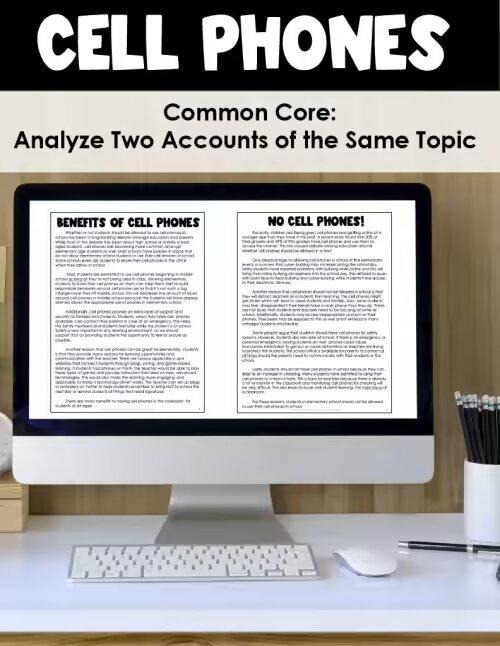
Opinion writing unit: paid for chores By Life Beyond the Gradebook
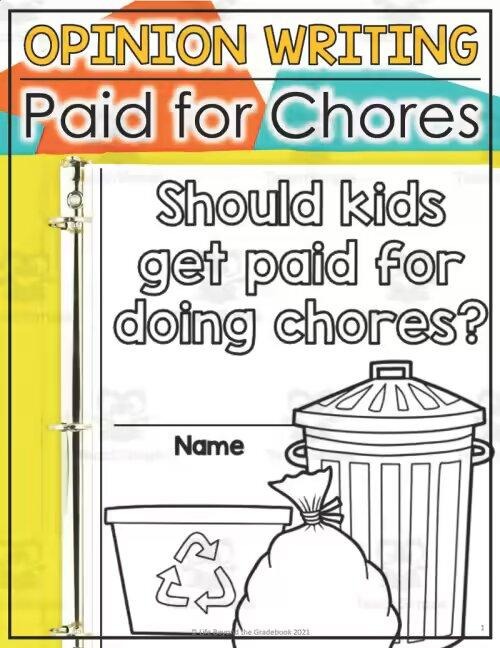
Two texts are included in this resource, one in support of the topic, and one against the topic. The students should use these texts to find evidence that supports their own opinion and use it in their essays.
Opinion writing Anchor Charts from Teachers
Opinion transitions from art of it.
Sentence starters and transition examples can ease students in and take some of the pressure off.
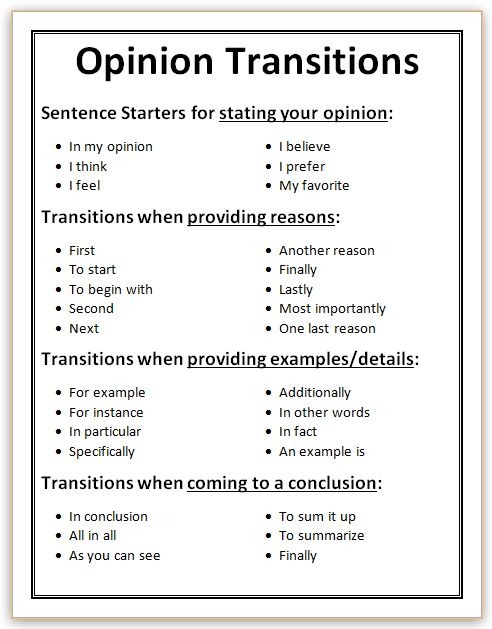
Opinion writing planner From Art Of It
This prewriting graphic organizer will guide students through their planning process.
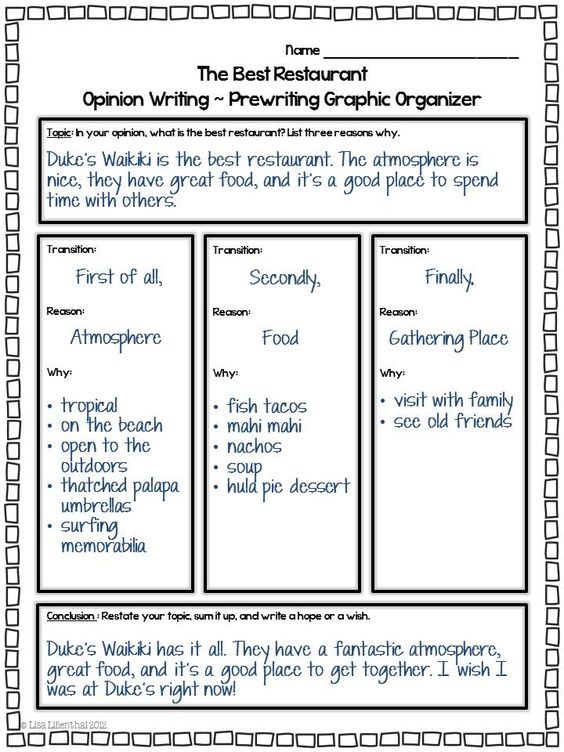
Opinion writing checklist From Worksheetplace
This checklist is great for helping students check their work to ensure they have covered everything.
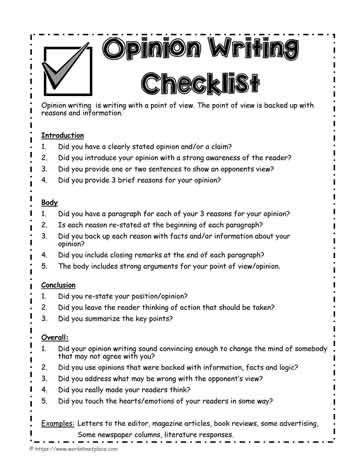
Having a wide variety of opinion anchor charts available can help break down a topic into smaller chunks and make it easier to understand. In addition, using visual aids like anchor charts helps make the lessons more memorable and engaging. Finally, when students need a confidence boost, they are usually grateful to have something to refer so they can move forward independently.
Check out our top pick for anchor charts for writing :
- Opinion Writing Anchor Chart
- Writing With a Purpose Anchor Chart
- Anchor Charts for Writing
- Appeal to Senses Anchor Chart
- Poetry Writing | Anchor Charts & Visuals
- Anchor Charts Professional Development
- Fact and Opinion Anchor Chart
- Idioms Anchor Chart
- Homophones Anchor Chart
- Writing a Beginning, Middle, and End
- Verbs Anchor Chart
- Nonfiction vs. Fiction Comparison Anchor Chart
- Teaching Plot Anchor Chart
- Author’s Claims Anchor Chart
Share Article:
Download unlimited teaching resources, join free today, teach simple.
The team behind Teach Simple is a small but dedicated group who are passionate about education and making a positive impact on the lives of teachers and students.
We have a lot of interesting articles and educational resources from a wide variety of authors and teaching professionals.
What Is A Theme Anchor Chart And Where To Get Them Online
Informational writing anchor charts—what types there are.
Last Updated on August 30, 2023 by Teach Simple

Anchor Charts to Improve Writing Skills
WHAT ARE ANCHOR CHARTS?
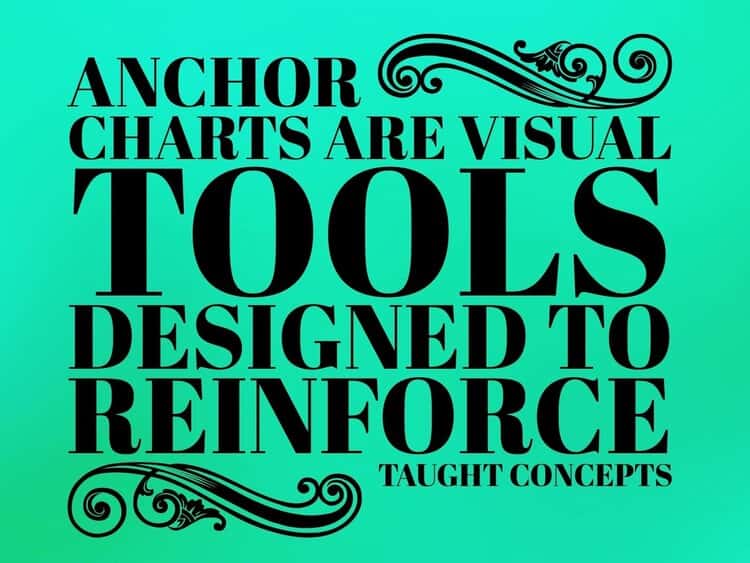
Anchor charts are tools that support learning in the classroom. They can be used to support everything from classroom management strategies to the teaching of writing.
Essentially, they are visual prompts that provide students with information regarding their prior learning on a given topic. These visual prompts are used to provide a scaffold to support the students during guided practice and independent work.
WHAT ARE THE BENEFITS OF ANCHOR CHARTS FOR WRITING AND READING?
Anchor charts are becoming increasingly popular in classrooms for some very good reasons. They offer a wealth of benefits for students and teachers alike.
Here are just a few of the great benefits of using anchor charts as writing tools in the classroom.
Anchor Charts Provide Increased Student Engagement
Anchor charts are an effective way of encouraging student engagement. Not only do they increase student confidence when engaged in a writing task, but they help to keep students on task by offering support in the form of visual prompts that help unstick the stuck! These anchor chart examples below provide students with a great visual point of reference to learn from.

101 DIGITAL & PRINT GRAPHIC ORGANIZERS FOR ALL CURRICULUM AREAS

Introduce your students to 21st-century learning with this GROWING BUNDLE OF 101 EDITABLE & PRINTABLE GRAPHIC ORGANIZERS. ✌ NO PREP REQUIRED!!! ✌ Go paperless, and let your students express their knowledge and creativity through the power of technology and collaboration inside and outside the classroom with ease.
Whilst you don’t have to have a 1:1 or BYOD classroom to benefit from this bundle, it has been purpose-built to deliver through platforms such as ✔ GOOGLE CLASSROOM, ✔ OFFICE 365, ✔ or any CLOUD-BASED LEARNING PLATFORM.
Anchor Charts Deepen Comprehension
Often, students get involved in the actual production of the anchor charts themselves. When helping to produce the anchor charts, students will have opportunities to reconstruct their learning and thereby deepen their comprehension of the material in the process.
As they construct their charts, students begin to make new connections between the various aspects of their learning as they organize these aspects in a visually comprehensible manner.
Anchor Charts Supports Independent Work
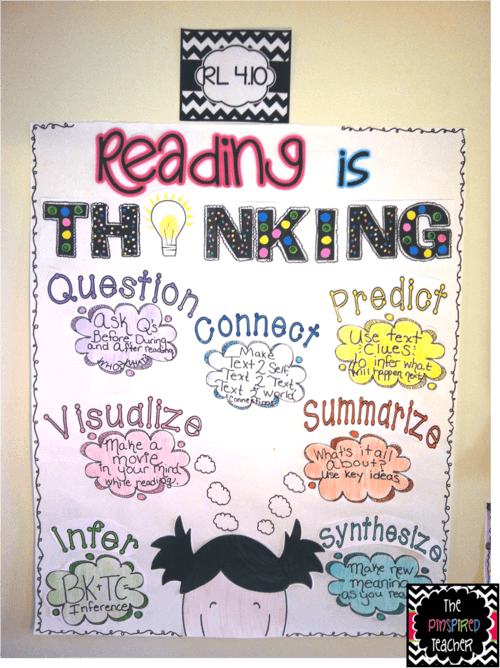
Learning to write well can be one of the most challenging things a student learns to do at school.
As students learn to navigate the demands of various writing genres , seemingly endless questions arise at word, sentence, and whole text level.
This, in turn, makes heavy demands on the teacher’s time as individual students struggle with the various challenges of a given task.
Fortunately, anchor charts can help alleviate some of that burden by providing a visual resource and reference point that help students to answer many of the more commonly asked questions for themselves. This frees up the teacher from having to repeatedly answer the same questions throughout the course of a lesson, making more time to offer support where it’s most needed.
WHAT DO ANCHOR CHARTS LOOK LIKE?

Anchor charts come in all shapes and sizes and can be commercially bought or produced collaboratively by students and teachers in class.
Commercially bought Anchor Charts are great for permanent displays within the classroom.
Usually well-presented in bold lettering using dynamic colors, professionally-produced charts work well for topics that recur throughout the course of the year and are complex enough to require ongoing reinforcement.
When anchor charts are self-produced, they are usually handwritten in large print and displayed in a prominent position in the classroom for easy reference.
Usually, a co-creation between the student and the teacher, the charts should contain only the essential information regarding the topic.
When deciding what to include on a chart, think about the concepts, strategies, and prior learning that will most help students to work independently when engaged in their work.
HOW ARE ANCHOR CHARTS CREATED IN THE CLASSROOM?
To produce an anchor chart in the classroom requires very little in the way of resources other than some chart paper and some colored markers. Other than these, and defining a clear purpose and focus for your anchor chart, there is no specific preparation required.
However, there are a number of common elements to consider when producing anchor charts for use in the classroom. Some of these include:
● Paper: Decide whether you are using adhesive paper, lined paper, blank paper, colored paper etc
● Font-Size: This should be large enough to see from the various working areas of the classroom
● Collaboration: Is it teacher-produced or a collaboration? What is the level of student involvement?
Where Anchor Charts are to be co-created with students, generally, they will be produced in collaboration with the students as you teach the lesson.
The chart will include the most important content and relevant strategies. In the case of the various writing genres, a list of the main criteria that must be included works well.
The anchor charts can then be used by the students as a checklist to refer to as the writing is produced. They can also serve for a final check when the work has been completed.
Here are some general tips to help ensure you get the most out of Anchor Charts in your classroom:
● Keep things simple
● Be sure the writing is well organised and easy to read
● Use headings and bullet points to help display the main points
● Use different colors for headings, bullet points etc
● Use simple pictures, graphs, illustrations etc to help reinforce points
● Don’t fill with lots of distracting details or graphics
Anchor Charts as Writing Tools – Examples

Anchor charts can be used very effectively to break down many of the more complex aspects of writing.
From punctuation use to the specific criteria for various writing genres, Anchor charts are a fantastic way to visually reinforce student understanding of these diverse processes.
The content of each chart will be dependent on their focus. But, let’s look at the possible content of two examples of Anchor Charts to help serve as models for what might be contained in an anchor chart produced in your classroom.
1. Point of View Anchor Chart
The Point of View Anchor Chart can be used both to help guide students in identifying the point of view in a text as well as to help in the creation of the student’s own texts. We have an excellent guide on point of view that can be found here.
Looking out for keywords is an effective way to determine the point of view in a piece of writing. Point-of-view keywords are generally centred around the pronouns and the level of insight and perspective we are offered.
Let’s look at some of the more common points of view used, first in a little detail and then at how they might appear on an Anchor Chart.
First Person – a character is telling the story (narrator), and we often gain insight into the characters’ thoughts. Clues that indicate a first person will be the use of pronouns such as I , my , me , mine , we , us etc.
As bullet points, this might look like this:
● First Person
○ Character narrates the story
○ Narrator is in the story
○ Narrator’s thoughts are revealed
○ Uses pronouns: I , my , me , mine , we , us etc.
Third Person Limited – the narrator is outside the story and telling the story. In third-person limited, the writer sticks closely to the point of view of a single character, so we are usually only privy to that one character’s thoughts and experiences. The narrator does not know everything about the events that occur in the story. Indications that the third person is being used may be the use of characters’ names and pronouns, such as he , him , his , himself , she, her , hers , herself , it , its , itself , they , them , their , theirs , and themselves .
● Third Person Limited
○ Narrator is outside the story
○ Narrator tells the story primarily from one character’s POV
○ Only the main character’s thoughts and feelings are revealed
○ Narrator has limited knowledge of events
○ Uses pronouns: he , him , his , himself , she, her , hers , herself , it , its , itself , they , them , their , theirs , and themselves .

Third Person Omniscient – the narrator tells the story and is privy to everything. Not only all the details of every event in the story, but the interior life of each character, such as emotions, opinions, and feelings, whether expressed or not. The usual third-person pronouns are used along with the character names.
● Third Person Omniscient
○ Narrator tells the story from ‘above.’
○ Narrator knows the thoughts and feelings of every character
○ Narrator knows everything that happens
2. Instructional Writing Anchor Chart
The criteria for writing clear instructions can be very handily displayed as an anchor chart.
When writing a set of instructions, students can refer to the chart to help organize their writing. The same chart will also serve as a checklist for self-assessment at the end.
An instructional writing anchor chart may include information such as:
Instructional Writing:
● Includes an explanatory title, e.g. ‘How to…’
● Laid out in bullet points or numbered instructions
● Uses time connectives to organise, e.g. ‘first’, ‘then’, ‘finally’ etc.
● Uses imperatives to instruct the reader
● Use straightforward, functional language
● Supported by illustrations or diagrams
● Diagrams and illustrations contain captions
In Conclusion
As we can see, anchor charts can serve as useful writing tools that support the development of student writing skills in the classroom.
When displayed prominently in the classroom, they can help students efficiently bridge the gap between being emergent writers lacking in self-confidence to becoming self-assured, independent writers.
It is important to remember, too, that though anchor charts are great tools that support students, ultimately, the intent is for the students to internalize the knowledge and information they contain. So don’t allow them to become a permanent crutch!
USEFUL VIDEOS TO EXPLAIN ANCHOR CHARTS
Other great articles related to anchor charts for writing.

13 Literary Devices to Supercharge your Writing Skills

The Writing Process
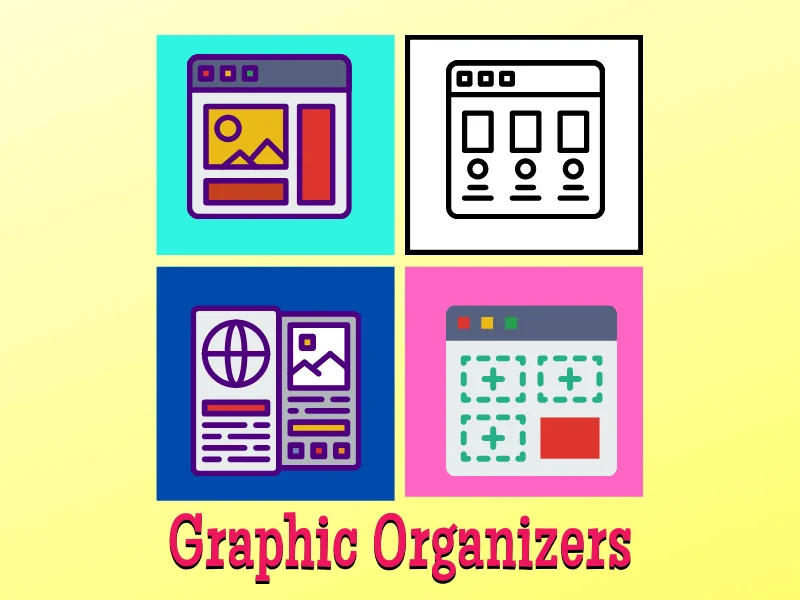
Graphic Organizers for Writing and Reading
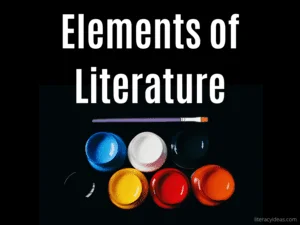
Elements of Literature

Multiliteracies
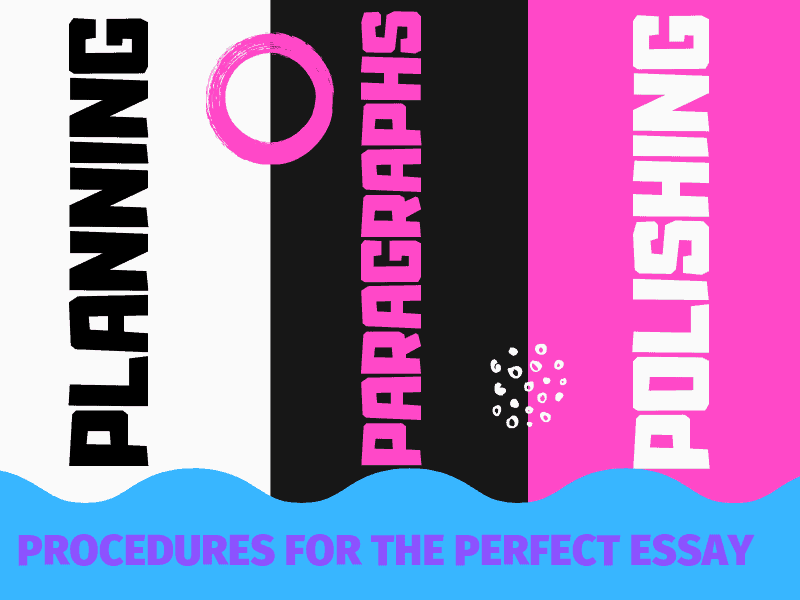
Essay Writing: A complete guide for students and teachers
Trending Post : 12 Powerful Discussion Strategies to Engage Students
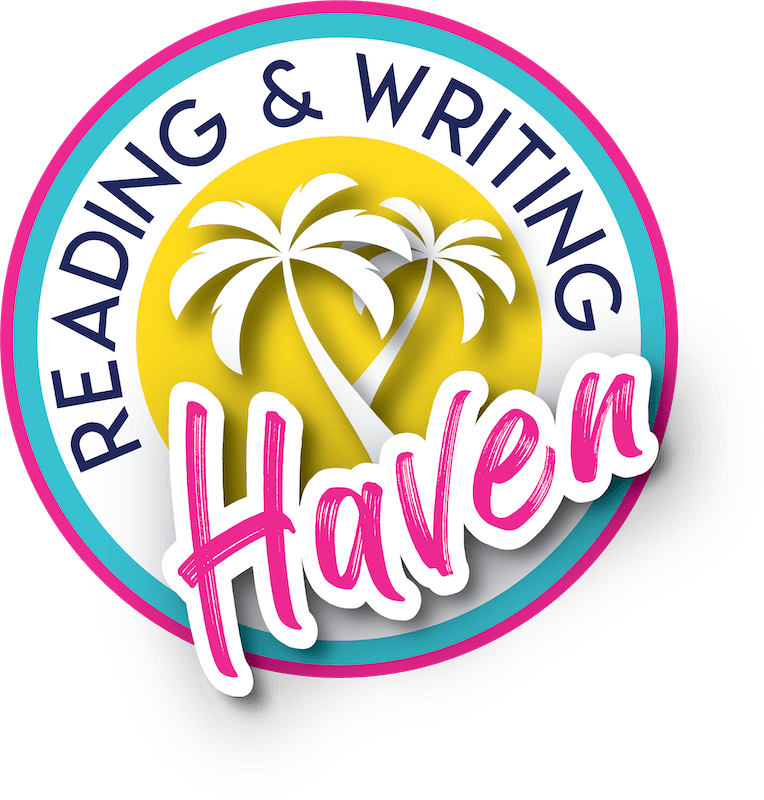
Using Anchor Charts in Middle and High School: Why and How
For the longest time, I thought anchor charts were for elementary classrooms. I’d see photos floating around on social media, but I never gave them a second thought in terms of application in a middle or high school classroom. I know I wasn’t alone, as it’s somewhat rare for secondary teachers to talk about using them.
More recently, I’ve come to realize that anchor charts are absolutely appropriate – and beneficial – for a secondary classroom. Let’s explore why we should and how we could be using them.
THE BENEFITS OF ANCHOR CHARTS
Most teachers incorporate mini (or maxi) lessons on a regular basis. As students learn new information, anchor charts are a way to help them ground their learning. Because of the way we create them (more on that later), they help students to synthesize their thinking about an important topic or skill.
Generally, we use anchor charts for information students will need to come back to throughout the year. Often, anchor charts are used with essential standard concepts and related strategies.
With reading, for example, you might create anchor charts for signposts, reading strategies, or text structure. Perhaps you want students to remember sentence types, transitions, or word choice concepts with writing and grammar. You can also create anchor charts for classroom procedures and reading and writing workshop expectations, among a plethora of other options.
Creating anchor charts provides a content-rich classroom decoration piece which serves as a bridge between introductory lessons and practice opportunities. When students use them as a reference, they are reminded of prior learning and can more easily make connections with new information.
Students who appreciate scaffolding, ELL students, and anyone who is learning a brand new concept can benefit from anchor charts.
Bottom line: Anchor charts make learning visible.
TIPS FOR USING ANCHOR CHARTS
The benefits of using anchor charts are clear, but actually implementing them can be more of a gray area. When I first began exploring them, I had a lot of questions. Perhaps you do, too. I’m happy to share my learning.
WHEN TO CREATE THEM
Ideally, anchor charts should be created with students. They need to contribute to the synthesis of information. As you teach your lesson, you can pause and add important information, like definitions, questions students should ask, strategies, and images or symbols.
However, secondary classrooms are fast-paced. Our building only has 44 minute class periods. With tight schedules like these, it’s difficult to stick to idealism. It’s best to create anchor charts with students, but we have to prioritize.
If you’re crunched for time, it’s understandable to create the anchor chart…or an outline for one…in advance. However, I’d suggest still providing opportunities for students to think about what should be included. Otherwise, they’re really more of a poster.
For example, instead of pausing throughout the lesson to add to an anchor chart, which does take time, ask students to create their own version – inspired by yours – afterward. This opportunity allows them to do some critical thinking without extending the mini lesson.
However, I wouldn’t recommend that creating anchor charts in advance be the norm.
MULTIPLE CLASS DILEMMA
In our building, teachers have six sections of the same grade level class. That’s a lot of expensive paper! Plus, what will you do with six very similar anchor charts?
To problem solve, you might design the reference tool on the white board. At the end of each period, take a picture of that class’s creation. Then, combine the best, most memorable elements from each class into one reference chart at the end of the day. This approach is helpful because you can use it to review with students and discuss ideas from other class periods.
Another option is to have students create mini anchor charts that they can keep in their folders, binders, or notebooks. This activity can be spun in many ways. For instance, students can work with groups to encourage critical thinking and discussion.
REUSING THEM FROM YEAR TO YEAR
After all the effort it takes to create them, it can be difficult to fathom only using them during one school year. Anchor charts generally aren’t “reused” year to year. However, they can carry over in a couple ways.
First, you’ll begin to notice patterns. After you get comfortable with creating an anchor chart for a given topic, you’ll know what works and what doesn’t. You’ll have an idea of what must be included because it resonates with students. In other words, by creating and recreating each year, the process will go more smoothly each time.
Also, take photos! When you have anchor charts you love, take photos of them so that you can share them with students as additional references. Sure, if you have room to store them, it doesn’t hurt. But, pulling them out of a closet and using them over and over again undercuts some of the most important learning benefits for students.
MAKING THEM APPEAL TO OLDER STUDENTS
Do anchor charts appeal to older students? Honestly, involving middle and high school students in the process of creating them is an effective way to increase engagement. When they are involved in their learning, the lesson naturally appeals more to them.
Some anchor charts are clearly designed for younger students. Paying attention to color palettes, depth of skills and strategies, and illustrations can help make anchor charts appear more “secondary” style.
If you include people, make them look older! If you include objects, choose things that are relatable to teens whenever possible. And, use examples that are relevant to tweens and teens.
Consider allowing students to add specific elements to the anchor chart during the lesson to magnify ownership.
PRIORITIZING WHICH CHARTS TO CREATE
While anchor charts are beneficial teaching tools, it’s important not to overuse them. If you create an anchor chart for every lesson, where would you put them all? Here are some helpful questions to guide your decisions:
- Is this topic/skill related to an essential or power standard for my class?
- Is this topic/skill something that students tend to struggle with each year?
- Will we be coming back to this topic or skill regularly throughout the year?
- Am I going to want students to connect new learning to this topic or skill?
- Will this anchor chart help my classroom to run more smoothly?
MATERIALS FOR CREATION
When creating anchor charts, teachers have different preferences. One thing to consider is how you want to hang them. Will you attach them with binder clips to string? Will you stick them to the wall? I prefer large Post-It easel pads *, but a lot of teachers use chart paper .
Either way, my favorite markers to use are these and these . I like to have different tip sizes to work with.
BUT I’M NOT ARTSY
Whether you have Pinterest-worthy anchor charts hanging in your classroom or not is of no consequence. You don’t have to have pretty handwriting or amazing illustration skills to create meaningful reference points with your students.
Look! Here is an example of a “non-pretty” anchor chart I made with a co-worker as we were introducing writing workshop expectations.
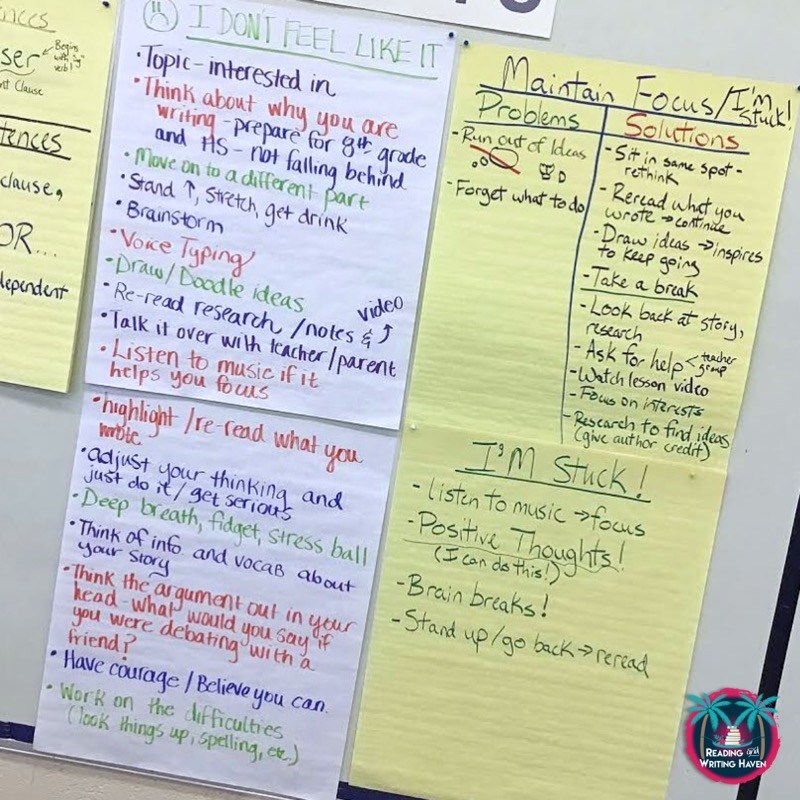
Students can read these anchor charts. They contain valuable information the class refer back to throughout the year, and it will help the room run more smoothly.
If you happen to have handwriting that is illegible, that would be a problem. In this case, you could have a student scribe the anchor chart for you as you teach the lesson.
What thoughts do you have about creating anchor charts? They’re not just for elementary classrooms. Share any questions or tips you have to offer in the comments below.
+ The materials linked in this post are Amazon affiliate links. If you purchase from them, I will receive a small profit at no expense to you.
RELATED READING
- Executive Functioning Skills for High School Transition
- How to Teach Note-taking Skills
- How to Structure an ELA Class
- Instructional Scaffolding Approaches for Secondary
You may also enjoy...
In my middle school classroom, I’ll start the anchor chart with the title and then add what the students say on large Post It notes to stick on. Then, I’m able to take off those post it’s for my next classes. At the end of the day, I create the chart with all of the information from my students throughout the day.
I love that approach for synthesizing content from multiple classes. Thanks for sharing, Jackie!
Comments are closed.
Get the latest in your inbox!
- Grades 6-12
- School Leaders
FREE Poetry Worksheet Bundle! Perfect for National Poetry Month.
40 Must-Have Anchor Charts for Teaching Writing of All Kinds
Writing information and inspiration for all!
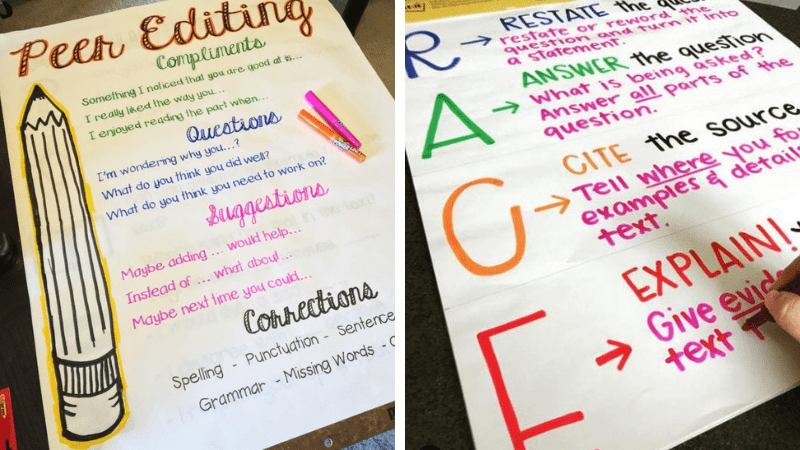
When it comes to writing, many kids struggle to get their ideas down on paper. That’s why we’ve rounded up all the best writing anchor charts, to help your students master narrative, transitions, punctuation, editing, theme, and so much more! Try some of these ideas in your classroom to give your kids the writing support they need.
1. Why Writers Write
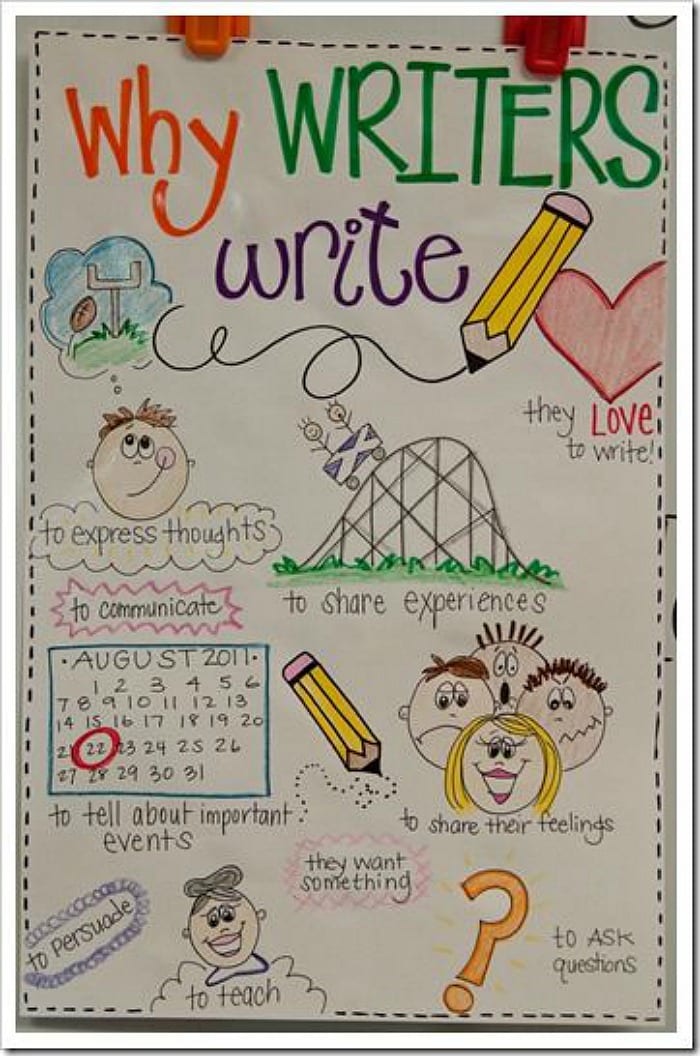
First and second graders will draw inspiration from this fun-filled anchor chart about why we write. Make this chart applicable to older students by expanding on each aspect with a specific audience or goal. “To share experiences” can become “to share experiences with friends, in a postcard, or with readers of a memoir.”
Source: Cara Carroll
2. Expanding Sentences
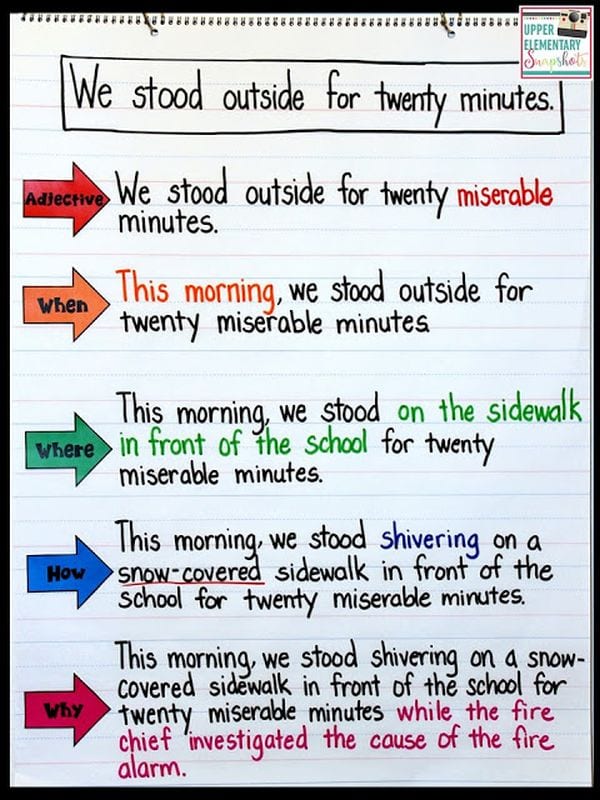
Show students how a simple sentence can become a real powerhouse by exploring when, where, how, and why, along with adding adjectives. So powerful!
Source: Upper Elementary Snapshots/Expanding Sentences
3. Personal Narrative
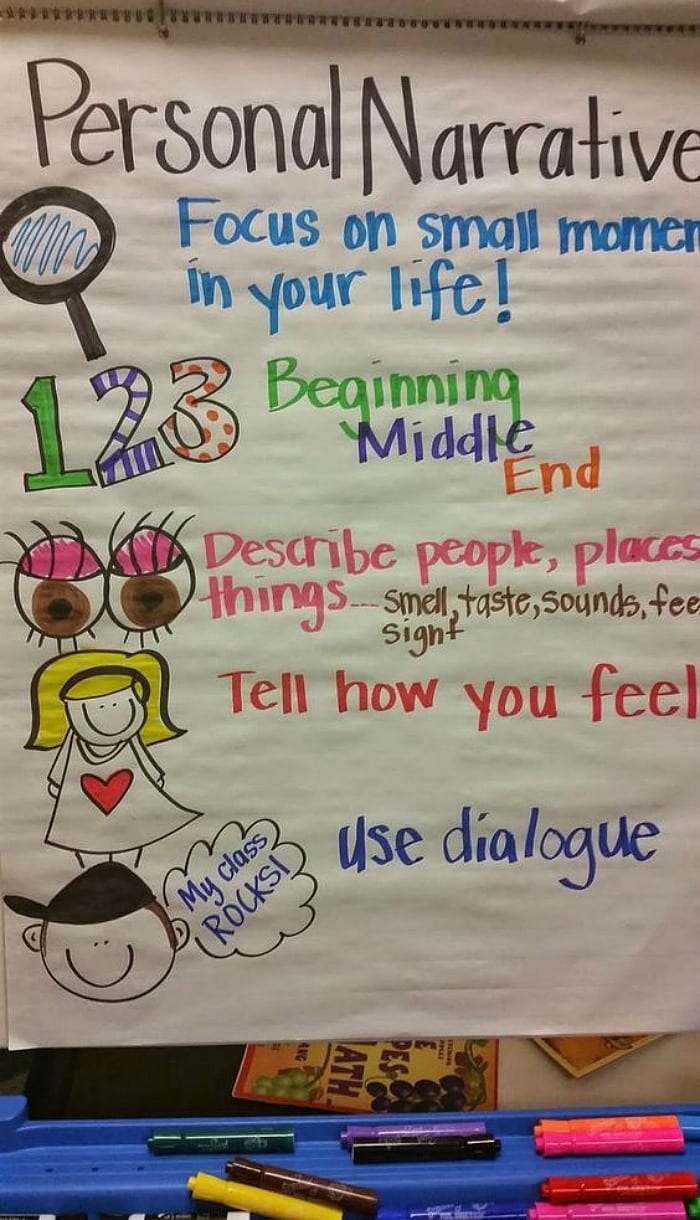
Personal narrative is a style that all students practice in elementary school, and writing anchor charts can help keep them on track. Visit the link below for great worksheets to use with your students to prepare them to write their personal narratives.
Source: Rachel’s Reflections
4. Hook Your Reader
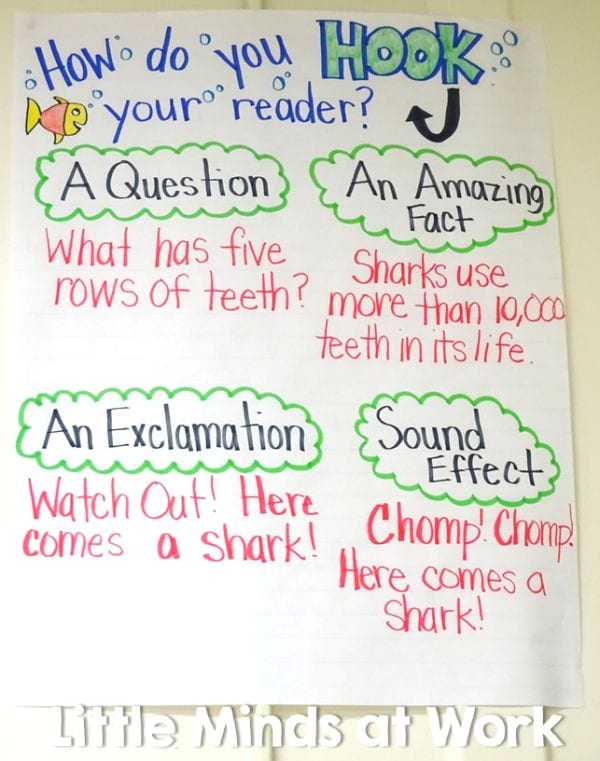
Want to know how to draw the reader in and make them eager to continue? You need a hook! Teach students how to grab a reader’s attention from the get-go, pulling them in with facts, questions, or even sound effects.
Source: Little Minds at Work
5. Point of View

Learn the differences between first person (I), second person (you), and third person (narrator), and talk about when each type is effective.
Source: Oh Boy … It’s Farley!
6. Organized Paragraph
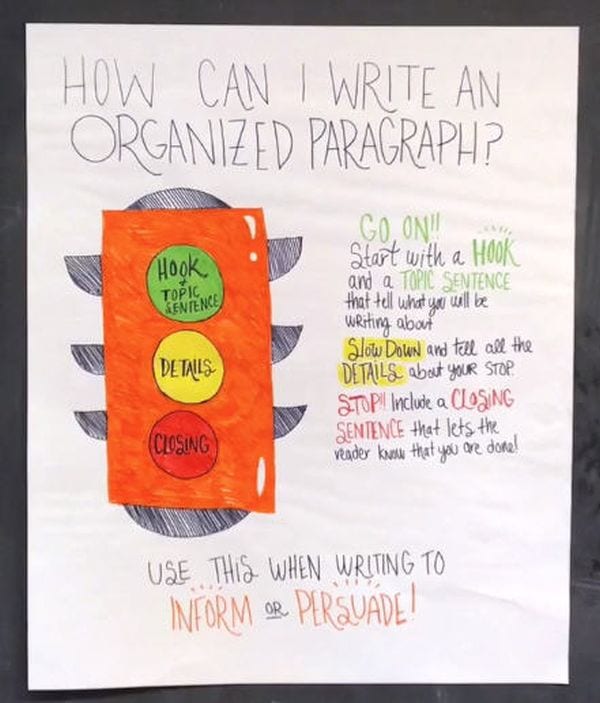
Use a stoplight to help early elementary students understand and write clear paragraphs. As students are editing their work, have them read with green, yellow, and red pencils in hand so they can see how their paragraphs are hooking and engaging readers. See a video of this chart in action here.
7. Practicing Transitions
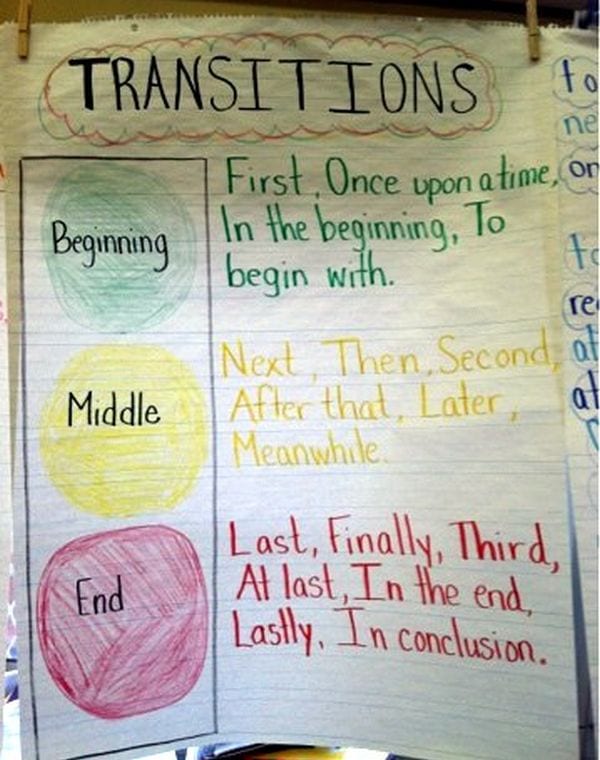
There are more stoplight writing anchor charts, and this one is perfect for helping students learn and practice their transition words. Draw the stoplight first and invite students to help come up with different words. Then encourage students to put the transition words into practice.
Source: A Happy, Hungry, Healthy Girl
8. Author’s Perspective
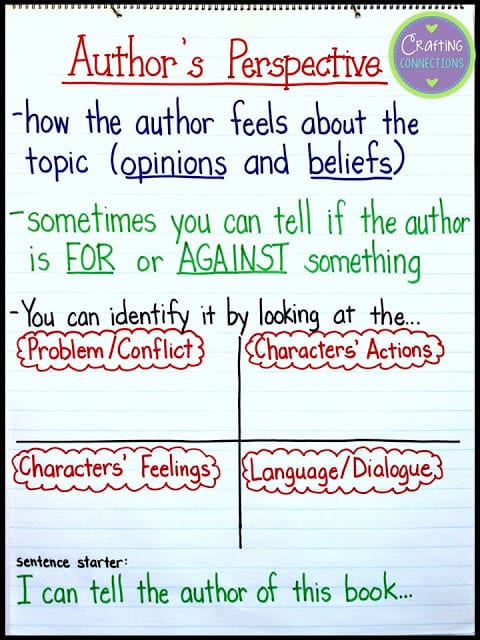
Sometimes, an author’s opinion comes out strongly in their writing, even if they don’t state it up front. Use this chart to help students find the clues to an author’s perspective.
Source: Crafting Connections/Author’s Perspective
9. Author’s Purpose Pie
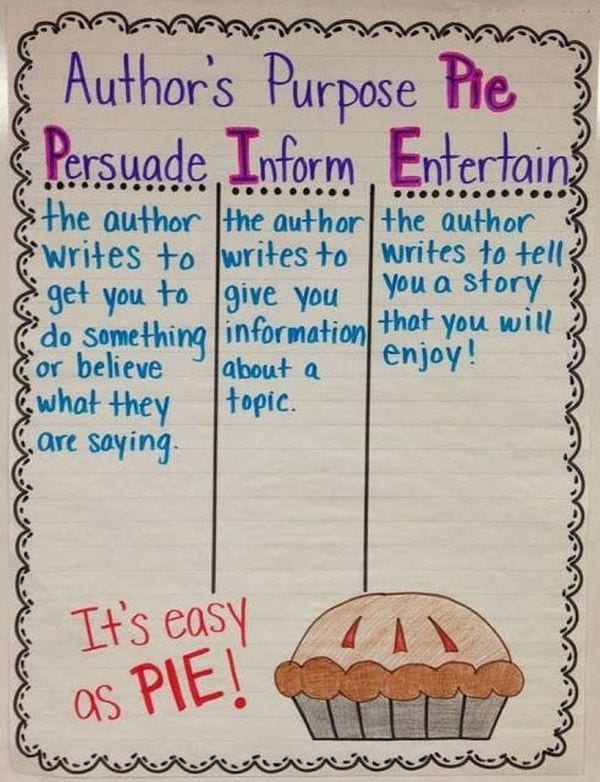
This is a quick and easy anchor chart to help students see different types of writing. It’ll also help them do a quick check to make sure their writing aligns.
Source: Literacy Ideas
10. Dig Deeper
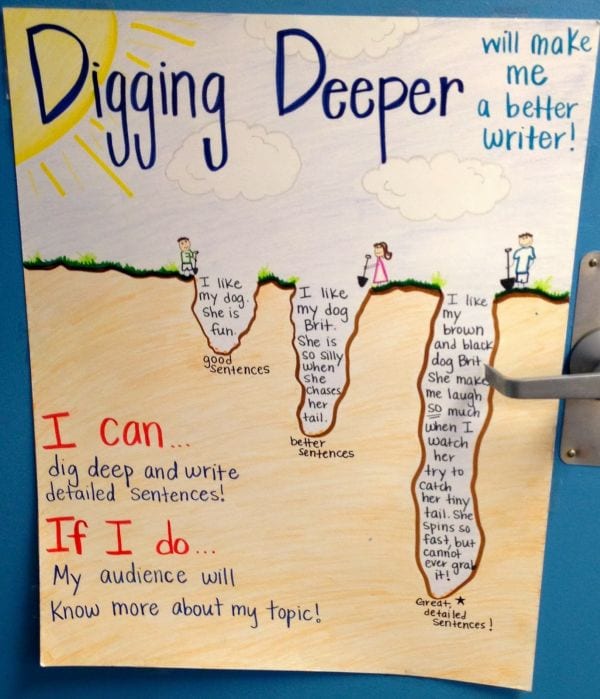
Keep going! Sometimes it’s hard to express what you mean by certain writing and revision requests, and writing anchor charts can show exactly what you mean. Now students can get a good look at what it means to dig deeper.
Source: Pinterest
11. Alternatives to “Said”
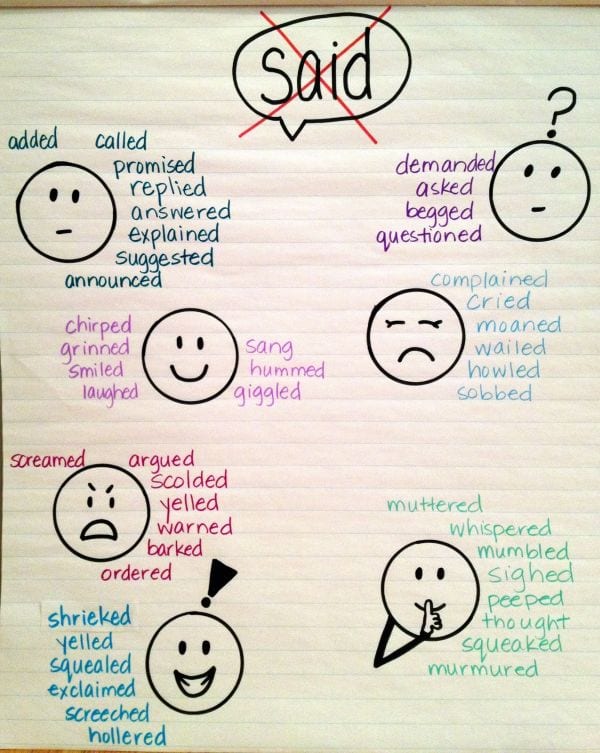
If your students are learning about writing dialogue, an anchor chart like this could really come in handy. Encourage students to try other ways to have their characters respond.
Source: ESL Amplified
12. Understanding Character
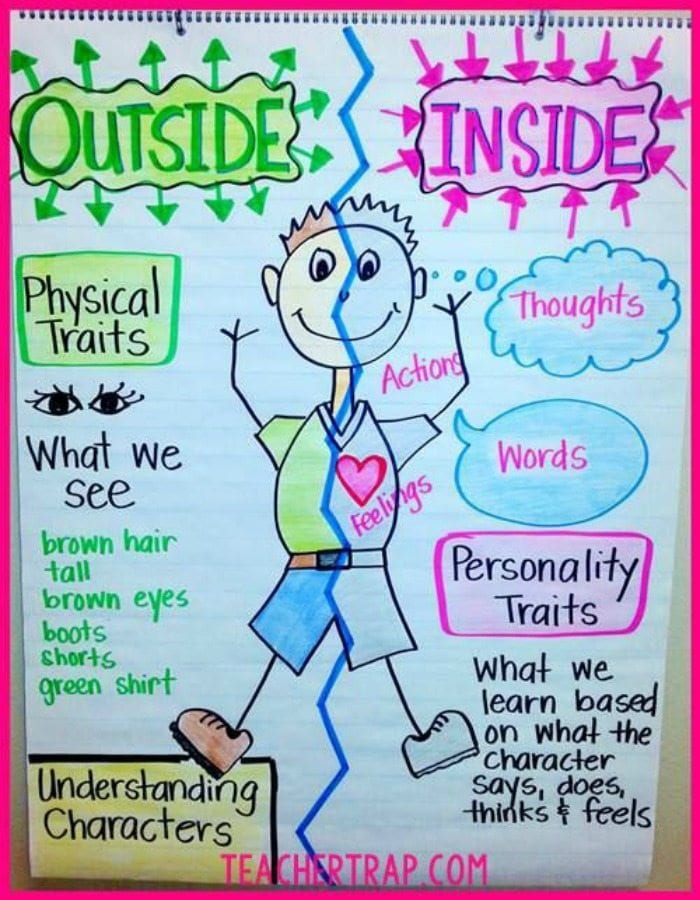
Before you can write about character, you first have to understand it. This anchor chart will help your young writers understand the difference between inside and outside characteristics.
Source: Teacher Trap
13. Diving Deeper Into Character
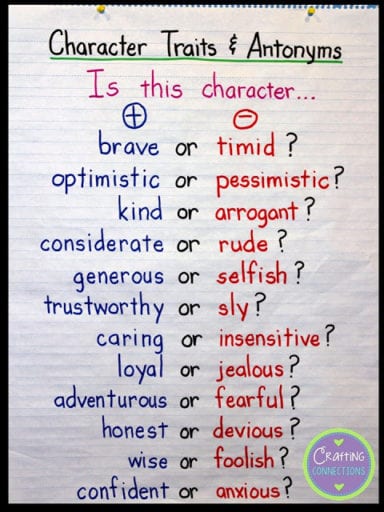
Now that your students understand the difference between inside and outside characteristics, dive deeper into describing a specific character. This anchor chart is a wonderful idea because students can write their idea(s) on a sticky note and then add it.
Source: Crafting Connections/Teach and Task Lessons
14. Six Traits of Writing
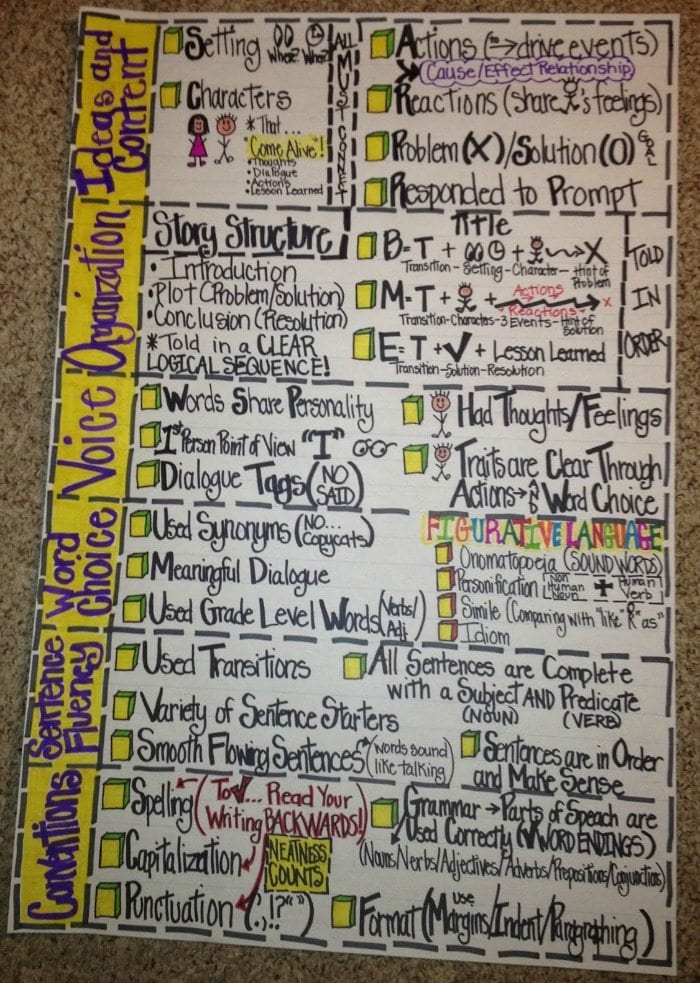
This anchor chart is jam-packed with things to help fourth- and fifth-grade writers remember the six traits of writing. Use the chart as a whole-class reference or laminate it to use in small groups. When it’s laminated, students can check off each aspect they’ve included in their own writing. Meaningful dialogue? Check! Problem and solution? Check!
Source: Working 4 the Classroom
15. Writing Realistic Fiction
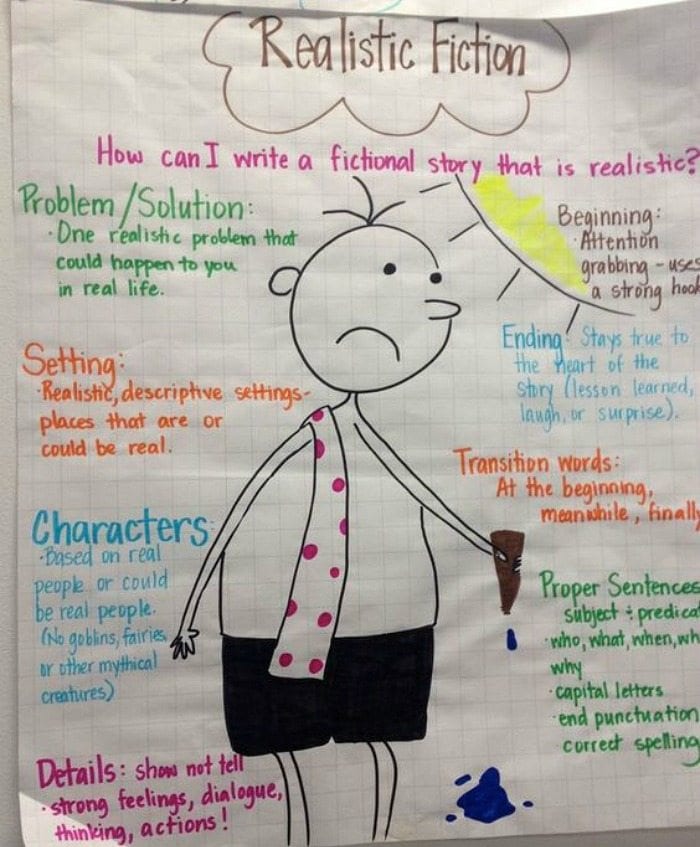
This anchor chart reminds upper elementary students how to create realistic stories. It really walks your students through the process, so they have all the elements they need to create their own stories.
Source: Two Writing Teachers/Realistic Fiction
16. Sequence of Events
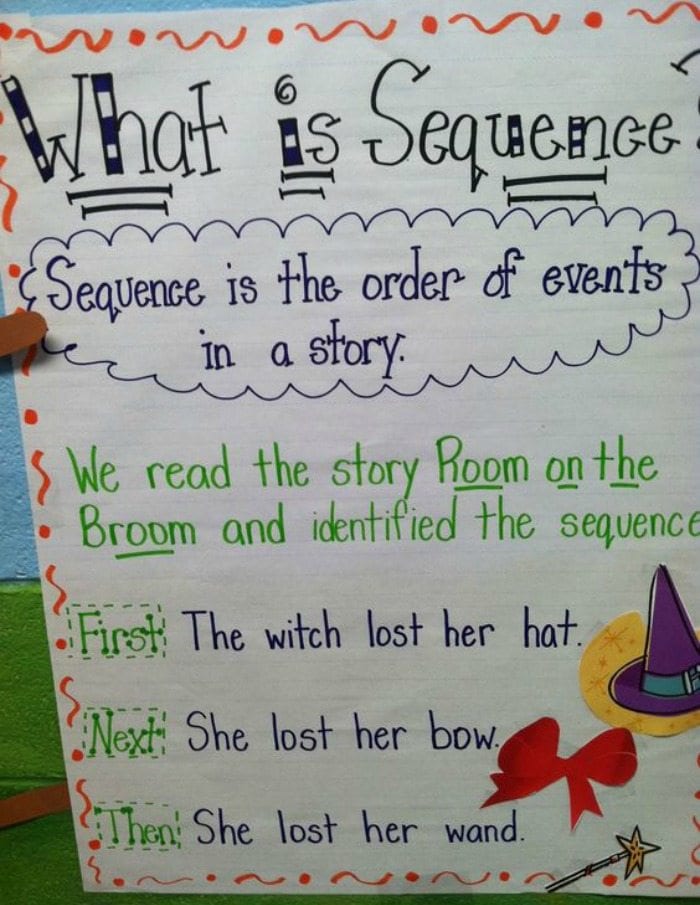
Help early elementary students stay organized with an anchor chart that’s focused on order-of-events language. Tactile learners can write their first drafts on sentence strips and use this format to put the events in order before they transcribe their work onto writing paper.
Source: Life in First Grade
17. Informational Text Structures
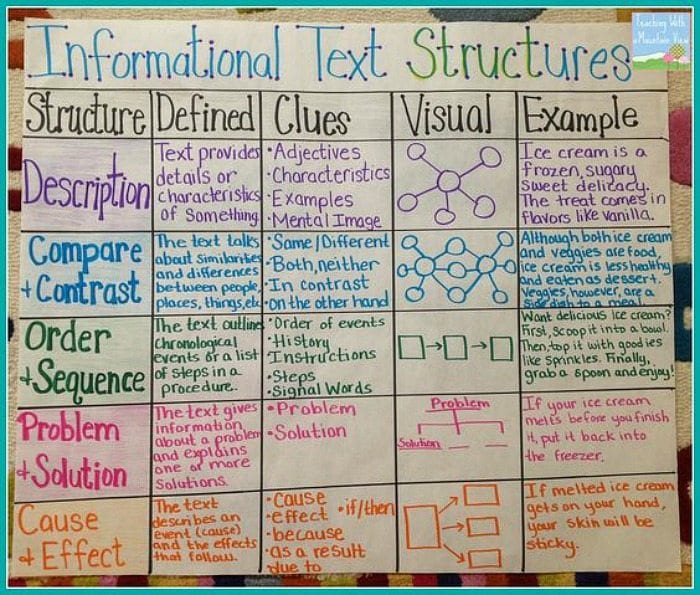
Focus upper elementary students on the most important aspects of informational writing while keeping them organized. This chart could be used to support paragraph writing or essays.
Source: Teaching With a Mountain View/Informational Text Structures
18. OREO Opinion Writing
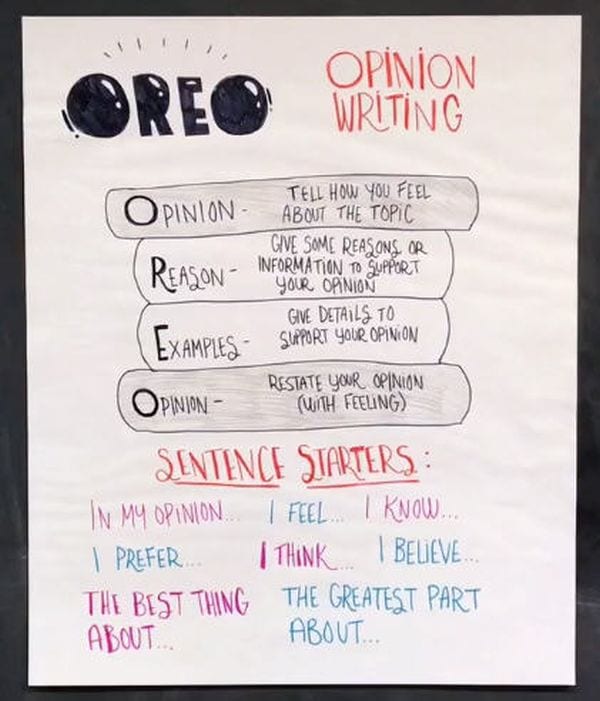
This deliciously inspired opinion anchor chart can be used by students in grades 3–5 during writers workshop or when developing an opinion for discussion or debate. To build out student writing, have them “double-stuff” their OREOs with extra E examples. See a video featuring this chart here.
19. Features of a Great Report

Use examples of outstanding student work to make this anchor chart. Keep it relevant by updating the examples with student work throughout the year. In kindergarten, this will also showcase how students move from prewriting and pictures to writing words and sentences.
Source: Joyful Learning in KC
20. Write From the Heart
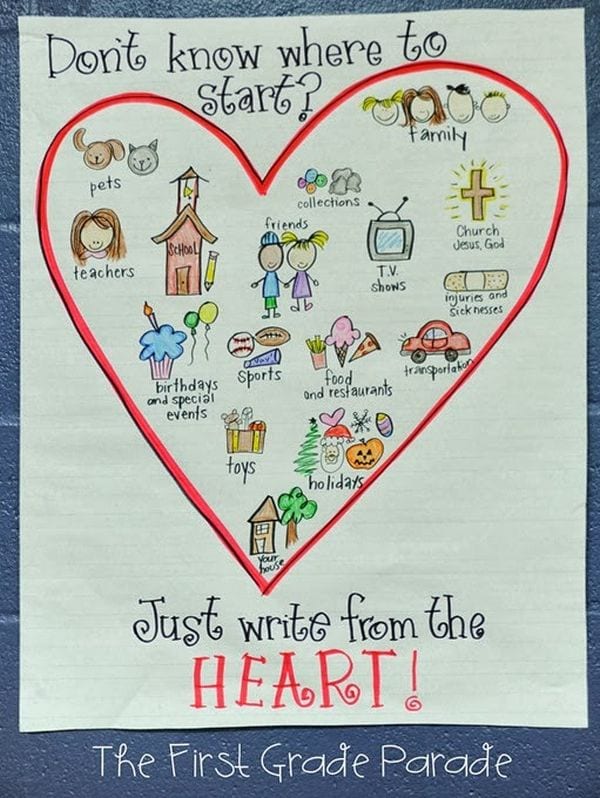
Sometimes the hardest part about writing is coming up with whom and what you should write about. This is the fun part, though! Use this anchor chart to remind your students that they have lots of good writing options.
Source: First Grade Parade via Cara Carroll
21. Argument Writing
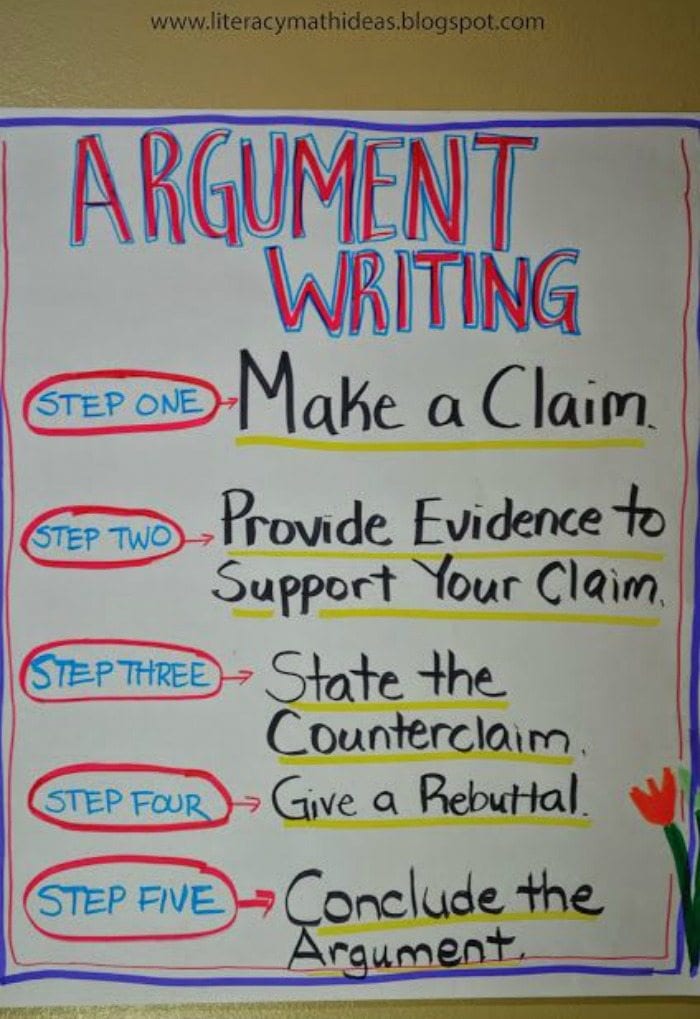
Use this anchor chart with middle schoolers to make sure they’re considering all sides of an argument, not just the one that matters the most to them. One way to adapt this chart, as students develop their understanding of argument, is to write each element—claim, argument, evidence—under a flap that students can lift if they need a reminder.
Source: Literacy & Math Ideas
22. Writing Process
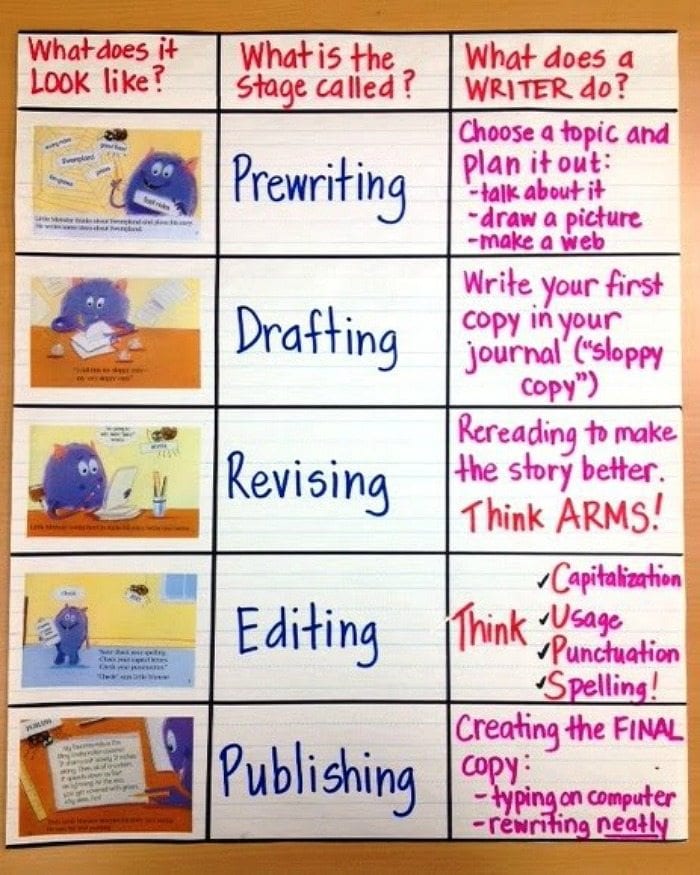
This is an anchor chart you’ll direct your students to again and again. The writing process has several steps, and it’s good to remind students of this so they don’t get frustrated.
Source: What’s Skow-ing On in Fourth Grade?
23. Writing Checklist
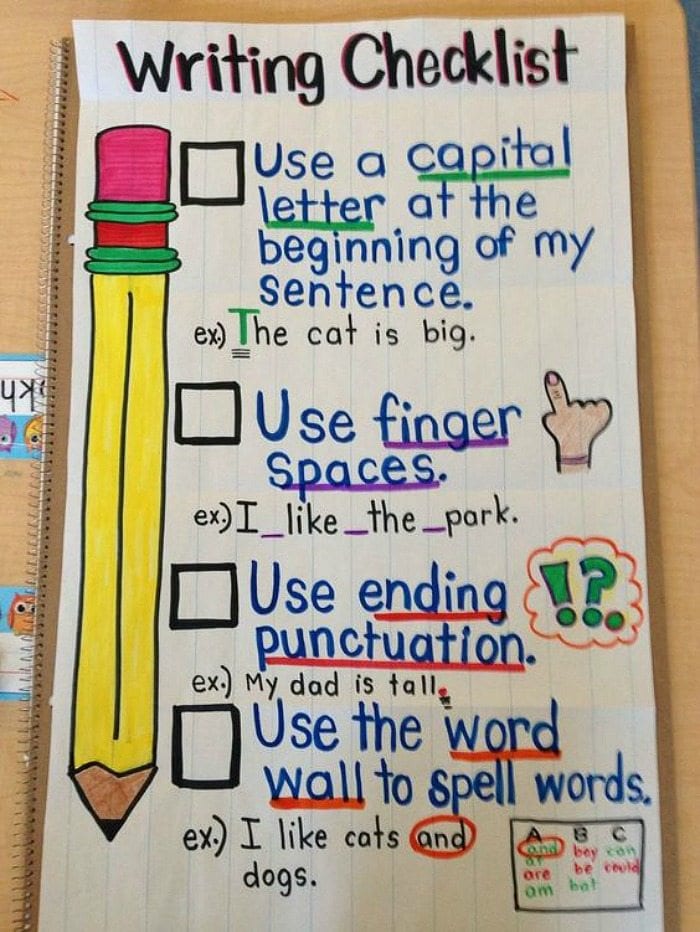
For those young writers in your class, these cover the basics in a clear way.
Source: Kindergarten Chaos
24. RACE for Writing
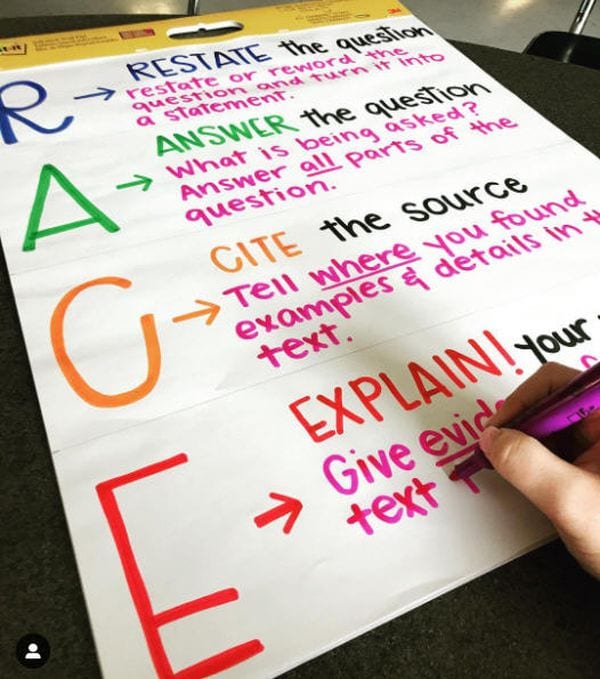
Use the RACE mnemonic when your students are working on persuasive writing. It reminds them to cite their sources and be sure to answer the question being asked.
Source: @mrspuffer
25. Cause and Effect
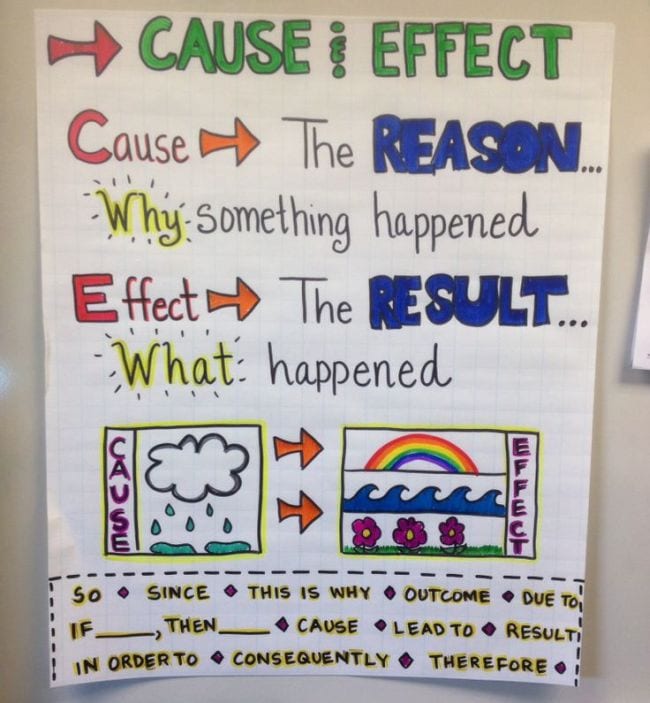
Cause and effect will always be an essential part of any story. Help your students come up with different scenarios for cause and effect. In many instances, you could have multiples effects, so challenge your students to identify three to four at a time. This will really give them something to write about!
Source: 2nd Grade Superheroes
26. A Strong Lead
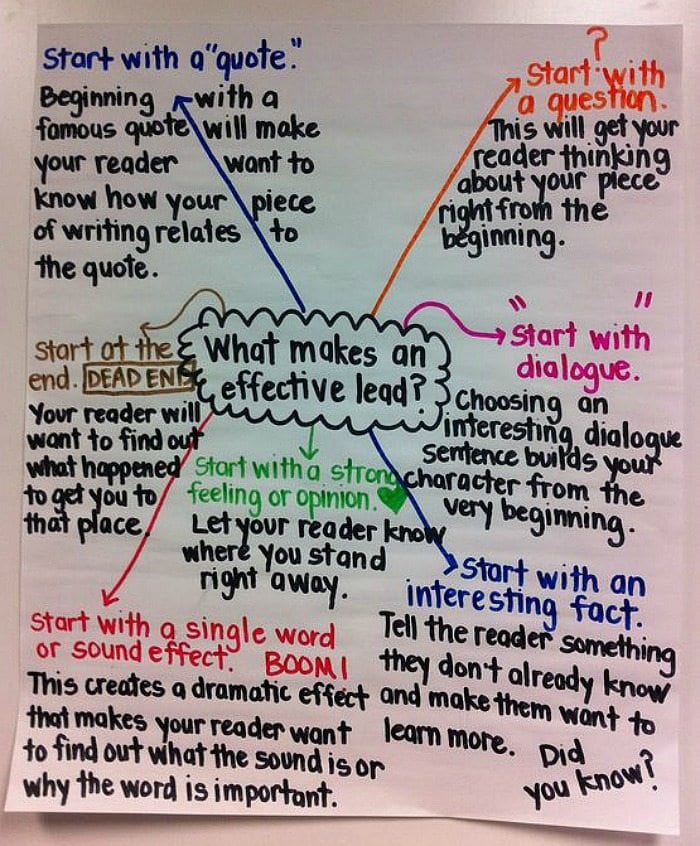
This upper-grade anchor chart gives students lots of ways to start their writing. Update it midyear with strong examples of leads that students have written or that they’ve found in books. Students could also copy this chart into their notebooks and keep track of the different ways they’ve started their own writing, seeing if they’ve developed a signature lead.
Source: Miss Klohn’s Classroom
27. Crafting Power Sentences
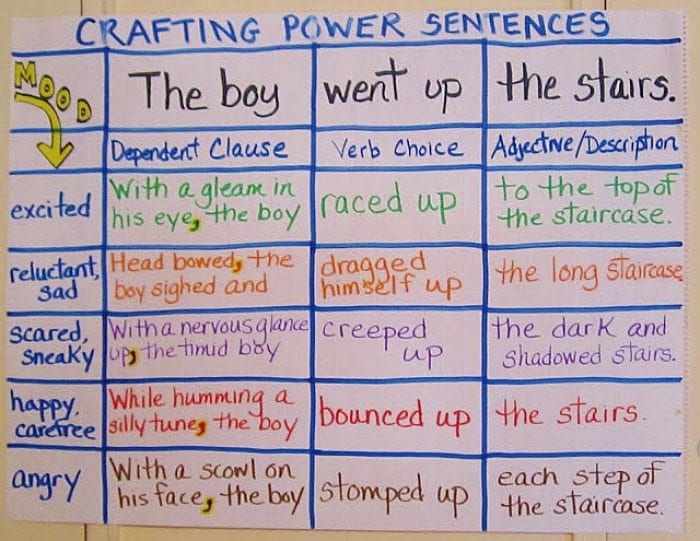
Inspire students to get crafty and creative with their sentences. Update the moods or keywords with every writing assignment, so students are constantly refining their clauses, verbs, and descriptions.
Source: Teaching My Friends
28. Show, Don’t Tell
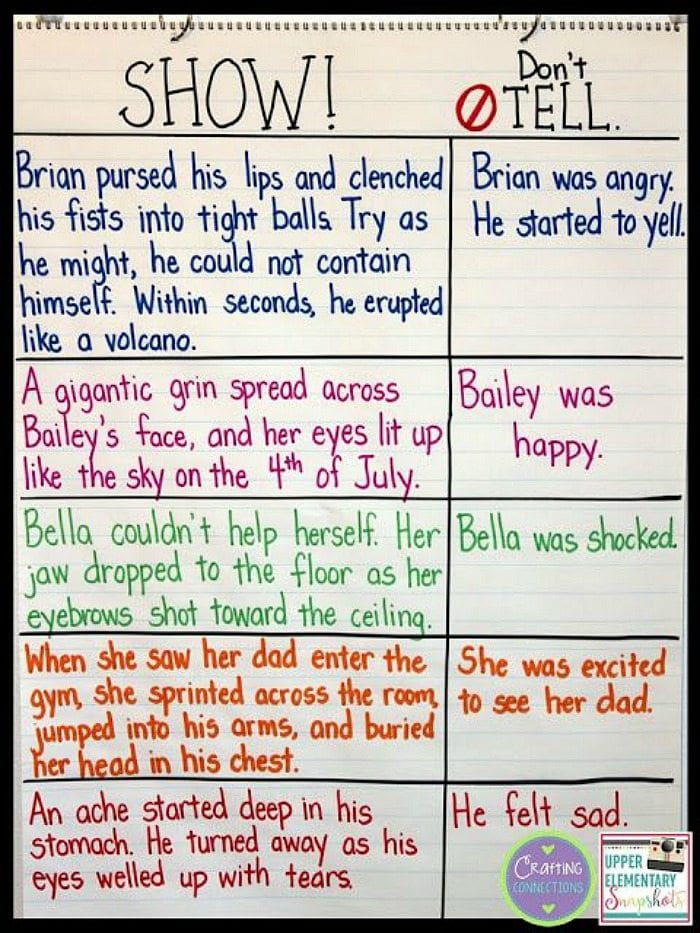
“Show, don’t tell” is a cardinal rule of writing. This anchor chart, best for upper elementary writers, can be used to strengthen scenes in fiction and narrative nonfiction works. Build out this chart for middle school writers with additional ideas and more complex emotions.
Source: Upper Elementary Snapshots/Show, Don’t Tell
29. Narrative Organizer
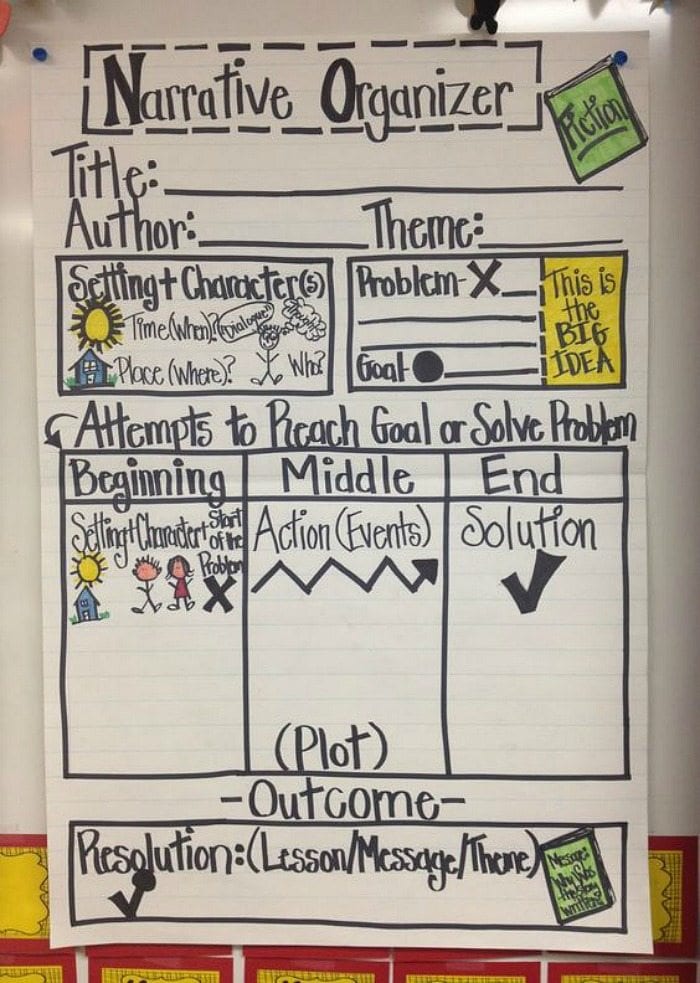
Leave this chart up in your classroom for your students to reference often when they’re writing. It really takes them through creating a successful story.

30. Expository Writing
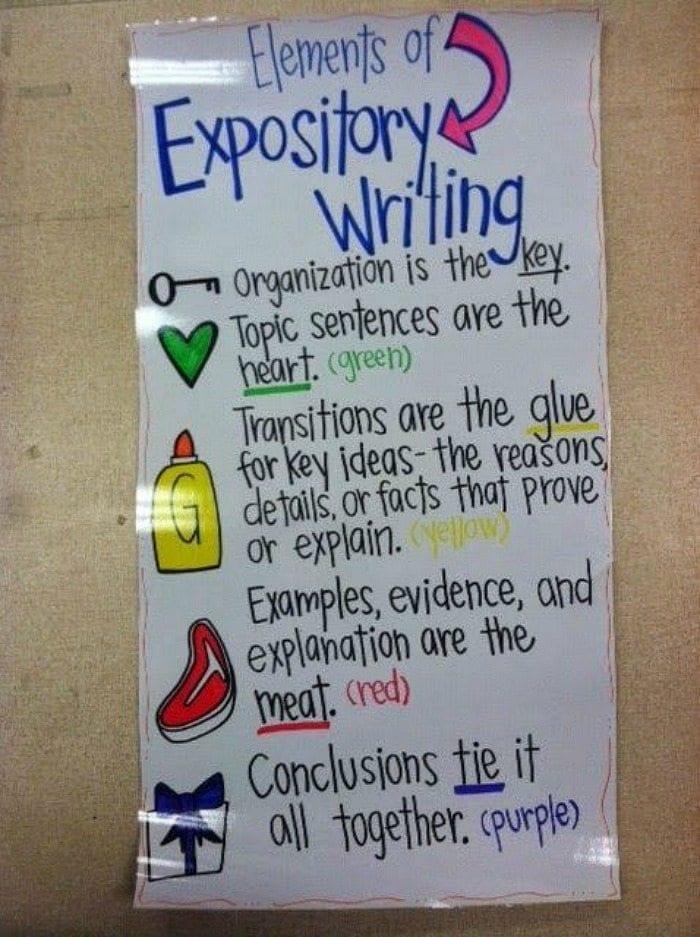
This chart makes it easy for students to remember key concepts, both with color-coding and simple metaphors. Give them colored pencils and ask them to underline the corresponding sections in their essays.
Source: Adventures of a Future Teacher
31. Peer Editing

Peer editing teaches kids a variety of skills, and not just with writing. They learn to read closely, offer (and accept) useful constructive feedback, and get more comfortable sharing their writing with others. This chart helps kids through the sometimes-challenging process.
Source: Taleof2Teachers
32. Strong Sentences
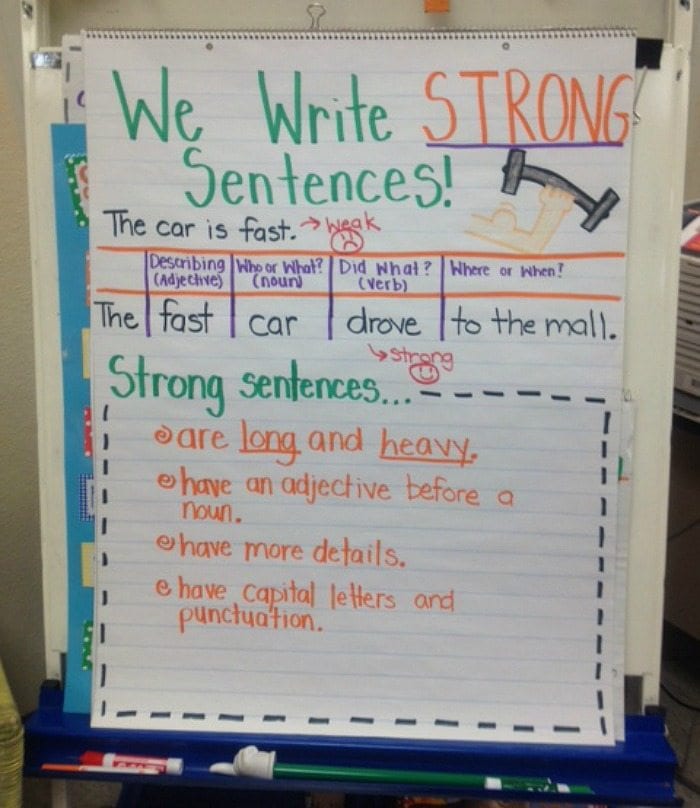
Get early elementary students to write longer, more descriptive sentences with this chart. Bonus: Use sentence strips to switch out the examples of strong sentences, based on student writing.
Source: The Good Life
33. Internal Story
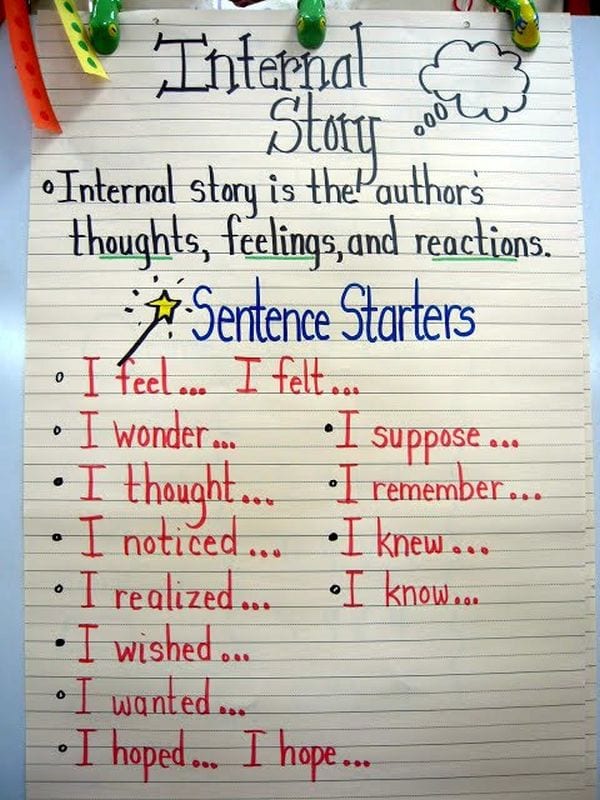
This chart gives students the language to add their own thoughts to their writing. Modify this chart by highlighting key phrases for students with special needs. Or have students create different thought-bubble icons to represent each internal dialogue sentence starter.
Source: Totally Terrific in Texas
34. Evidence Supported
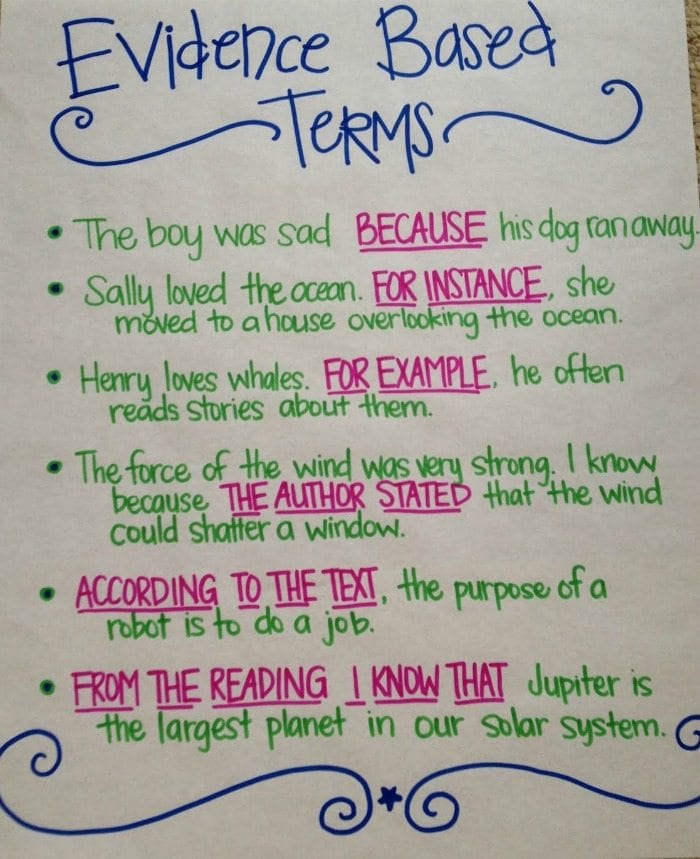
Upper elementary students will benefit from reminders on how to refer to and cite text evidence. Use this anchor chart during writing and discussion to help connect the language that we use across domains.
Source: History Tech
35. Publishing Guidelines

Kids are often quick to turn in their papers without making sure they’ve included all the necessary requirements (like their names!). Use this chart to remind them about the important things to check for before they hand in their work.
Source: Juice Boxes and Crayolas
36. Figurative Language
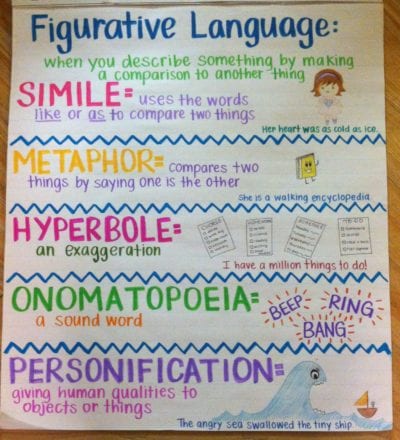
As you teach your students about figurative language and how to use it, you’ll want to have examples. This anchor chart dives into five different concepts. Each of these could actually be its own anchor chart. Perhaps have your students come up with examples on sticky notes and then place them on the chart.
Source: Willow Grove Elementary School
37. Forms of Poetry
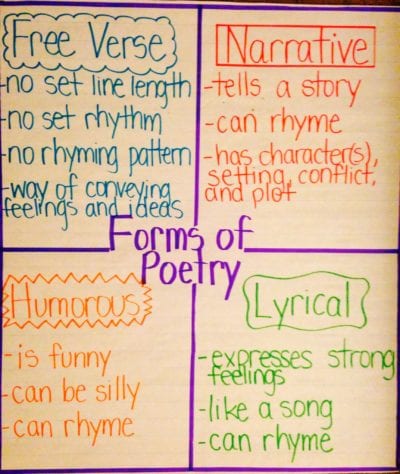
Introducing poetry types to your students? This anchor chart covers the basics and helps kids remember that not all poetry needs to rhyme.
Source: ELA Anchor Charts
38. CUPS and ARMS
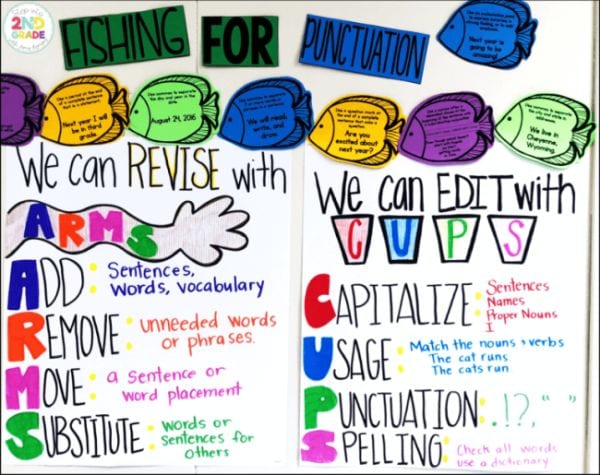
This is a popular method for teaching kids to revise and edit as well as the difference between the two. Simple acronyms keep the key strategies close at hand.
Source: Amy Lemons
39. Spicy Edits
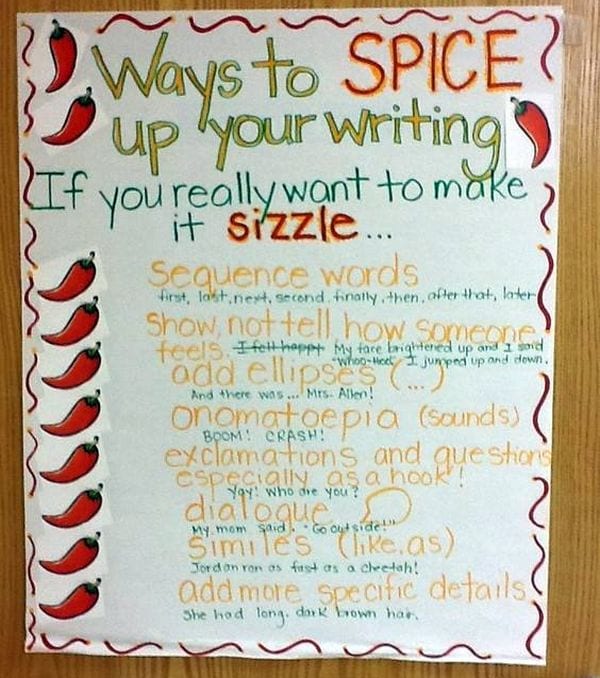
Encourage your students to think of their writing like a recipe, which they can always tweak and improve. Have them choose one element, or “spice,” to add to their work as they revise.
Source: Beyond Zebra/Pinterest
40. Writing Buddies
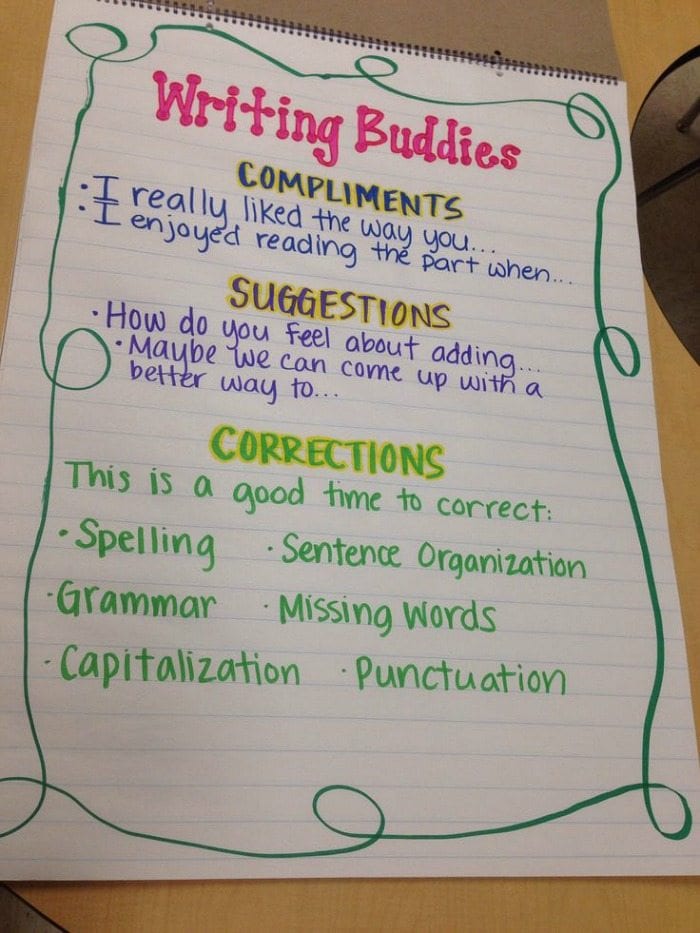
Sometimes students can get stuck when working with writing buddies, but writing anchor charts can help. This one encourages students to be positive and make good, thoughtful suggestions.
Source: Apostrophe Books Twitter
What are your favorite writing anchor charts? Share your ideas in our WeAreTeachers HELPLINE group on Facebook.
Plus, find out why the “hamburger” essay has gone stale, and what to try instead ..
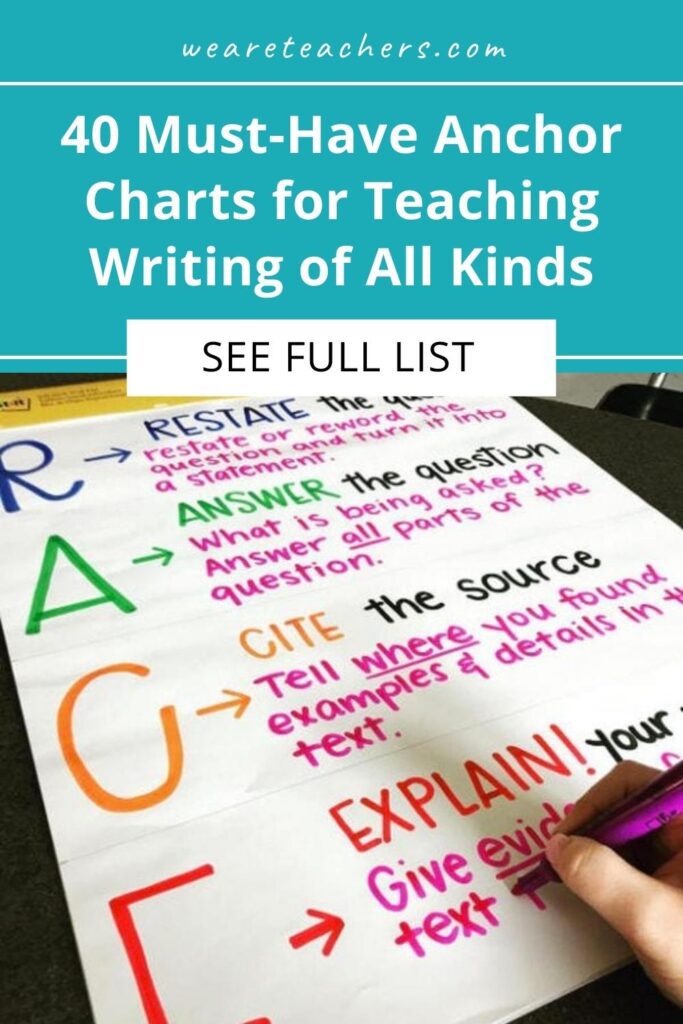
You Might Also Like
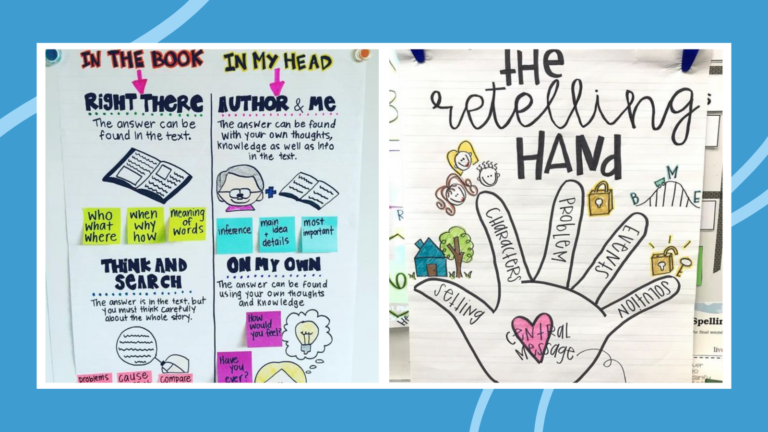
49 Amazing Anchor Charts That Nail Reading Comprehension
Help students learn about characters, setting, main ideas, context, and more. Continue Reading
Copyright © 2023. All rights reserved. 5335 Gate Parkway, Jacksonville, FL 32256
- Skip to main content
Join All-Access Reading…Doors Are Open! Click Here
- All-Access Login
- Freebie Library
- Search this website
Teaching with Jennifer Findley
Upper Elementary Teaching Blog
Persuasive Writing Anchor Charts for Struggling Writers {Lots of Pictures}
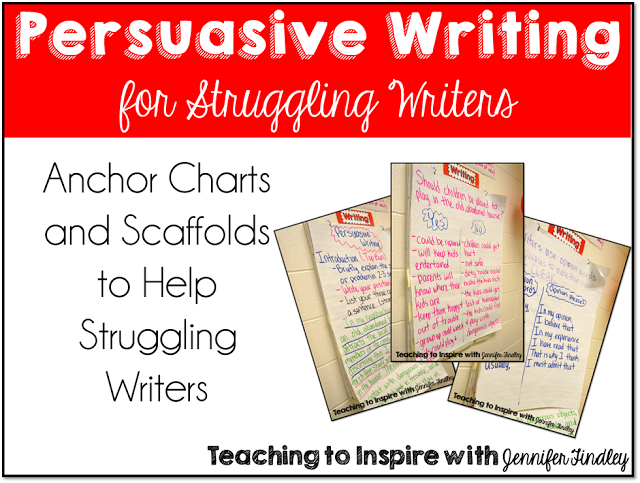
Here are some of my favorite persuasive writing anchor charts that I have used to help my struggling writers write strong, detailed persuasive papers. These charts contain a lot of sentence stems and step by step directions for each paragraph. It may seem a bit formulaic in nature, but once the students feel comfortable, they will branch out and add their own style and unique voice.
Here is a brainstorming poster. A Yes/No chart is one way that I teach students to organize their thoughts before they begin writing. This particular prompt showed a picture of an old, abandoned house and had the students determining if the local children should be allowed to play in the house.

After the students brainstorm several reasons for each side of the argument and they choose a side, we move into writing a clear and strong position statement. Here are some of the stems I offer the students as options.
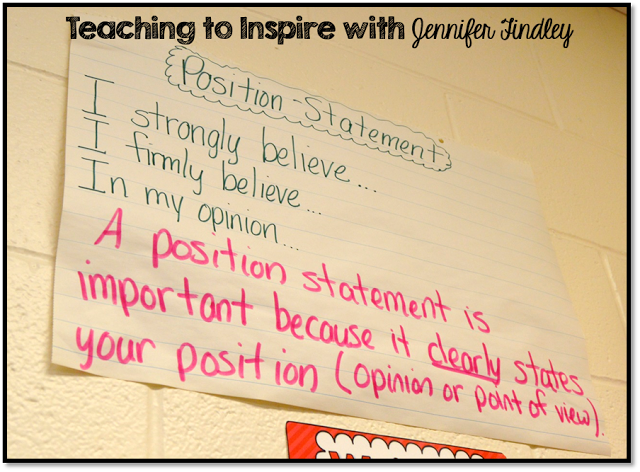
After the students have a solid position statement, we move into our introductory paragraph (nicknamed Top Bun from a hamburger model). I instruct the students to explain what the situation or problem is then to state their position. Finally, they finish their top bun by listing out their three main reasons in a sentence.

Before writing the body paragraphs (or Juicy Middle), we make a chart together with opinion words and phrases to link reasons and details together.

Next, we move into different details that the students can use to support their reasons. This is a chart that I print for the students to glue in their interactive notebooks. Click here to download this printable. At this point, I tell my students about the Power of 3: 3 reasons with 3 supporting details for each reason. Using the charts to guide them, they write their body paragraphs (using transition words and phrases and varying details).
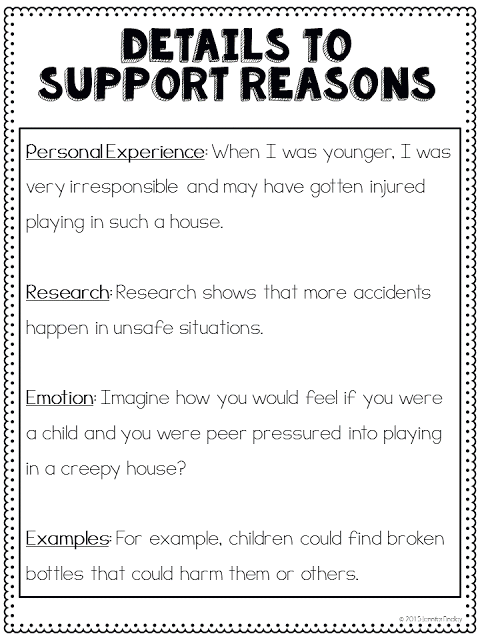
If you want the prompt pages that go along with this download, click here to subscribe to my newsletter to have access to my freebie library. The prompt is an an older newsletter freebie that is now available in my exclusive freebie library for email subscribers only.
Finally, we discuss the concluding paragraph (Bottom Bun). This is where I tell my students to mention the “nod to the other side” or counter argument and prove it incorrect. Then they restate their main point and end their essay. I also offer a few suggestions with ways to end the paper.
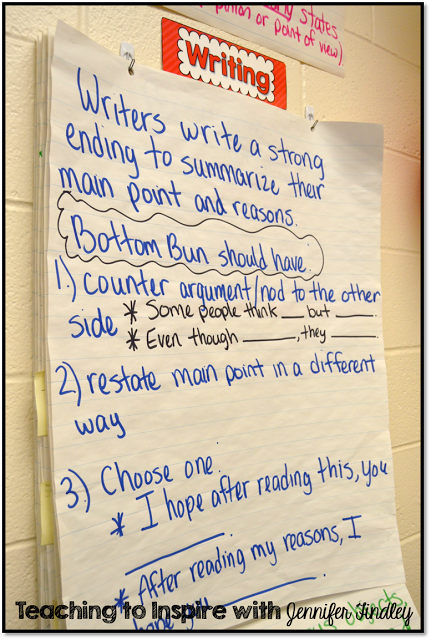
These anchor charts and scaffolds have worked wonders with my struggling writers in the past. Do you have any charts or scaffolds that help your students write persuasively?
Share the Knowledge!
Reader interactions, 13 comments.
November 22, 2015 at 10:13 pm
November 23, 2015 at 7:18 pm
You are very welcome, Collette!
February 12, 2016 at 12:41 am
Hi Jennifer I just subscribed to your blog and pages but cant find where to download the persuasive writing prompts from last year
February 13, 2016 at 9:30 am
Hi Elizabeth, you can access it by signing up for my newsletter at the link below. Once you sign up, the first email you get will have directions for accessing the freebie library where you can find the prompt. it is a Halloween Persuasive Writing prompt but can be used at any point of the year.
http://teachingtoinspire.us9.list-manage.com/subscribe?u=3277466fc24e8e08f8d489936&id=939cf54793
February 13, 2016 at 8:26 pm
Ok. Thanks. I got that but was interested in the poster type help which I first saw on Pinterest. Is that available to print.
February 15, 2016 at 11:21 am
Oh I am sorry. I was confused by what you were asking for and still am a little. Are you referring to this poster? https://drive.google.com/file/d/0B8DtIUhMGc9qMG1nalRmNWhMaWs/view
February 15, 2016 at 2:29 pm
Oh dear. Going round in circles. I think you call them anchor charts. Or brainstorming charts. There are 5 I believe , relating to the hamburger bun poster. Yes/no, statement etc. they’re above on this page. Handwritten on large sheets.
February 15, 2016 at 3:54 pm
Okay, I understand now. Unfortunately, I don’t the anchor charts available in a printable form. You are free to print the pictures from the blog for reference or retype them for your own use. Glad we were able to finally get on the same page. 😀
December 7, 2016 at 9:01 am
Hello, Jennifer. I’m a Third Grade teacher and am loving your blog. Thank you for reaching out and supporting us. I am looking for better ways to teach Information Reading and Writing, specially Text Structures. Do you have any tips?
October 25, 2017 at 6:46 pm
I’ve tried 3 times now, with 2 different email addresses to sign up for you freebie newsletter and it is not working. I am not receiving an email. Is the freebie library not an option anymore? Or has it changed in some way?
Thanks, Jessica
May 12, 2020 at 9:04 am
Hi Jennifer! I just subscribed to your blog and started following your TPT account! I am loving the amazing resources I am finding here! I am currently teaching 6th grade math at a middle school, but am changing schools after this year because of changes I don’t agree with (Who knows what education will look like with the pandemic though.). Anyway, I have accepted a position at an elementary school and will teach 5th grade. Even though I have K-6 licensing, I have have always taught departmentalized in my short career. I say all that to say THANK YOU for this blog! It is already easing my fears as I look through many of your posts. I am already starting to work through how I might teach the core subjects and what items I want to purchase through TPT.
October 25, 2020 at 6:49 pm
HI, I had a question about your abandoned house writing slide. I am new to teaching fifth grade and writing and was wondering if it is asking students to write five paragraphs or just three.
September 25, 2021 at 2:07 pm
This was super awesome! I just did a quick write on persuasive writing to see where my students are at…CLEARLY, they need these anchor charts. THANK YOU!
Leave a Comment Cancel reply
Your email address will not be published. Required fields are marked *
Notify me of follow-up comments by email.
Notify me of new posts by email.
You may also love these freebies!
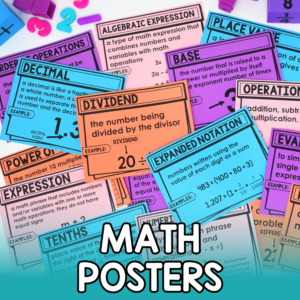
Math Posters
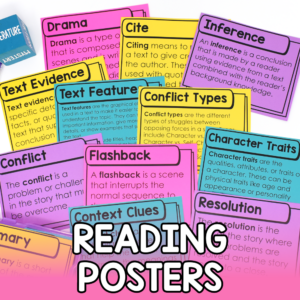
Reading Posters
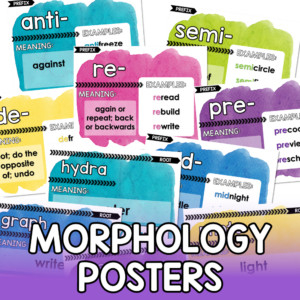
Morphology Posters
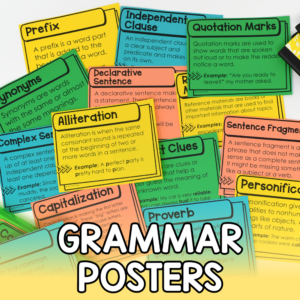
Grammar Posters

Welcome Friends!
I’m Jennifer Findley: a teacher, mother, and avid reader. I believe that with the right resources, mindset, and strategies, all students can achieve at high levels and learn to love learning. My goal is to provide resources and strategies to inspire you and help make this belief a reality for your students.
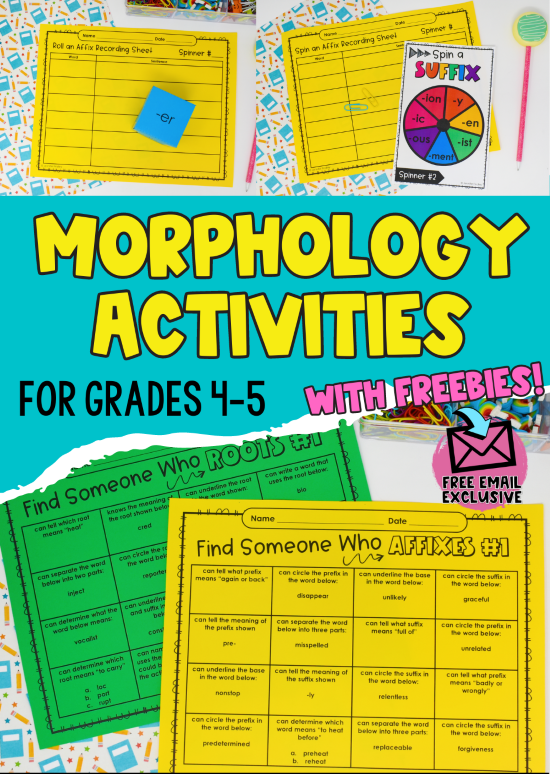
Check Out the New Website Shop!

Novels & Picture Books

Anchor Charts

- Informational Texts
- Literacy Anchor Charts
- Reading Skills
Informational Text Structures
By Mary Montero
Share This Post:
- Facebook Share
- Twitter Share
- Pinterest Share
- Email Share
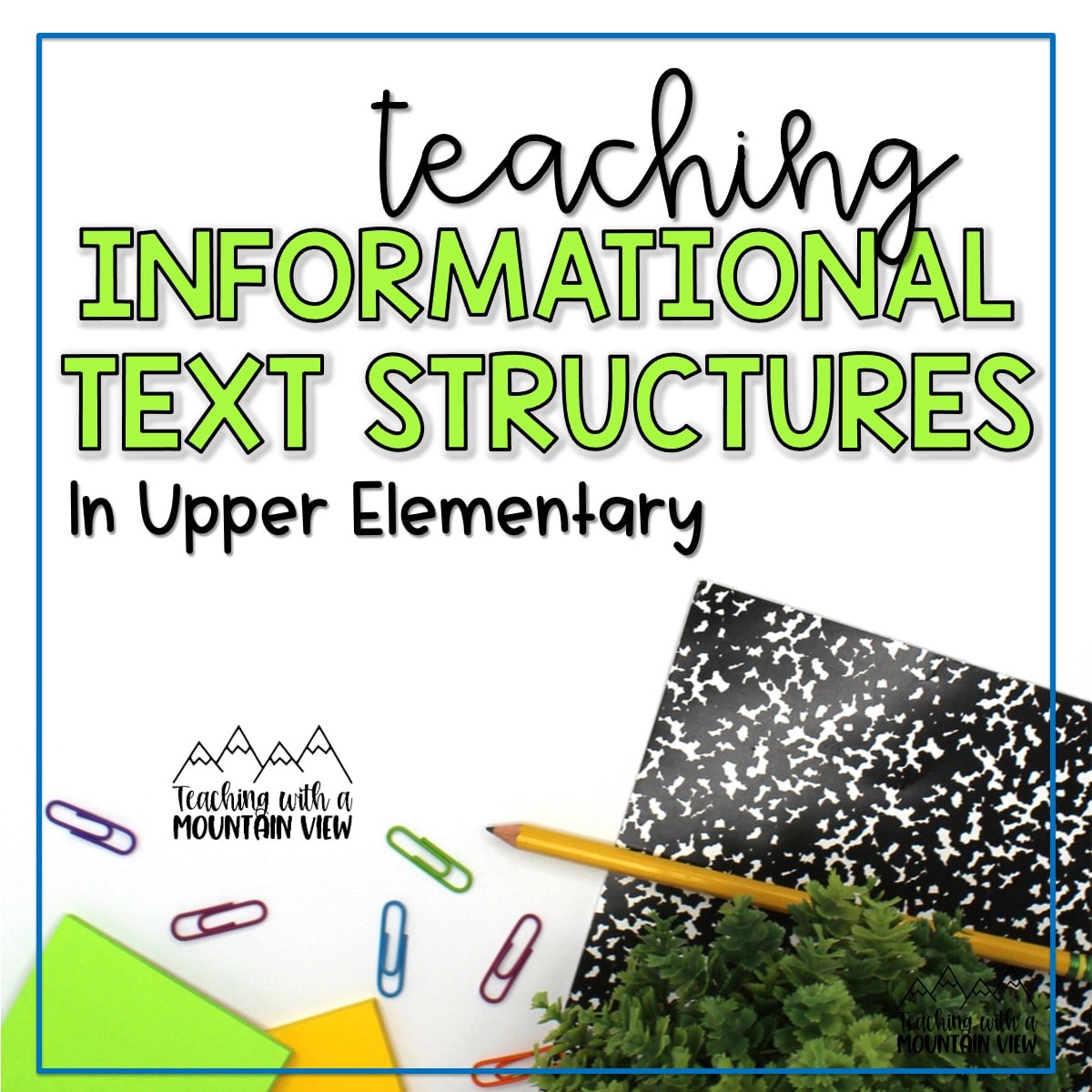
I have spent the past week working on Informational Text Structures with my 5th graders. I was shocked to discover that this was almost an entirely new concept for them, so we did several fun little activities to solidify the concept. This week, they are working on their cumulative project, creating a mini-magazine about a topic of their choice with all the text structures present and a whole myriad of different text features, too. I can’t wait to see their final products!
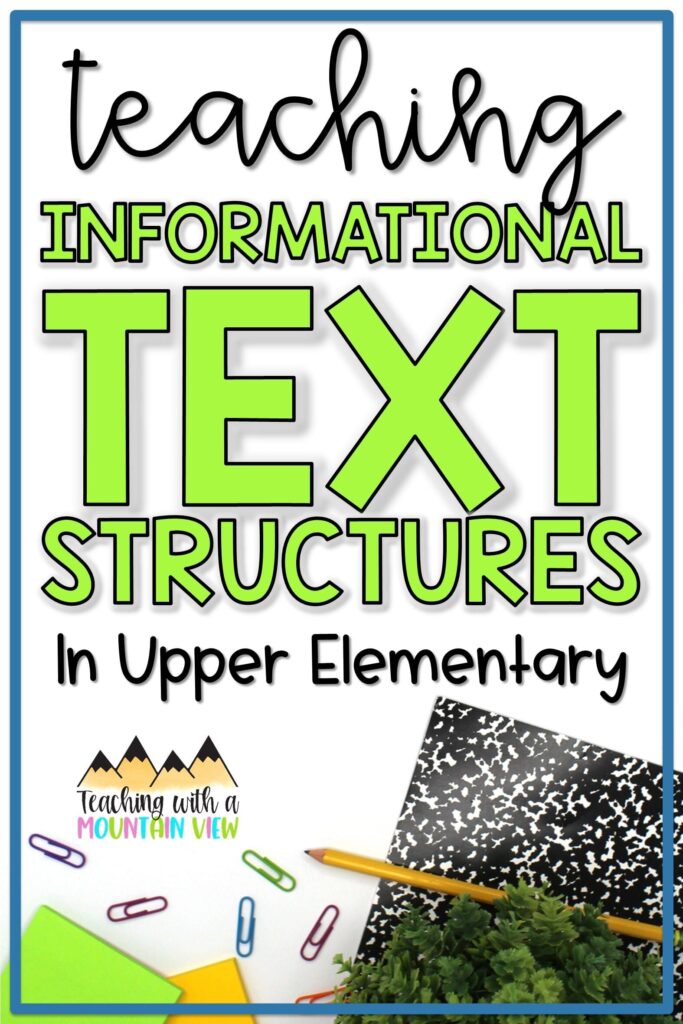
Brainstorming Informational Text Structures
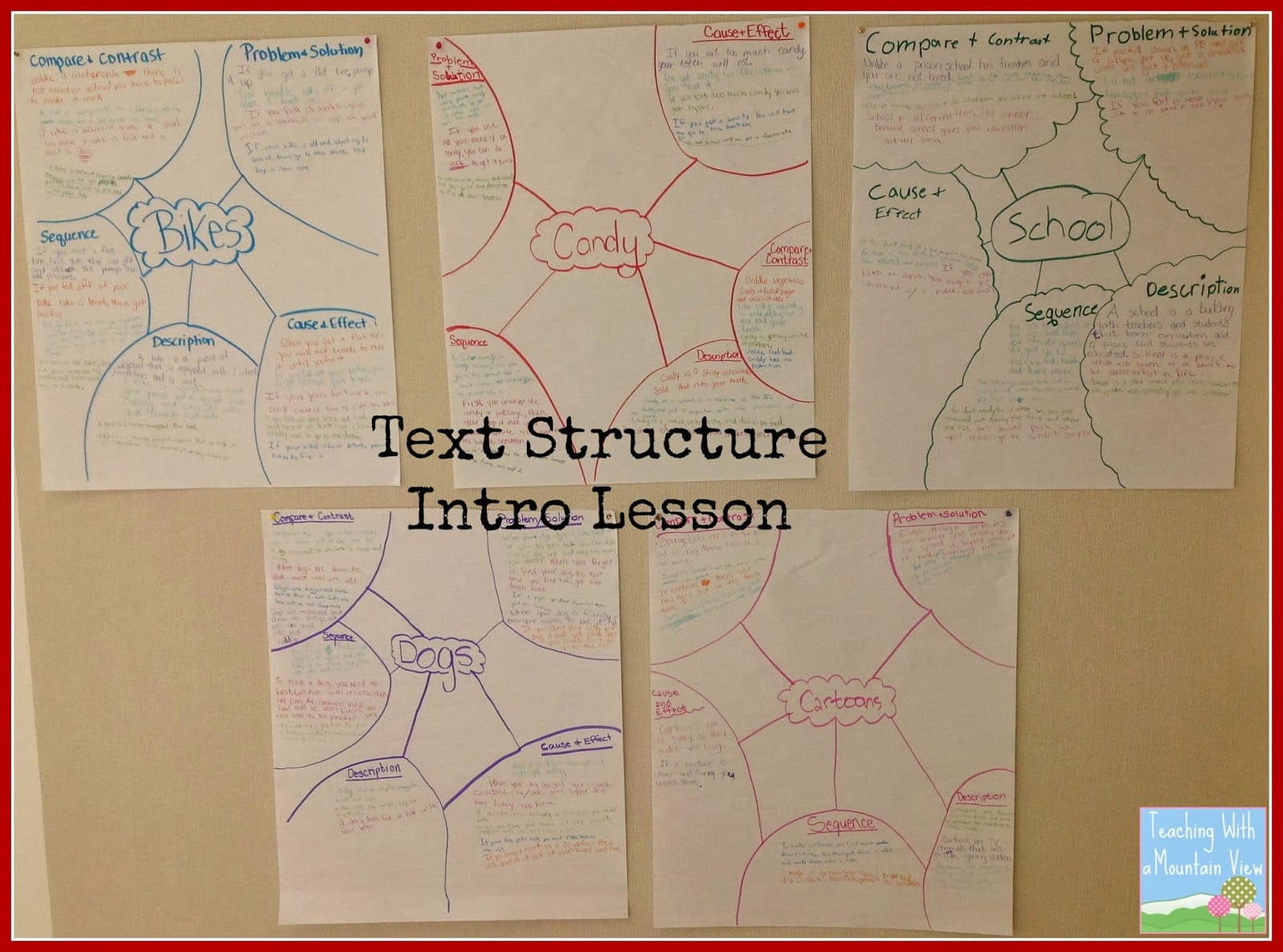
We began the unit by doing a carousel activity. All of my students KNOW what each of the structures means because we spend a lot of time reviewing the concepts during reading. I had them brainstorm five different topics that they could write information about. Then, they divided up a piece of chart paper into a section for each of the types of structures. They got to work writing short sentences that fit the specified type of structure. (At this point, I didn’t even use the term “structure.” I just told them to write an informative sentence that shows each relationship.) They did a GREAT job with this! It would also be a great assessment or mid-unit activity.
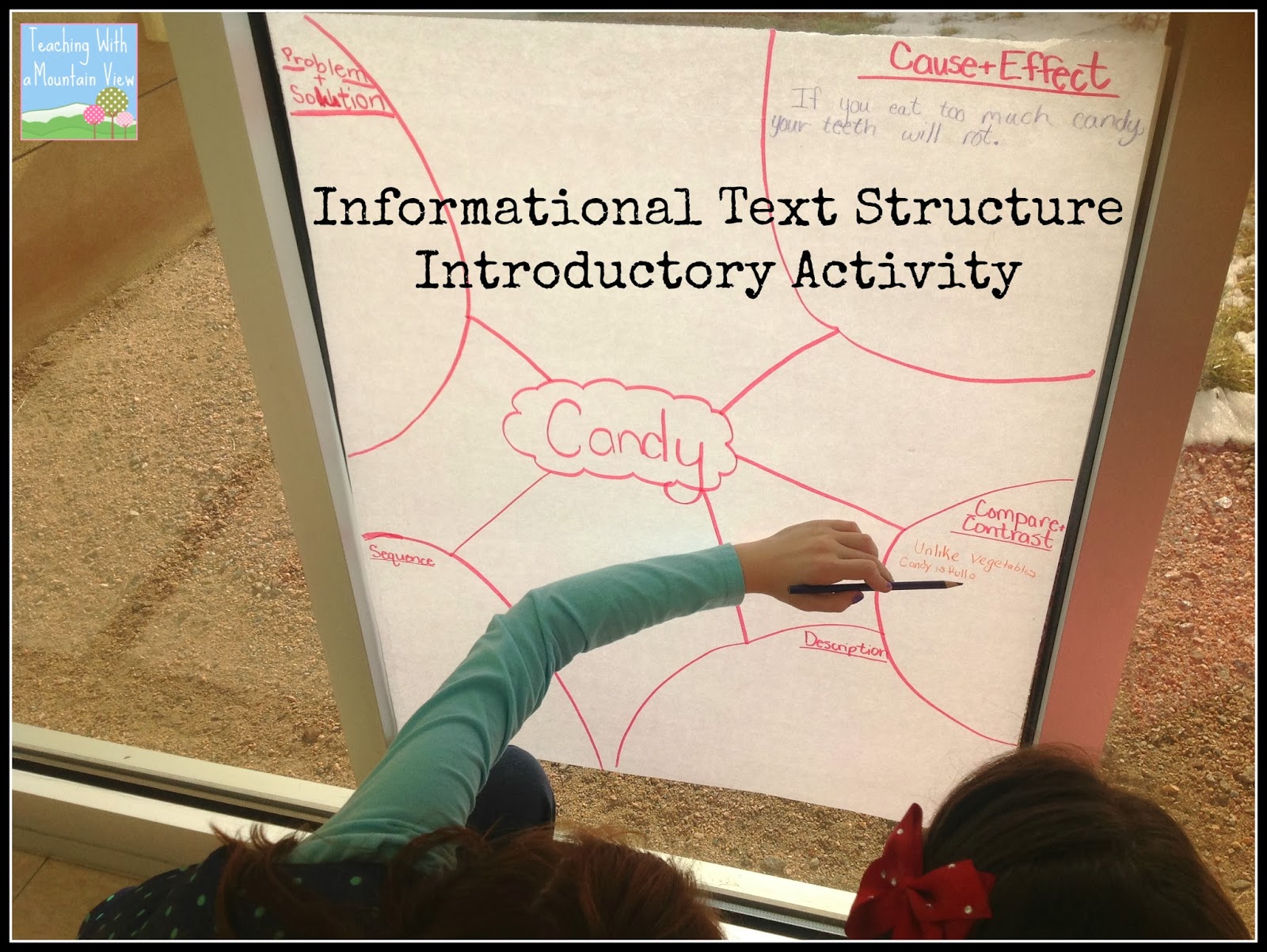
Informational Text Structures Anchor Chart and Foldable
We make an anchor chart to use as a visual reference throughout the unit.
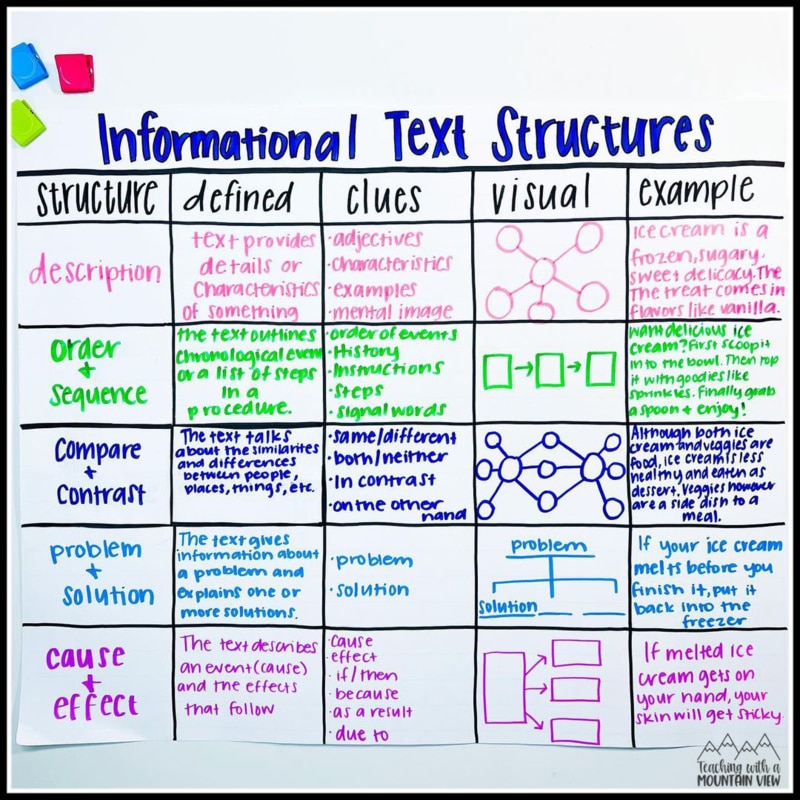
You can also use these informational text structures anchor chart templates to make your anchor chart and reference sheet process even easier!
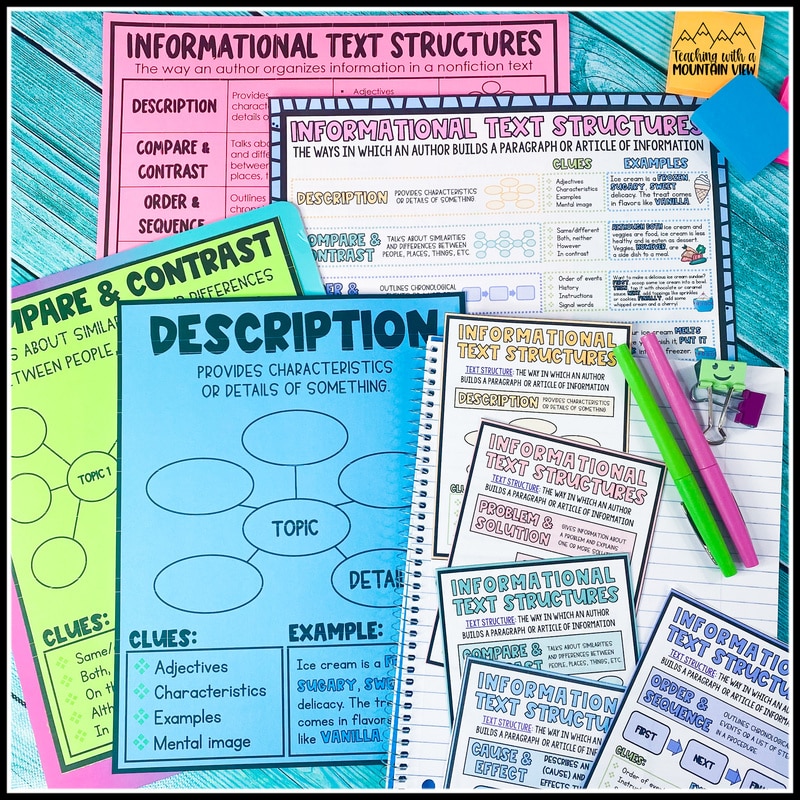
This ready-to-go lesson informational text structure slide show is another way to streamline your lesson planning! Your students will love learning about text structures with these high-interest lesson slides and the accompanying slide guide.
We also make an Informational Text Interactive Notebook (which I LOVE and believe every upper grades teacher should own) that gives a great overview of all of the different text structures. We discussed the etymology of the word “Structure” and that helped the students understand that Informational Text Structure is the way in which an author builds a paragraph or article of information. I created an anchor chart while they made their foldable.
ADDED: Here is a picture of how our foldable ended up looking for the 2015-2016 school year.
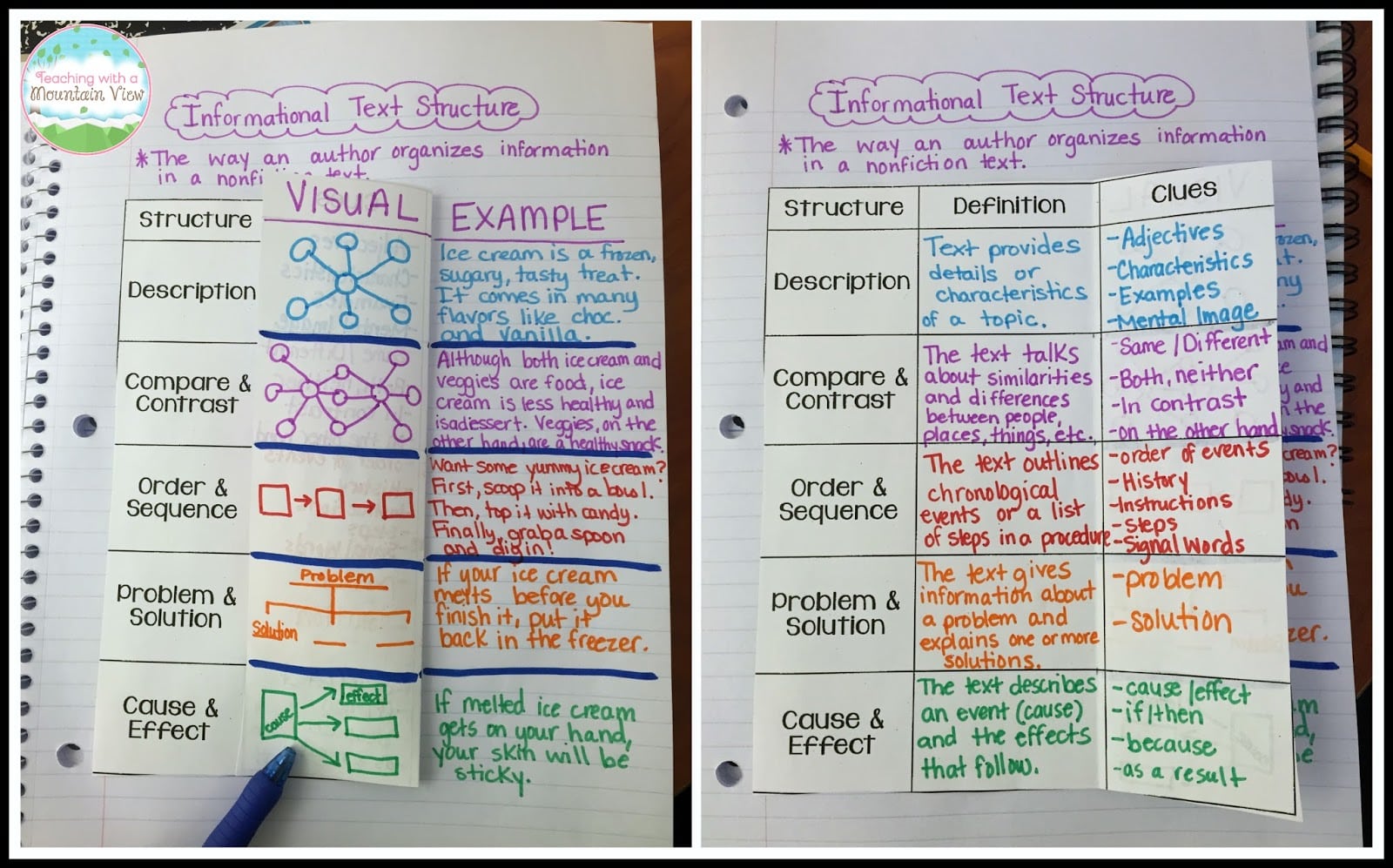
We are a Thinking Maps school, so my visuals were a little bit different than some others I have seen. We also generated an example (about ice cream, of course) for each structure. I can’t tell you how many times the students have referenced this anchor chart while working on other assignments throughout the week. It looked busy to me at first, but it’s full of information that the students seem to find useful.
Free Informational Text Structures Sort
I also created a FREE text structures sort that includes short, one or two sentence descriptions that fit into each structure. The themes are super fun– video games, swimming, chocolate chips, and fast food. I like to laminate the pieces and have students complete them in partners. It also includes a digital version!
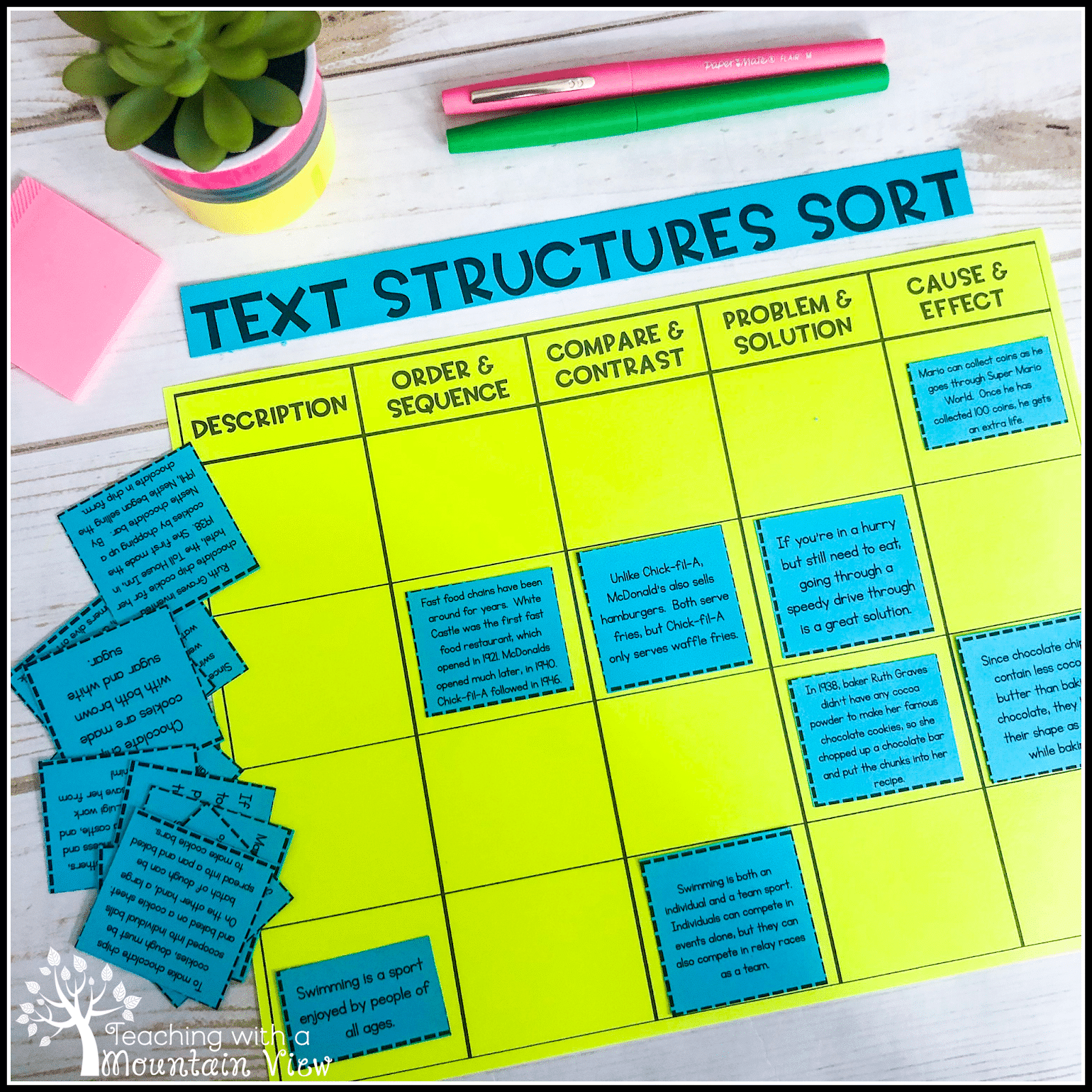
Grab your FREE Text Structures Sort!
Subscribe to get my latest content by email and you will automatically receive your free text structures sort.
Success! Now check your email to begin your download.
There was an error submitting your subscription. Please try again.
Interactive Notebook Examples
Throughout the rest of the week, we completed an individual lesson and foldable from the Interactive Notebooks each day. Erin from I’m Lovin Lit has included separate paragraphs and lessons for each different structure which helped to solidify understanding each of them.
Have I mentioned how much I love these?! Erin was also sweet enough to send me 5 extra free paragraphs about Alcatraz to use with my students. My students were FASCINATED by these paragraphs, and they are perfect for the older crowd. You can download these for FREE , thanks to Erin at I’m Lovin’ Lit . If you haven’t already, check out her blog for more great ideas!
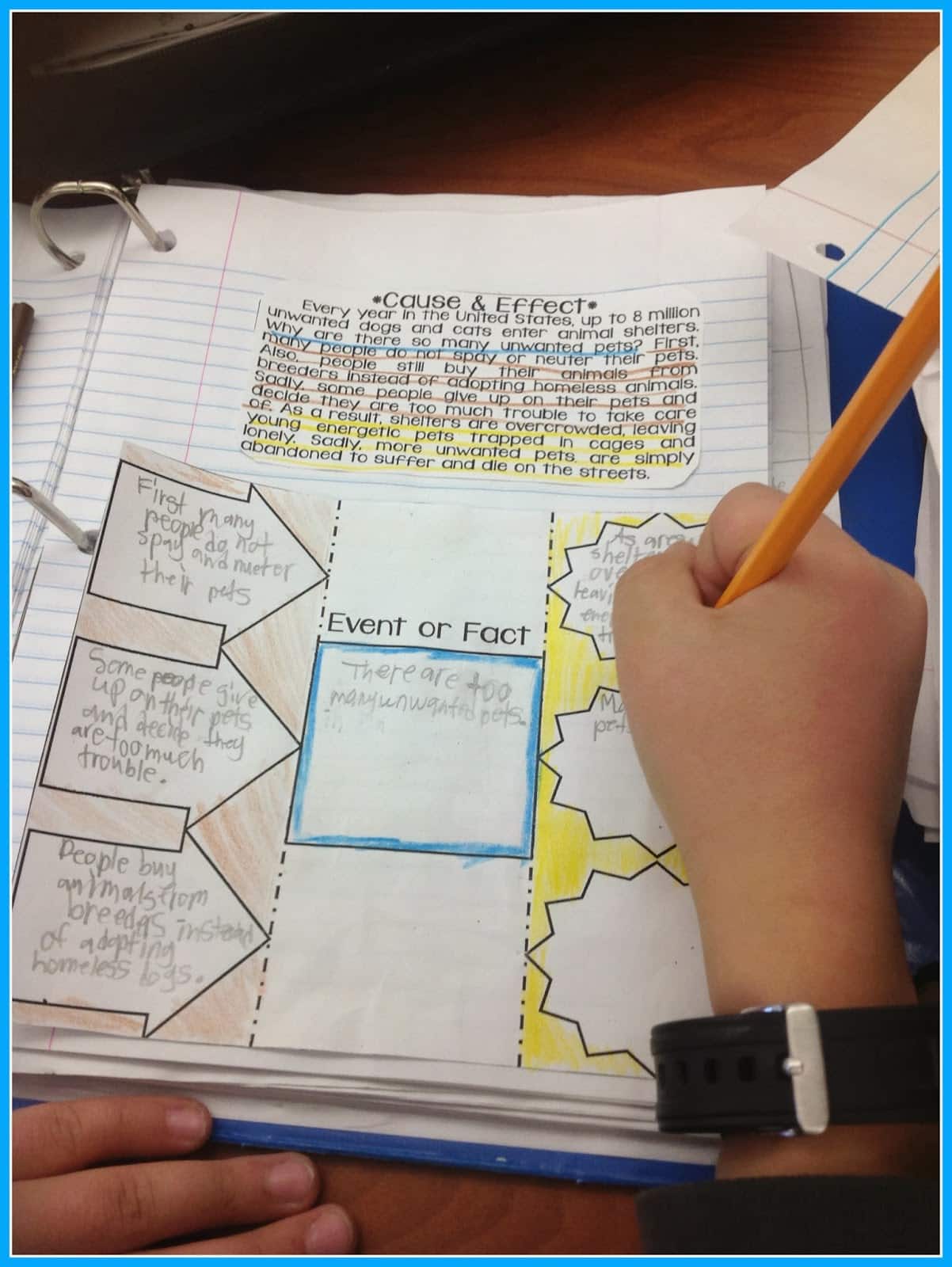
I also use this text structure flip book . On the right-hand side of each section, there is a carefully crafted informational text passage. On the left side of each section of the flip book, students complete several text structure tasks. For example, there is one section that focuses on description, one that focuses on sequence, etc. There is also a comprehension quick check question for each section of the story. Students should complete the entire resource over the course of several days. The final task asks them to put all of their reading skills together to write a summary of the information.
Informational Text Structures Practice Activities
After we did the foldables, they worked on some informational text structure task cards that I created. These task cards were quite the labor of love to create! I was under a time crunch to get them done since I needed to use them in my class, and each one seemed to take me forever to make. The cards include three different paragraphs, written in a different structure, about one topic. I also included comprehension questions on each card since we were working on some other nonfiction comprehension topics as well. The kids really enjoyed these and looked forward to completing their required two each day.
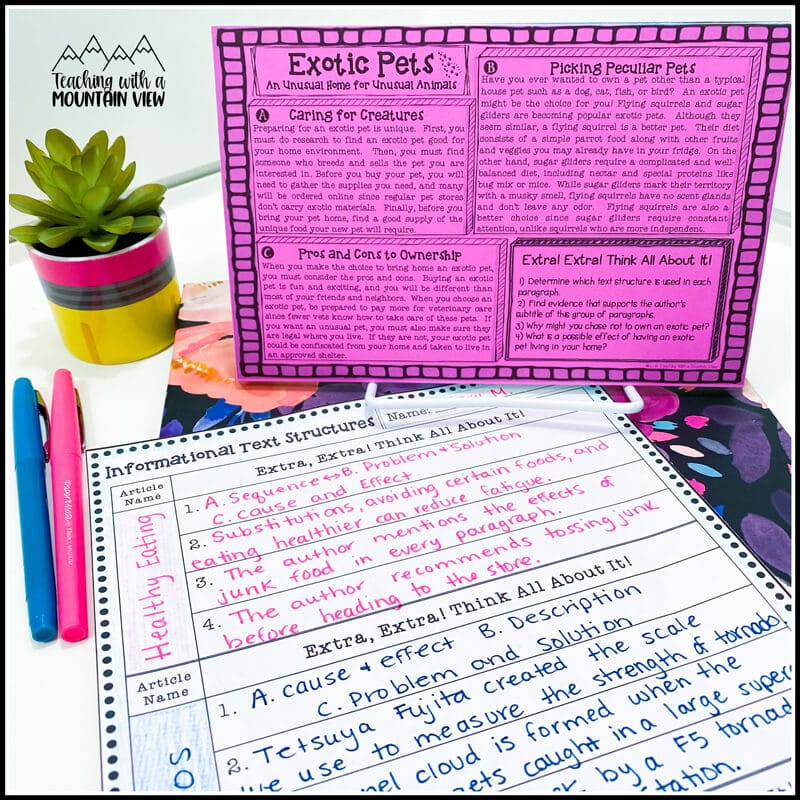
UPDATE February 2017: I used these cards with a little twist this time around! After we had created our foldable and gone through each of Erin’s paragraphs, I gave pairs of students a copy of one of the informational text structure task cards. Then, I had them identify which text structure each paragraph was written in and organize the information in the paragraph using the correct visual Thinking Map that we had discussed. This was such a powerful learning experience! Some students made mistakes in identifying which structure a paragraph was, and when they tried to organize the information in a visual model, it didn’t work! They were able to self-correct so seamlessly. Here are some pictures of the work:
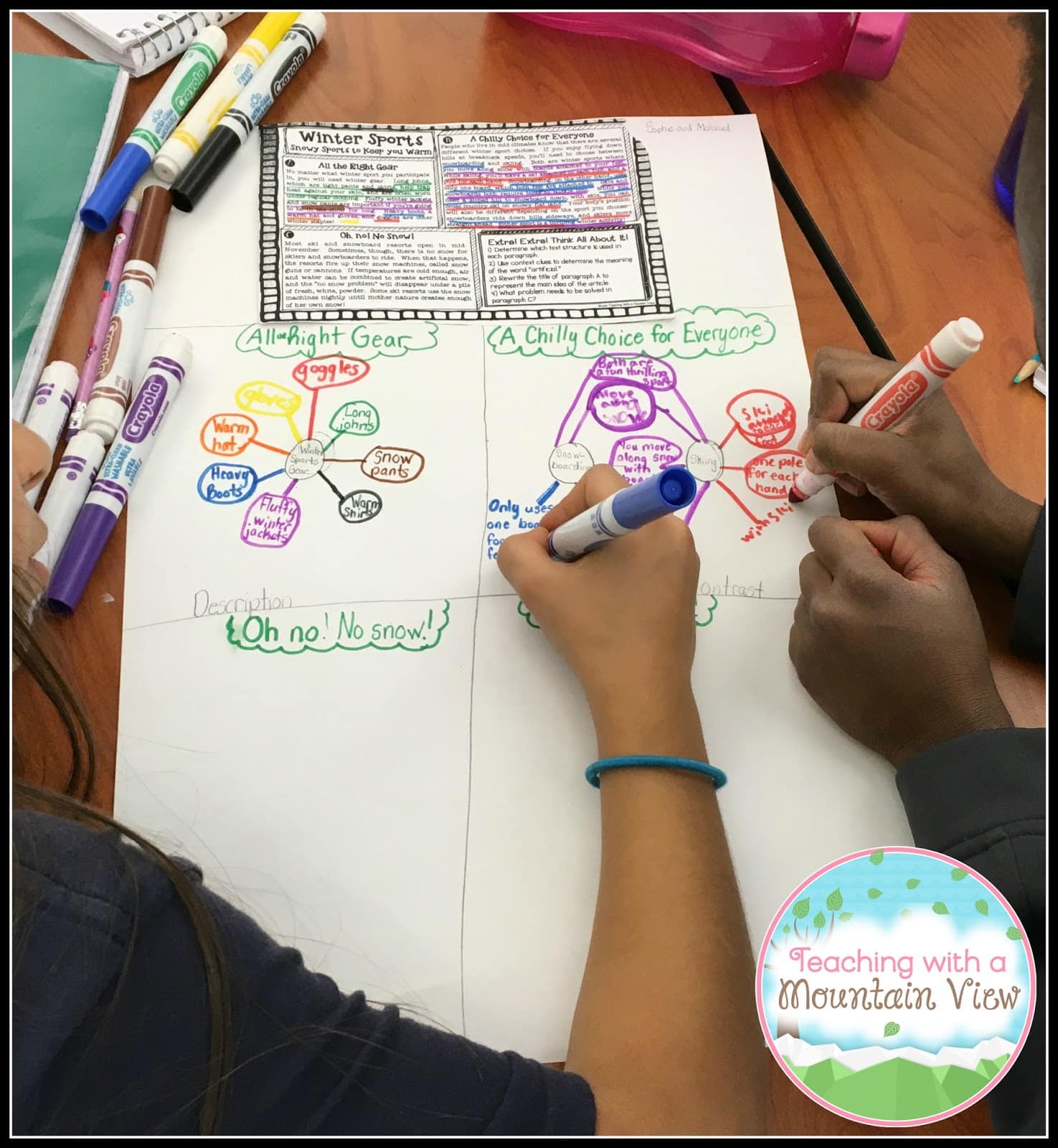
You can purchase these Informational Text Structure Task Cards at my TpT store HERE . They now include the task card version, a printable version, AND a digital version! The possibilities are truly endless.
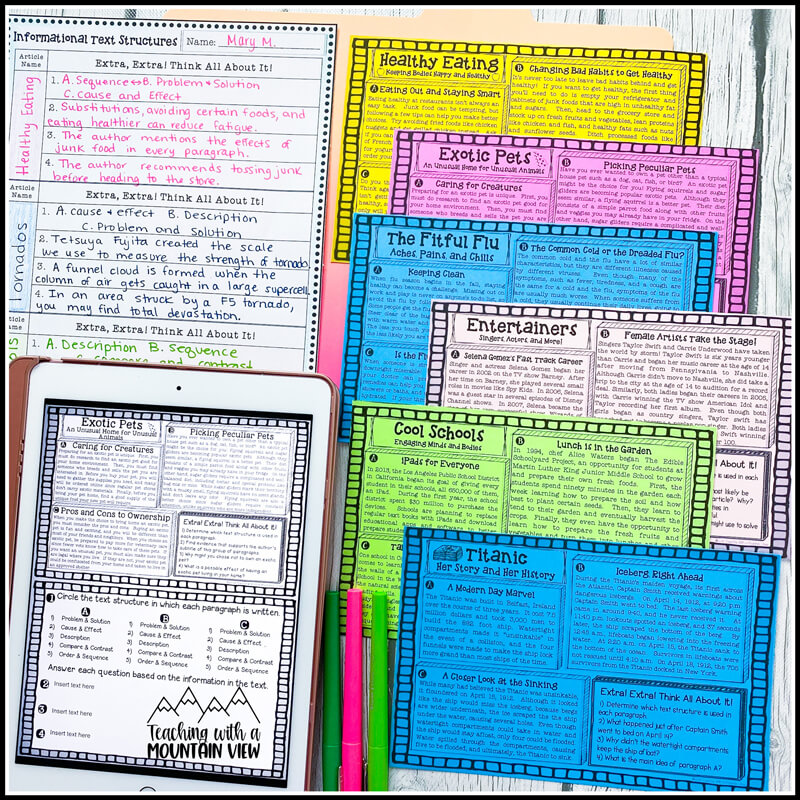
If your students aren’t quite ready for this much text, the resource also includes individual passages. I use them as a text structures sort activity! This is perfect if you have already completed the smaller, easier sort above.
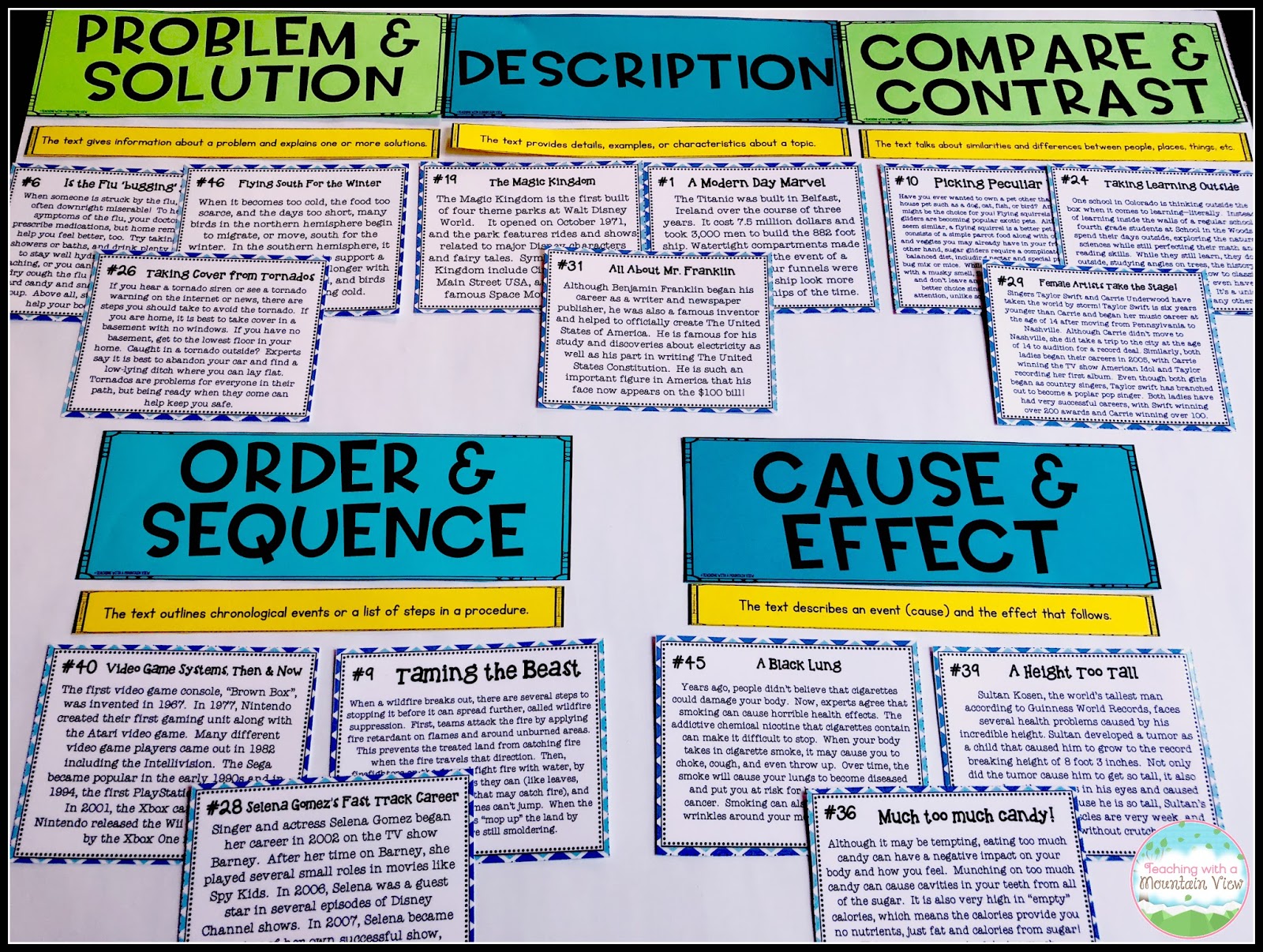
These Using Pictures to Teach Informational Text Structures pages are another way to help students become confident in using and identifying the following text structures through short reading passages: description, order & sequence, cause & effect, compare & contrast, and problem & solution . Each text structure includes the following pages:
- 1 informational reference page to introduce the text structure and provide keywords, text-marking strategies, and a graphic organizer
- 3 practice pages using pictures where students will get hands-on practice using and identifying the text structure
- 1 paragraph practic e page to help students brainstorm a text structure-specific paragraph using a graphic organizer.
Informational Text Structures Leveled Passages
These leveled informational text passages provide the perfect way to differentiate your instruction and engage your students in meaningful reading comprehension.
Each set of 7 leveled passages has been carefully created to allow students to apply critical thinking as they explore text structures. The seven engaging and original texts come in three different levels, each with corresponding annotation reading comprehension activities. The questions are the same or similar for each level passage so all students receive the same deep level of comprehension practice.
Informational Text Structures Reading Projects
Update 2018: I have really been digging reading projects lately, as my students are always so engaged in them. I created this super fun informational text structures reading project that has a racing theme. There are fifteen pages of printable resources to practice the ins and outs of text structures, and it is just so much fun! You can view the project and learn more about it HERE .
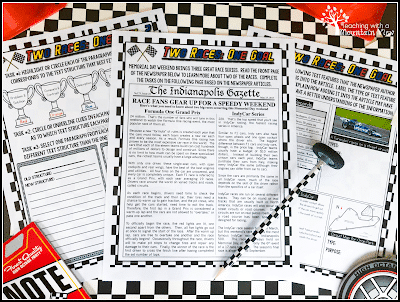
UPDATE: Here is a link to my blog post about our Text Structures Final Projects!
Since then I’ve also created these new Informational Text Structure brochure projects . Your students will become the newest “employees” of the coolest brochure designer in town. After reading informational text passages (two per location) about one of five locations, they will create a new brochure for each location using their super text structure skills! Students will be given a guided brochure template with specific questions pertaining to the passages and informational text structures. They can simply create the brochure using the template, or they can create a brochure from scratch and fill it out using the info on the template!
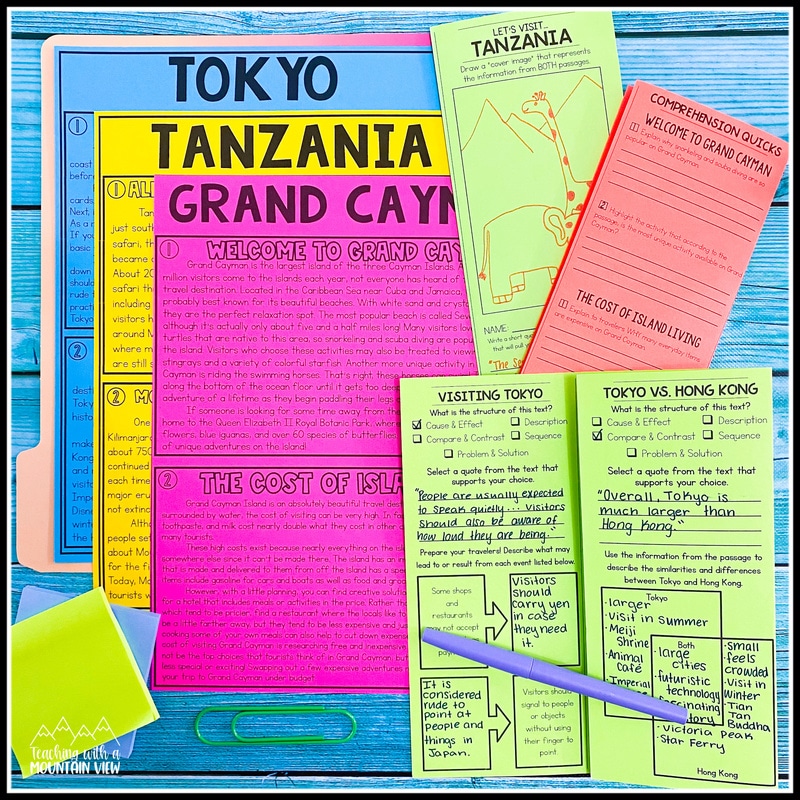
Finally, we are taking an assessment of each of the structures. I based my assessment on the task cards we used, and it is a good way to gauge student understanding. You can download my informational text structures assessment for FREE at my TpT store .
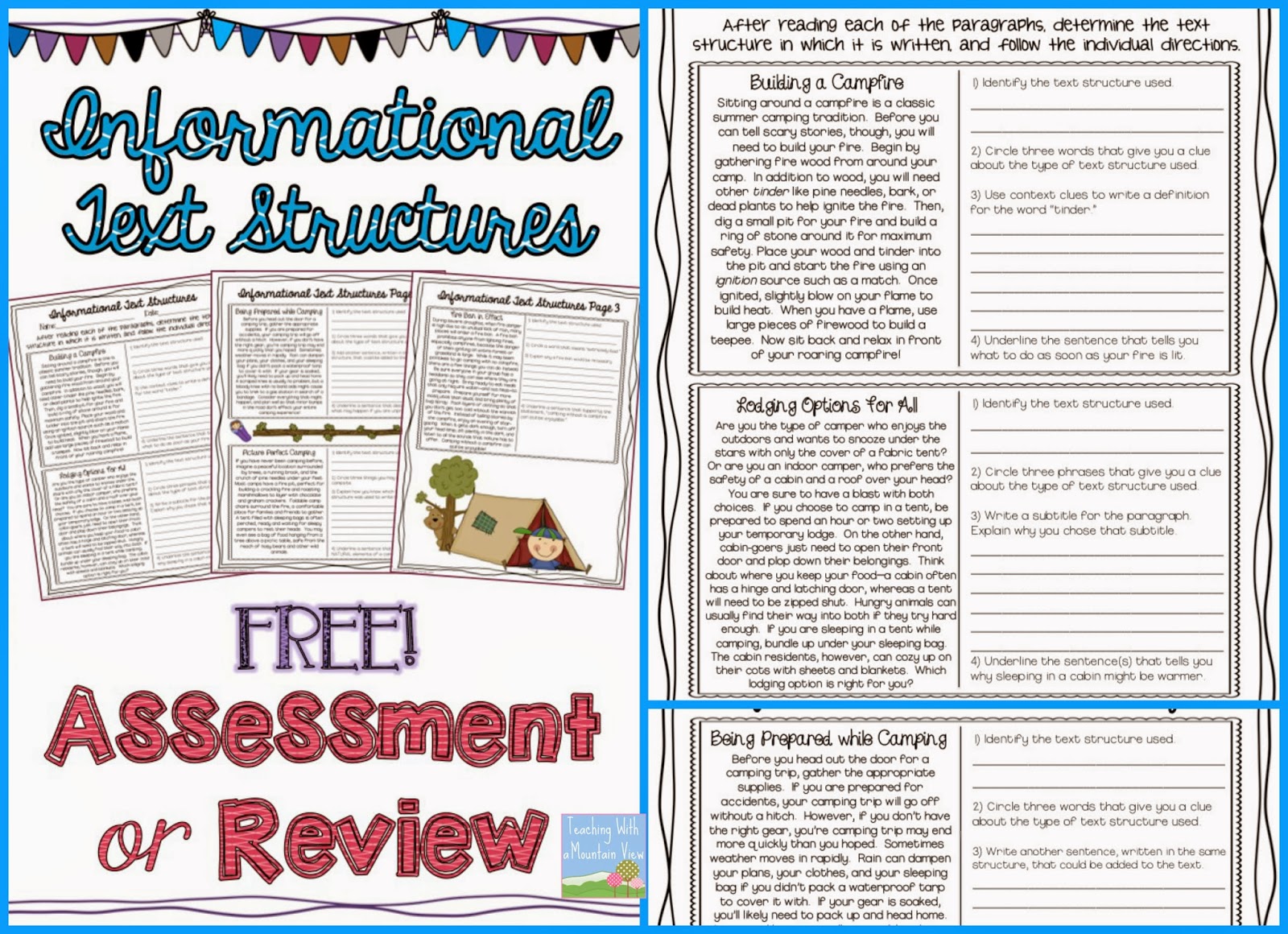
I can’t wait to see the final projects that my students are working on! It should be a great display of their learning and of the common core standards we have been focusing on.
Informational Text Structures Bundle
When you need it all, this Informational Text Structures Bundle is jam-packed with engaging and rigorous ideas to teach students all about informational text structures. Each activity uses high-interest topics to ensure that students are engaged and ready to learn! It includes a nchor chart templates, task cards, a Topple Blocks game, the reading project, the flip book, paired passages, and more!
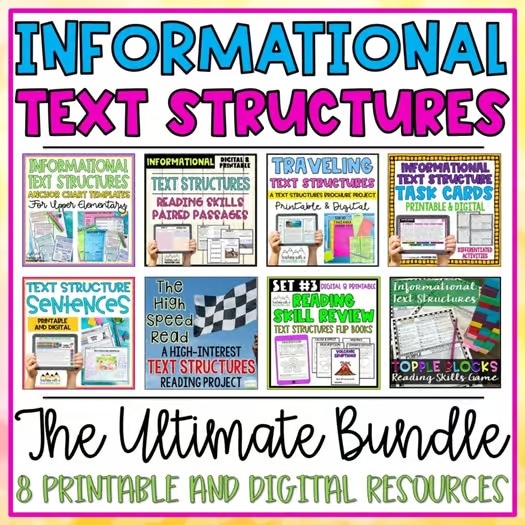
Mary Montero
I’m so glad you are here. I’m a current gifted and talented teacher in a small town in Colorado, and I’ve been in education since 2009. My passion (other than my family and cookies) is for making teachers’ lives easier and classrooms more engaging.
You might also like…

Leave a Reply Cancel reply
Your email address will not be published. Required fields are marked *
38 Comments
What a way to help them understand Information Text.
Just in time! I'm starting on this with my sixers! Thanks for sharing.
I just finished this section with my sixth graders/ and so LOVE Erin's INB's. I have both NF and Fiction. I will use your task cards as a review/and the assessment you put in too! Thanks so much!!!!!! I love the big charts with a topic and then they have to write in the five different ways! 🙂 GREAT IDEA!
I absolutely love these! I really could have used them this year… my kids were having a hard time with text structures! I added your task cards to my wish list on TPT… I must have these for next year! Love it!
Thanks for sharing, Amanda My Shoe String Life
In the event this were being soccer, playing baseball. eight hundred would be regarded stratospheric Männergruppen
Hi Mary! I was so excited to see this post! We've been working on text structures too and I was also surprised at how little they knew about the structures when we began. I love your anchor chart! I made some posters for my class (will try to share them soon) that we've been using this past week. Off to purchase your task cards 🙂 🙂
I'm thrilled I came across your post on informational text this morning (thanks to Pinterest!) as I'm starting the informational reading unit with my 3rd graders tomorrow! I love how you organized it, you've given me some wonderful ideas to adapt for my kiddos! Thank you so much!
Very well organized!!! Thanks for sharing.
I love this anchor chart. I am a flipping the classroom teacher (makes videos for teaching new concepts). I used your anchor chart to help prepare for the video. Since this is a new concept with Common Core it really helped me to be able to understand it myself. I credited your website on the YouTube page! Thank you for sharing such wonderful resources! http://www.youtube.com/watch?v=x2I_6SrOMes
The versatility of our writers enables us to offer and deliver a wide range of services and all types of papers.Let us know at here https://www.topessaywriting.org/ We have hired talented writers from all fields of study, and they are capable of completing any type of academic paper you need.Thanks
You're a genius! I truly love how involved the students are throughout the lesson! Thank you for sharing your ideas!
Great wotk! Do you need professional essay writing help?
Hello!) Once we have learned about text structures in my college. And then I have to write an essay. Ordered it I here http://www.best-essays-writers.com .
Interesting post. By the way, students do not have to worry anymore about writing essays. Using first-rate custom essay writing service, that are available 24/7, learners will always get professionally written essays.
Great post. You know, that writing an essay is not easy, especially if you don't have good writing skills. That's why many students are looking for professional writing help online, so buy college essays online is what you are looking for.
This post is really interetsing. Thanks for it. If you want to get well-written essays at reasonable prices, go to http://essaywritingstore.com .
Given so much info in it, These type of articles keeps the users interest in the website, I found it here, today I am feeling glad after finding this precious post.Thank uResume writing services in Dubai
Most students in schools and tertiary educational background position organizations would commonly want essay help online with regards to their essay jobs would regularly examine internet expert services whereby those people students could purchase them.
This was an excellent post. It has some valuable info on this topic. Thank you for compiling it into an easy to read and well written post. Cheap academic essay help here online!
Majority of students feel nervous and lose confidence when they are asked for writing some essays and presenting before others. If you are one of them then kick away this condition by getting the best custom essay writing service ever for preparing your papers without mistakes and within your cost.
People would order custom written essay about this good topic, choosing the essay writing services. You definitely will need use plagiarism checker. Now, you don’t have to worry about getting a failing mark simply because you have been accused of plagiarizing someone else’s work.
Hello, just wanted to say, I loved this article. It was practical. Keep on posting! — juegosjuegos.com | jogos do friv | juegos de matar zombies
I found it quiet interesting about Best Admissions Essay Help,Thank you for posting the great content…I was looking for something like this…, hopefully you will keep posting such blogs…
http://www.essaytyper.com/
WOW! what a beautiful plus attractive Informational Text Structure, i have never seen before. Nice Sharing Custom Assignment Writing
You have a real ability for writing unique content. I like how you think and the way you represent your views in this article. I agree with your way of thinking. Thank you for sharing. unblocked games| unblocked games at school| unblocked games| friv4school| friv 4 school| call of duty| tetris unblocked| friv games| frivgames| barbie games| barbiegames| monster high games| kizi2| kizi 2
I also want the time back cool math 4 kids , descargar whatsapp , cool maths 4 kids , descargar whatsapp para android , unblockedgames , unblockedgames
Thanks for the best blog.it was very useful for me.keep sharing such ideas in the future as well. Thanks for giving me the useful information. I think I need it! pacman games |happy wheels games |little pony games | unblockedgames friv 4 kizi4| unblocked games unblocked games for kids madness project nexus hacked happy wheels hacked
Great post. i like it. feeling great when reading your post . Signature: Versión en facebook en español descargar a los países hablan Español: facebook entrar direto agora , facebook en español descargar , facebook entrar direto agora
cheap oakley sunglasses ray ban sunglasses michael kors handbags ray-ban sunglasses coach outlet oakley sunglasses outlet chi hair strighteners christian louboutin outlet pandora uk nfl jerseys burberry handbags louis vuitton ralph lauren mont blanc mountain copy watches jordan 3 retro coco chanel hollister outlet gucci outlet oakley outlet hogan outlet kate spade totes kobe 8 cheap oakleys gucci bags michael kors outlet louis vuitton michael kors ray ban eyeglasses hollister clothing store ray ban sunglasses jordan 4 retro cheap ray bans abercrombie outlet jordan 6 cigar 20150626xiong
The best quality custom papers online! http://supreme-essay.net/
Posts shared useful information and meaningful life, I'm glad to be reading this article and hope to soon learn the next article. thank you http://cekkesehatan.blog.fc2.com http://bacakesehatan.drupalgardens.com
Thanks for sharing your info. I really appreciate your efforts and I will be waiting for your further write Packers and Movers Hyderabad Packers and Movers Bangalore Packers and Movers Pune Packers and Movers India
Thanks for sharing. I hope it will be helpful for too many people that are searching for this topic. Packers and Movers Delhi Packers and Movers Gurgaon Packers and Movers Mumbai
Thanks for all your information.Website is very nice and informative content. Packers and Movers Bangalore Packers and Movers Gurgaon Packers and Movers Hyderabad
Thanks for all your information.Website is very nice and informative content. Packers and Movers Pune Packers and Movers Chennai Packers and Movers Delhi
ugg uk nike free gucci outlet hollister shirts coach outlet store evening dresses christian louboutin outlet michael kors outlet , http://www.michaelkorsoutletcanada.in.net san antonio spurs jerseys lululemon cheap jordans , http://www.jordan-shoes.us.com kate spade handbags nike huarache coach outlet online yoga pants , http://www.yogapants.us.com the north face outlet store pandora charms air max 2014 burberry outlet online michael kors outlet , http://www.michaelkorsoutletonlinstore.us.com beats headphones babyliss pro instyler prada shoes kate spade outlet tory burch outlet lacoste shirts lebron james shoes stuart weitzman boots michael kors canada , http://www.michaelkorsoutletcanada.in.net babyliss oakley sunglasses , http://www.oakleysunglassescanada.com fred perry sale green bay packers jerseys coach outlet canada nike roshe run jordan 4 atlanta falcons jersey kate spade outlet 0811maoqiuyun
I love all of your ideas. I am always looking for new ideas on text structure. I am teaching text structure next week and plan on trying some of these. I am curious about the sequence of the activities that you did during the week.

©2023 Teaching With a Mountain View . All Rights Reserved | Designed by Ashley Hughes
Username or Email Address
Remember Me
Lost your password?
Review Cart
No products in the cart.

As you begin teaching the narrative writing process, you may find an anchor chart helpful to show students a visual representation of the work they will be doing. There are many different routes you can take with the anchor chart, and you will likely find yourself creating multiple throughout the lesson. Here are a few examples of narrative writing anchor charts you may create.
1. Elements of a Narrative
One of the first steps in introducing students to narrative writing is showing them the important parts of the piece. Here are the most important ones upper elementary students should see on a narrative writing anchor chart.
- Setting: Where and when the story takes place.
- Characters: Introduce and describe the main characters.
- Plot: The sequence of events that make up the story.
- Conflict: The central problem or challenge the characters face.
- Resolution: How the conflict is resolved or addressed.
2. Narrative Writing Structure
Once you introduce students to the pieces needed to create a compelling narrative, you have to show them the framework for the writing. No one wants a story that’s all over the place. Following this simple structure will help. Lay it out on a narrative writing anchor chart for clarity.
- Hook the reader with an engaging opening.
- Introduce the characters and setting.
- Develop the plot through a series of events.
- Build suspense and tension.
- Show character reactions and emotions.
- Resolve the conflict.
- Provide a satisfying ending.
3. Writing Techniques
Kids will begin to master the initial concepts of writing, and as they do, you can encourage them to better their writing each time they start a new piece. This is where you create a narrative writing anchor chart about making the writing better each time! Give them these tips:
- Descriptive Language: Encourage the use of vivid and sensory details.
- Dialogue: Teach students how to use dialogue to bring characters to life.
- Transitions: Show how to use transitional words and phrases to guide readers through the story.
- Show, Don’t Tell: Emphasize the importance of showing actions and emotions rather than just telling.
4. Revising and Editing
This is the step most students dislike the most, but it’s the most important. Emphasize to your students how necessary it is to check work. Here are some common ways to edit a draft and make it as perfect as possible!
- Peer Feedback: Encourage students to share their writing with peers for constructive feedback.
- Self-Editing: Teach basic editing skills, focusing on grammar, punctuation, and spelling.
- Revising for Clarity: Emphasize the importance of clarity in storytelling.
5. Narrative Writing Prompts
To get you and your students started, use a few of these narrative prompts . Display them on a narrative writing anchor chart and let them choose as they begin.
- Write about a time when you faced a challenge and overcame it.
- Imagine you discover a magical object. Describe the adventure that follows.
- Create a story set in a futuristic world where technology has taken over.
- Write about a memorable moment from your summer vacation.
- If you could travel back in time, what historical event would you visit, and why?
6. Writing Process
To sum it all up, here is how students should naturally start and end their writing process! Practice over and over so they get the hang of it; in no time, they will be masters.
- Brainstorming: Generate ideas and plan the story.
- Drafting: Write the initial version of the narrative.
- Revising: Make improvements to the content and structure.
- Editing: Correct errors in grammar, punctuation, and spelling.
- Publishing: Share the final, polished narrative.
By incorporating these elements into a narrative writing anchor chart, students can refer to it as a constant reminder of the key components and techniques needed for successful storytelling. This visual aid can be a valuable resource in fostering a supportive and creative writing environment in the upper elementary classroom.
More Posts about Narrative Writing
- 20 Inviting Narrative Writing Example Prompts for Upper Elementary Students
- Vocabulary Words for 6th Graders Can Be Exciting and as Simple as 1-2-3
- 4 Exciting Prompts for Narrative Writing That Will Spark Creativity
- A Useful Guide to Using a Narrative Writing Graphic Organizer for Kids

You might also like these posts:

Utilizing Classroom Centers in 5 Powerful Ways
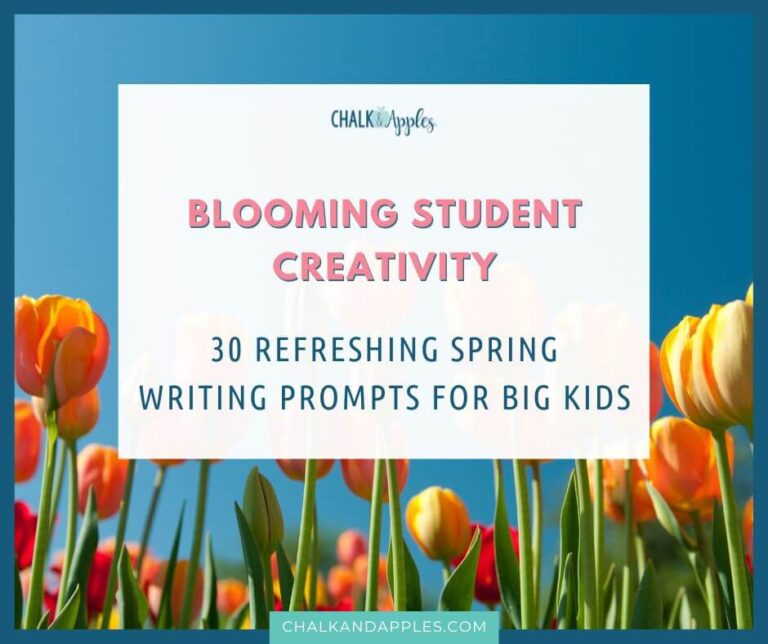
Blooming Student Creativity: 30 Refreshing Spring Writing Prompts for Big Kids

What are Text Structures Anchor Charts, and How Can Teachers Use Them to Their Advantage?

Common and Proper Noun Worksheets Are Boring! Try These Exciting Activities Instead!
Shop teacher favorites.
Find ready-to-go lessons, activities, and organizational tools to simplify your life and help you fall back in love with your job.

Reading Digital Rotation Board with Timers (Editable)

Digital Rotation Boards for Reading & Math (Bundle)
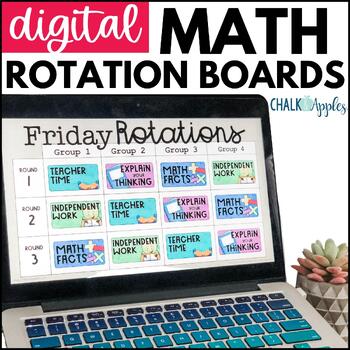
Math Digital Rotation Board with Timers (Editable)

Word Work for Big Kids: PRINTABLES for Vocabulary

Great Mail Race Complete Kit
Free teaching resources, join the newsletter.
Get teaching tips, resources, and freebies delivered right to your inbox once a week!
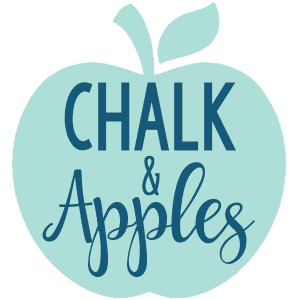
- Terms of Use
- Disclaimers
- Privacy Policy
- Resource Shop
- Access Purchases
The Community
We weren't meant to do this teaching life alone... we need each other. Join our Upper Elementary teacher community on Facebook for tips, ideas, and support from people who get it... teachers just like you!

Want 20% off your first purchase?
Narrative writing anchor charts.
You can grab a free set of anchor chart-toppers and examples for teaching your personal narrative writing unit. Everything you need to prepare your anchor charts before filling them in with your class!

I'd love to see how you use your narrative writing charts! Tag me on Instagram or send me your photos at [email protected]
Happy Planning!

anchor charts for informational writing
All Formats
Resource types, all resource types.
- Rating Count
- Price (Ascending)
- Price (Descending)
- Most Recent
Anchor charts for informational writing

Informational Writing Hooks Anchor Chart

Informational Writing Graphic Organizers & Anchor Charts & Worksheets
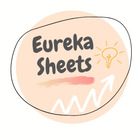
Writing Jamboards Templates | Nonfiction Opinion Informational Anchor Charts

- Google Apps™
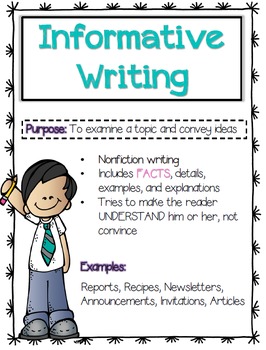
Informative Writing Anchor Chart

Writing Posters Anchor Charts Opinion Narrative Informative Graphic Organizers

Opinion Narrative Informational Graphic Organizer Writing Anchor Charts BUNDLE
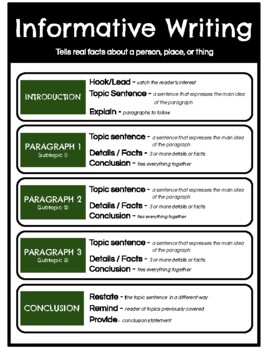
Informative Writing Anchor Charts & Graphic Organizer - Upper Grades

Informative Writing Poster Anchor Chart

Informative Writing Anchor Chart / Transitional Words

Informative Writing Prompts, Templates & Anchor Charts for 1st, 2nd & 3rd Grade
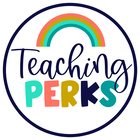
Informational Writing Example Informational Writing Anchor Chart

Informative Writing Graphic Organizer, Anchor Chart and Writing Paper

Photo Writing Prompts & Writing Anchor Charts Narrative Informational Opinion
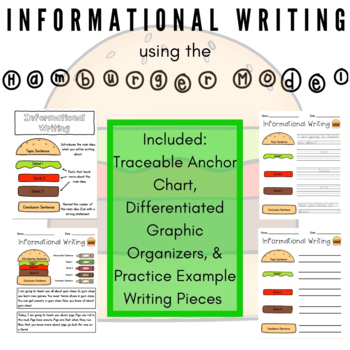
Informational Writing (Hamburger Organizer and Anchor Chart Traceable)

Informational Writing Anchor Charts (& Student Notebook Sheets)

Informative Writing Anchor Charts

Informational Writing Flip Book Writing Anchor Charts Writing Graphic Organizer
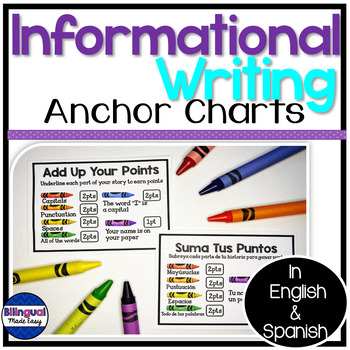
Writing Anchor Chart Posters in English & Spanish: Informational Writing
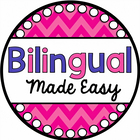
All About Books Anchor Charts Informational Writing TC Writing Workshop

CCSS Informational Writing Anchor Charts

Wolf Labeling and Writing Activities - Informative Writing Anchor Charts Wolves

FSA Writing [ Opinion & Informative ] Anchor Charts

- We're hiring
- Help & FAQ
- Privacy policy
- Student privacy
- Terms of service
- Tell us what you think
EL Education Curriculum
You are here.
- ELA 2019 G8:M1:U3:L7
Write a Compare and Contrast Essay: Draft the Introduction
In this lesson, daily learning targets, ongoing assessment.
- Technology and Multimedia
Supporting English Language Learners
Materials from previous lessons, new materials, closing & assessments, you are here:.
- ELA 2019 Grade 8
- ELA 2019 G8:M1
- ELA 2019 G8:M1:U3
Like what you see?
Order printed materials, teacher guides and more.
How to order
Help us improve!
Tell us how the curriculum is working in your classroom and send us corrections or suggestions for improving it.
Leave feedback
Focus Standards: These are the standards the instruction addresses.
- W.8.2a, W.8.5
Supporting Standards: These are the standards that are incidental—no direct instruction in this lesson, but practice of these standards occurs as a result of addressing the focus standards.
- RL.8.1, RL.8.3, RL.8.9, RI.8.1, W.8.4, W.8.6, W.8.9, W.8.10, SL.8.1, L.8.5b, L.8.6
- I can draft an introduction to a compare and contrast essay that includes a strong focus statement. (W.8.2a, W.8.4)
- I can give kind, helpful, and specific feedback to my partner. (W.8.5, SL.8.1)
- Opening A: Entrance Ticket (W.8.2a)
- Work Time A: Language Dive: Compare and Contrast Model Essay Focus Statement (W.8.2a, W.8.4, L.8.5b)
- Work Time C: Draft of Introduction (RL.8.9, W.8.2a, W.8.4)
- Prepare Entrance Ticket: Unit 3, Lesson 7.
- Review the Compare and Contrast Painted Essay(r) anchor chart (for teacher reference) to become familiar with what will be required of students over the remainder of the unit.
- Preview the Language Dive Guide and consider how to invite conversation among students to address the language goals suggested under each sentence chunk strip (see Materials list). Select from the questions and goals provided to best meet students' needs.
- Ensure there is a copy of Entrance Ticket: Unit 3, Lesson 7 at each student's workspace.
- Post the learning targets and applicable anchor charts (see Materials list).
Tech and Multimedia
- Continue to use the technology tools recommended throughout previous units to create anchor charts to share with families; to record students as they participate in discussions and protocols to review with students later and to share with families; and for students to listen to and annotate text, record ideas on note-catchers, and word-process writing.
Supports guided in part by CA ELD Standards 8.I.B.6, 8.I.B.7, 8.I.B.8, 8.IC.10, 8.I.C.11, and 8.I.C.12.
Important Points in the Lesson Itself
- To support ELLs, this lesson provides students with an in-depth look at the focus statement of Model Essay: "Peuchen" during a Language Dive and subsequent time spent applying new understanding about the structure and content of focus statements directly to writing. Following the Language Dive, students will plan and draft an introduction, including a focus statement, for the compare and contrast La Llorona essay, supported by a graphic organizer.
- ELLs may find it challenging to produce clear and cohesive focus statements and may need continued reminders about essential information and structure when drafting introductions. Additionally, ELLs may struggle to put their ideas into words. To aid this process, encourage students to "work backward" on their graphic organizers, using Proof Paragraph main ideas to guide the construction of focus statements and the rest of the introduction.
- introduction, focus statement (A)
(A): Academic Vocabulary
(DS): Domain-Specific Vocabulary
- Compare and Contrast Painted Essay® anchor chart (one for display; from Unit 3, Lesson 6, Work Time A
- Close Readers Do These Things anchor chart (from Unit 1, Lesson 4, Opening B)
- Academic word wall (from Unit 1, Lesson 1, Opening A)
Compare and Contrast La Llorona note-catcher (for teacher reference) (from Unit 3, Lesson 4, Work Time B)
- Compare and Contrast La Llorona sample student response (for teacher reference) (from Unit 3, Lesson 4, Teaching Notes)
- Compare and Contrast Painted Essay® anchor chart (example for teacher reference; from Unit 3, Lesson 6, Work Time A)
- Work to Become Ethical People anchor chart (Unit 1, Lesson 1, Work Time D)
- Vocabulary logs (one per student; from Unit 1, Lesson 2, Opening A)
- Online or print dictionaries (including ELL and home language dictionaries)
- Model Essay: “Peuchen” (from Unit 3, Lesson 6, Work Time A)
- Compare and Contrast La Llorona note-catcher (from Unit 3, Lesson 4, Work Time B)
- Painted Essay® template (from Unit 3, Lesson 6, Work Time A)
- Summer of the Mariposas (text; from Unit 1, Lesson 1)
- La Llorona by Joe Hayes (from Unit 3, Lesson 3, Work Time A)
- Entrance Ticket: Unit 3, Lesson 7 (answers for teacher reference)
- Language Dive Guide: Model Essay: “Peuchen,” Paragraph 1 (for teacher reference)
- Language Dive: Model Essay: “Peuchen,” Paragraph 1 note-catcher (example for teacher reference)
- Compare and Contrast Informative Writing Plan graphic organizer (for teacher reference)
- Entrance Ticket: Unit 3, Lesson 7 (one per student)
- Language Dive: Model Essay: “Peuchen,” Paragraph 1 note-catcher (one per student and one for display)
- Language Dive: Model Essay: “Peuchen,” Paragraph 1 sentence chunk strips (one per pair of students)
- Compare and Contrast Informative Writing Plan graphic organizer (one per student and one for display)
- Word processor (one per student)
Each unit in the 6-8 Language Arts Curriculum has two standards-based assessments built in, one mid-unit assessment and one end of unit assessment. The module concludes with a performance task at the end of Unit 3 to synthesize students' understanding of what they accomplished through supported, standards-based writing.
Copyright © 2013-2024 by EL Education, New York, NY.
Get updates about our new K-5 curriculum as new materials and tools debut.
Help us improve our curriculum..
Tell us what’s going well, share your concerns and feedback.
Terms of use . To learn more about EL Education, visit eleducation.org

IMAGES
VIDEO
COMMENTS
The chart also serves as a reminder they can turn to when writing their essay. A writing anchor chart can focus on different elements of writing, but you should always start with the ones that focus on the structure, such as: Introduction anchor chart; Paragraph anchor chart; Conclusion anchor chart; Body paragraph anchor chart
25 of our favorite charts for teaching your students all about writing. 1. The Why Behind Writers Workshops Source: The First Grade Parade First and second graders will draw inspiration from this fun-filled anchor chart about why we write. Make this chart applicable to older students by expanding on each aspect with a specific audience or goal.
Characteristics of a Literary Analysis Essay anchor chart (one for display) Informative Writing checklist (example for teacher reference) ... Display the Structure anchor chart, and ask a student to read the structures listed in the "Common Structures Used in Narratives" section of the chart. Explain to students that writers typically use a ...
Here are some general tips to help ensure you get the most out of Anchor Charts in your classroom: Keep things simple. Be sure the writing is well organised and easy to read. Use headings and bullet points to help display the main points. Use different colors for headings, bullet points etc.
Students have worked with the Painted Essay® structure in previous modules. In this unit, they use the same structure, but focus on how the structure applies to argument writing. ... Criteria of an Effective Argument Essay anchor chart (for teacher reference) Criteria of an Effective Argument Essay anchor chart (one for display; co-created in ...
An anchor chart is a tool used to support instruction (i.e., "anchor" the learning for students). As you teach a lesson, you create a chart, together with your students, that captures the most important content and relevant strategies. Anchor charts build a culture of literacy in the classroom by making thinking—both the teacher's and ...
Most teachers incorporate mini (or maxi) lessons on a regular basis. As students learn new information, anchor charts are a way to help them ground their learning. Because of the way we create them (more on that later), they help students to synthesize their thinking about an important topic or skill. Generally, we use anchor charts for ...
28. Show, Don't Tell. "Show, don't tell" is a cardinal rule of writing. This anchor chart, best for upper elementary writers, can be used to strengthen scenes in fiction and narrative nonfiction works. Build out this chart for middle school writers with additional ideas and more complex emotions.
Structure anchor chart (example for teacher reference) (from Module 3, Unit 2, Lesson 1, Closing and Assessment A) ... Refer students to the Characteristics of a Literary Analysis Essay anchor chart and review the sections related to the conclusion. Field any questions students have about the role of the conclusion in this essay.
Here are some of my favorite persuasive writing anchor charts that I have used to help my struggling writers write strong, detailed persuasive papers. These charts contain a lot of sentence stems and step by step directions for each paragraph. ... Then they restate their main point and end their essay. I also offer a few suggestions with ways ...
Anchor Charts for Persuasive Writing. Children's sense of fairness provides powerful motivation for persuasive writing. In this mini-lesson, an analysis of this genre and a graphic organizer help students succeed. This clip is excerpted from Stenhouse Publishers' "Inside Notebooks." Top.
New skills are introduced in the following: RI.7.2 - Work Time A: Students analyze a model informative essay to determine the central ideas of the essay. Work Time A: The class co-creates the Criteria of an Effective Informative Essay anchor chart. W.7.2 - Closing and Assessment A: Students explore the Painted Essay® structure to review ...
Description. Use this handy FREE resource to review the structure of an essay with students prior to teaching them how to write one. It simultaneously gives students an overview of the writing steps to "build" the essay while also serving as a quick reference sheet so students can self-monitor as they write their essay.
Text structure refers to the organization of information within a text. Recognizing these patterns helps readers comprehend content more effectively and can also serve to illuminate an author's purpose for writing a particular piece. To evaluate a text's structure, look for the following clues: the text or author's purpose, goal, or ...
Each text structure includes the following pages: 1 informational reference page to introduce the text structure and provide keywords, text-marking strategies, and a graphic organizer. 3 practice pages using pictures where students will get hands-on practice using and identifying the text structure.
2. Narrative Writing Structure. Once you introduce students to the pieces needed to create a compelling narrative, you have to show them the framework for the writing. No one wants a story that's all over the place. Following this simple structure will help. Lay it out on a narrative writing anchor chart for clarity. Introduction:
Generate criteria on the Compare and Contrast Painted Essay® anchor chart, referencing the Compare and Contrast Painted Essay® anchor chart (for teacher reference) ... A. Reflection on Painted Essay® Structure and Informative Checklist - W.8.2 (5 minutes) Use equity sticks to have students share their responses to the Informative Writing ...
You can grab a free set of anchor chart-toppers and examples for teaching your personal narrative writing unit. Everything you need to prepare your anchor charts before filling them in with your class! I'd love to see how you use your narrative writing charts! Tag me on Instagram or send me your photos at [email protected].
This Opinion, Narrative, Informational Graphic Organizer and Anchor Chart BUNDLE is a graphic organizer for independent writing. Anchor Charts are built right in the flipbooks to guide students for each type of writing structure when you are busy helping other students in writer's workshop. Google Slides, color & black and white included for ...
Students will each be writing their own essays, but may work in pairs to support one another. Refer students to the Model Essay: "Peuchen," the Compare and Contrast Painted Essay® anchor chart, and the Compare and Contrast Informative Writing Plan graphic organizer for the La Llorona essay to write their introductions.
ELA teachers will love this "Writing Process" ANCHOR CHART! It will make the perfect poster for your classroom to support students in their paragraph and essay writing! This anchor chart clearly lays out the steps of the writing process. This poster can be referenced the entire school year. DESIGN & SIZING:-Printed on top-tier 210gsm satin paper!